A snack for every season
Natalie Vu is feeding Vietnamese treat cravings with Ăn V
ặt Cô Béo.


A snack for every season
Natalie Vu is feeding Vietnamese treat cravings with Ăn V

12 Joravsky | Politics The Bears start a stadium bidding war to see who’s the biggest sucker.
14 Isaacs | Culture Dr. Charles Smith and other artists find a new home at the Art Preserve.

04 Street View The Telfar bag craze is for mostly everyone.

06 Sula | Feature Natalie Vu’s snack brand is feeding Vietnamese treat cravings.
CHICAGO READER | JUNE 24, 2021 | VOLUME 50, NUMBER 20
37 Early Warnings Rescheduled concerts and other updated listings
37 Gossip Wolf The LowDown
16 Fahrenheit 451The detainment of journalist and Columbia College graduate Danny Fenster in Myanmar is a detriment to free speech everywhere.
26 Interview A former cabbie talks to playwright Reginald Edmund about Ride Share
27 Dance Lucky Plush draws The Map of Now.
28 Review Ron and Russell Mael get their due in Edgar Wright’s The Sparks Brothers
18 Coronavirus As Illinois prisons accelerated releases, many were forced into crowded, unmonitored residential reentry centers across Cook County.
29 Movies of Note Jessica Barden shines in Holler, Luca stands out with its beauty and character, and Summer of 85 is a poignant sundrenched nostalgia piece.
Brass Band celebrate their new collection with a real-live show, Allen Moore creates sound collages with LPs cast by hand, and Hard Femme drops an album of gentle indie rock about gender.
TO CONTACT ANY READER EMPLOYEE, E-MAIL: (FIRST INITIAL)(LAST NAME) @CHICAGOREADER.COM
PUBLISHER AND PRESIDENT TRACY BAIM PUBLISHER AND EDITOR IN CHIEF KAREN HAWKINS EDITOR IN CHIEF SUJAY KUMAR MANAGING EDITOR BRIANNA WELLEN PRODUCTION MANAGER KIRK WILLIAMSON GRAPHIC DESIGNER AMBER HUFF MUSIC EDITOR PHILIP MONTORO
THEATER AND DANCE EDITOR KERRY REID INTERIM CULTURE EDITOR SALEM COLLO-JULIN ASSOCIATE EDITOR JAMIE LUDWIG SENIOR WRITERS MAYA DUKMASOVA, LEOR GALIL, DEANNA ISAACS, BEN JORAVSKY, MIKE SULA STAFF WRITER ADAM M. RHODES EDITORIAL ASSOCIATE TARYN ALLEN
DIRECTOR OF DIGITAL JOHN DUNLEVY SOCIAL MEDIA COORDINATOR JANAYA GREENE

STRATEGIC INNOVATION DIRECTOR MARIAH NEUROTH
38 Chicagoans of Note Hali Palombo, composer and shortwave radio enthusiast

41 Savage Love Dan Savage offers advice to someone whose hot neighbor is on OnlyFans.
08 Policy The city’s first food equity council is reexamining distribution through a racial equity lens.

11 Essay As Culver’s comes to Ravenswood, one writer searches for Scoopie.
22 Comics Chicago Black cartoonists who brought social commentary to the funny pages
24 Visual Art Tiger Strikes Asteroid comes together in ‘It feels like the first time.’

25 Things to do Kick off the summer with these events.
30 Feature Chicago cultural space La Casa del Inmigrante and Mexico City anarchist library Biblioteca Social Reconstruir bond against a common enemy.
34 Records of Note This week the Reader reviews current releases by Mike Lust, L’Rain, Polo G, the Scientists, Roy Kinsey, Hyunhye Seo, and more.
These uniforms are awful

45 Jobs
46 Apartments & Spaces
46 Marketplace
DEVELOPMENT AND MARKETING ASSOCIATE CHINYERE FARR-DOUGLAS MEDIA PARTNERSHIPS COORDINATOR YAZMIN DOMINGUEZ EXECUTIVE ASSISTANT SANDRA L. KLEIN MEDIA PARTNERSHIPS AND DEVELOPMENT ADVISOR ABHIMANYU CHANDRA
ADVERTISING
312-392-2970, ADS@CHICAGOREADER.COM
CLASSIFIEDS:
CLASSIFIED-ADS@CHICAGOREADER.COM
VICE PRESIDENT OF SALES AMY MATHENY SALES DIRECTOR AMBER NETTLES SENIOR ACCOUNT REPRESENTATIVES LENI MANAA-HOPPENWORTH, TED PIEKARZ, WILL ROGERS, LISA SOLOMON
NATIONAL ADVERTISING VOICE MEDIA GROUP 1-888-278-9866 VMGADVERTISING.COM
JOE LARKIN AND SUE BELAIR
DISTRIBUTION CONCERNS distributionissues@chicagoreader.com 312-392-2970
CHICAGO READER L3C BOARD PRESIDENT DOROTHY R. LEAVELL TREASURER EILEEN RHODES AT-LARGE SLADJANA VUCKOVIC
READER INSTITUTE FOR COMMUNITY JOURNALISM, INC.
CHAIRWOMAN EILEEN RHODES
TREASURER CAROL BELL DIRECTORS ALISON CUDDY, VANESSA FERNANDEZ, KIM L. HUNT, JACKIE KAPLAN-PERKINS, DOROTHY R. LEAVELL, SLADJANA VUCKOVIC
READER (ISSN 1096-6919) IS PUBLISHED BIWEEKLY BY CHICAGO READER L3C 2930 S. MICHIGAN, SUITE 102 CHICAGO, IL 60616 312-392-2934, CHICAGOREADER.COM
An interfaith demand for justice in Palestine and Israel
The Cubs used a marketing gimmick to promote a marketing gimmick, writes Ben Joravsky.
In the Heights star Corey Hawkins (le ) on musical theater and his time in New York City
COPYRIGHT © 2021 CHICAGO READER PERIODICAL POSTAGE PAID AT CHICAGO, IL ALL RIGHTS RESERVED. CHICAGO READER, READER, AND REVERSED R: REGISTERED TRADEMARKS ®
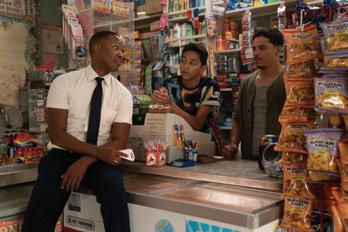
Wednesday, July 28, 2021
5:30 - 7:30 pm, with program at 6 pm City Winery - West Loop (1200 W. Randolph)
Program featuring Chicago Reader senior writers
On the bus I remind myself that today is not yesterday. Change is hard. The sky holds the sun close, it’s ace of spades. Still I feel a slight spark inside my shadow— sun leftover from yesterday? Today it isn’t sunny. The bus moves like a bulldozer through a rainforest, the potholes bounce the bus back up into reality, the bus bounces me back up into reality. Where did the weekend go? Did yesterday even happen? The days creep out of the rainforest like shadow creatures. I try to imagine a place with more back support. I try to think up enough sun to make my own shadow.
Every time I see it, I get scared of my shadow. Maybe because it reminds me that my body exists in reality, maybe because it reminds me that my body exists on sunny days too. I do yoga every today and every yesterday. Repeat the pose, repeat it again; I’m an ace. In shavasana I imagine myself on the floor of the rainforest, actually, I imagine myself as the rainforest itself. Rainforest Sasha. The rain falls. It falls again, a permanent shadow, pouring downhill. My body is one of many acres here, mowed over and regrown. I was given a new reality to root around in, so I try to forget my yesterdays. I want to move on. I want to look away from the sun—
I look down at my hands. For dinner some Sundays we walked from my grandparents’ house to Rainforest Café. I remember those shitty meals it like it was yesterday. I remember the gorilla’s huge, dancing shadow on my little brother’s plate. To him the gorillas were real, soon they would run wild through the mall; his small, scared face!
Hors d’oeuvres, wine, beer, soft drinks included Courtesy of City Winery and Haymarket Beer Company
All funds raised will benefit the Reader’s recently established 501(c)(3) nonprofit: Reader Institute for Community Journalism.
Donations can be made online here: https://tinyurl.com/ReaderLegal or via check made payable to Reader Institute for Community Journalism and mailed to: Chicago Reader, Attn: Chinyere Farr, 2930 S. Michigan Avenue, Suite 102, Chicago, Illinois 60616
Minimum donation: $250 per ticket
Questions? Email tbaim@chicagoreader.com
Now my little brother lends me money sometimes. The shu ed ace and the unshu ed ace! How we fold our memories so the sunny side shows. The way we give in to the slow warp of reality and make a painless version of the past. I was a rainforest. I was going extinct. Reality was something closer to reality’s shadow. I sizzled out. Every day was today and every day was yesterday.
There was an ache inside me, overgrown as a rainforest, but I survived. And it was sunny. And my shadow disappeared. And I pictured my smile, like it was yesterday.
Sasha Debevec-McKenney is a poet. She was born in Hartford, Connecticut.
Poem curated by Xandria Phillips: Xandria Phillips is the author of HULL (Nightboat Books, 2019), and the recipient of a Whiting Award. They have received fellowships from Brown University, Oberlin College, and The Wisconsin Institute for Creative Writing, and are the 20212023 Poetry Fellow at the Center For African American Poetry and Poetics.

A biweekly series curated by the Chicago Reader and sponsored by the Poetry Foundation.






Teen Poetry Labs (Online): July 2021
Participants will read and discuss a wide range of contemporary poems, and receive guidance in the creation of their own work.
Dates for different grades 6–8 and 9–12 in July 2021.
Space is limited & registration is required
Find dates and register at PoetryFoundation.Org/Events

Apop of color in the shape of a Telfar bag has become a common sighting gracing the outfits of stylish Chicagoans. Made by Queens-based Liberian-American designer Telfar Clemens, the vegan leather totes come in three sizes, multiple colors, and fairly affordable prices ($150 to $257). Since the bag, dubbed the “Bushwick Birkin,” quickly sells out, those willing to partake in the trend are advised to subscribe online for a restock alert at shop.telfar.net. Created in 2014, the bag’s minimal and practical design emblazoned with a clever logo appeals to a wide range of tastes—inclusivity is at the core of the brand. According to their team, “It is the first ‘it bag’ where ‘it’ has nothing to do with status”; their slogan is “Not for you—for everyone.”
But apparently that doesn’t apply to Megan Szkatulski’s boyfriend, who had some doubts about the orange Telfar bag his sister gave him on his birthday. “He goes metro sometimes,


and he does carry bags, but this one was a little too much for him, so I stole it,” says Szkatulski. Coming out of a spinning class at the gym, she was serving some serious Yeezy vibes—even though she was very nonchalant about it: “I don’t feel like I have much personal style—I just wear whatever is cute and comfy.”
The 30-year-old data analyst was particularly excited about her Oofos slides, which provide arch support and help her ailing knees.
A similarly casual—yet e ective—approach to fashion is embraced by Jackson Powell, 24. A proponent of a “low-effort/high-impact” style, he was sporting an array of garments he’d just picked up off his floor. “I like to do neutrals with pops of bold colors that don’t necessarily go together,” he says. Jackson mixed a pair of biker shorts by local designer and textile maker Alyx Harch, a shirt he sewed himself, and, of course, a bubblegum pink Telfar bag. v
FOOD FEATURE
Natalie Vu’s Vietnamese snack brand isn’t just for nail techs.
 By MIKE SULA
By MIKE SULA
Natalie Vu will work to find a snack that’s right for you.
“Tell me a little bit about your taste or how you love eating food,” the 23-year-old proprietor of the online snack shop Ăn Vat Cô Béo asked me. “Are you down for something really authentic?”
I’d asked her to help me narrow down a handful of selections from this month’s menu of 128 snacks imported from Saigon, a head-spinning variety of dried fruits, fiery jerkies, spongy pastries, dried and seasoned seafoods, and intensely flavored sheets of rice paper that melt on your tongue and seem to
achieve that magical crispy-chewy equilibrium that is the holy grail of snack makers.
That last category, bánh tráng, has a Proustian appeal for many millennial Vietnamese immigrants. “In Vietnam, we drink milk tea every day at school,” says Vu, who grew up in Saigon before her family emigrated to south-
ern California seven years ago. “We buy the milk tea, we buy the rice paper, stand in front of the school before school starts chatting, hanging, talking. Just milk tea, and the other hand is holding a rice paper bag.”
Vu’s career as a snackist was launched three years ago in San Jose where she worked as a
server in a restaurant and at a milk tea shop. Trying to bolster her tips, she bought rice paper at the market, seasoned it with chili oil in her own kitchen, and sold it to friends.
Not long after that, Vu and her older brother and sister jumped in a car and moved to Chicago without knowing anyone here. “That time was kind of young and wild,” she says. “I arrived downtown. I think, ‘This is my city.’” She quickly found a job at a nail salon but didn’t have many connections, so her snack business went dormant.
But after a year she recognized an untapped market in the city’s Vietnamese-operated nail salons. She’d scoured the online o erings of Saigon snack makers and shipped a load over. Packing a big, black gym bag full of bánh tráng, chicken jerky, and salted fish skin, she began making the rounds of downtown salons. Word spread, and as orders increased, she created her brand. Ăn Vat Cô Béo roughly translates as “Miss Bella Snacks.” She designed her own packaging, website (anvatcobeochicago.com), and Instagram page (@anvatcobeo.chicago), and her logo features a typical street vendor who could be posted up outside any school. Today she moves about 300 pounds a week in online orders, available for shipping, delivery, or pickup.
The large shopping bag full of snacks Vu curated for me didn’t leave my side for days— and neither did my keenly interested dog—as I tried to regulate a consistent intake of chewy dried palm seeds; sweet, hot, and crunchy baby crabs with dried lemon leaves; spicy, sticky dried squid strips; tom yum-flavored beef jerky with mayonnaise; and a sheaf of tom yum-seasoned rice paper squares. This was in addition to an earlier purchase of honeyed kumquats, pork jerky, chicken-lemon-leaf-flavored rice paper, and an LP-sized cake of com chay, crispy puffed rice coated with a caramel-like layer of sweet sticky salted egg and shredded pork.
Vu was furloughed from her nail tech job for three months at the beginning of the pandem-

ic, but her snack business boomed. “People ordered a lot and also gave it to their friends as gifts,” she says. “They kept ordering and referring to new people.”
That’s contrary to the usual snack cycle, which she says slows during the summer when salons are at their busiest. “Techs work opening until close without eating,” she says. “They are busy making money. Just focusing on their jobs.”
Snacking is seasonal in other ways. In the summer, she sells more dried fruit: Thai tamarind pods, plums, and gooseberries to dredge through chili salt; sesame-crusted dried bananas; crispy pumpkin slices; pickled mango. In the winter, her jerky and dried seafood sales go up: crispy fish skin seasoned with creamy salted duck egg; garlic butter-flavored chicken jerky; spicy tangles of dried squid jerky; or fried anchovies with lemon leaves.
Bánh tráng in a multitude of flavors is always appreciated: cheese, seaweed, chicken with lemon leaves, shrimp and mayonnaise, or super spicy beef. She’s continually o ering new things in other categories too: garlic lemon cashews, creamy bear-shaped cakes, crunchy mini crab and shrimp egg rolls.
“I change the menu every month. I am a business-minded person so I always have the idea to do di erent stu .”


The overwhelming majority of Vu’s customers are Vietnamese, including a segment of out-of-towners who seek her out when they visit Chicago. And she ships boxes filled with hundreds of snacks to salon owners across the country who want to keep their employees happy.
She has just a few non-Vietnamese customers and has concerns some of her flavors won’t go over well with the general American palate. So she no longer bothers to post her menu in English, though she will if asked—and she wants to be asked.


Plus she has bigger plans: “I want to open a milk tea-snack shop in the future. But I absolutely will open a nail salon in the next two years first.”
In the meantime, after a successful pop-up at an Argyle street fair earlier this spring, she’s eager to connect to people doing collaborative food events in the alternative economy.
“I want to promote my brand to American people,” she says. “I want them to try how Vietnamese people eat snacks,” she says. “So when you talk about Vietnam, it’s not just about pho.” v
@MikeSulaThe group is reexamining food distribution through a racial equity lens while fighting for long-term systemic change.
 By SHARON HOYER
By SHARON HOYER
“Ithink policy is everything,” said Dr. Angela Odoms-Young, a professor at University of Illinois Chicago who researches environmental and social impacts on diet-related diseases. Odoms-Young is one of two dozen public health experts, food justice advocates, and city o cials who gathered at the beginning of the year to assess how Chicago’s government can serve as a guiding hand in building a more equitable food system. “We tend to think of this as a household issue,” she said. “It’s a community-level issue and a society-level issue. It’s business, it’s infrastructure. In most things we understand that.
For instance, if you drive your car and a bridge is not safe, we think a policy needs to change to make that bridge safe. We expect societal structures are going to make the bridge safe to drive on.”
The lack of food infrastructure in Chicago’s Black communities is a dense knot of problems tied up in poverty, land ownership, job opportunities, and incarceration, tightened over a century of disinvestment and discriminatory policies. It’s a knot that nonprofits, activists, and public officials have been struggling to untangle for years—building urban farms and community gardens with job training
programs, introducing small produce sections into corner stores, providing matching coupons for produce purchased with EBT, even opening a Whole Foods store in Englewood.
But, as Erika Allen, cofounder and CEO of Urban Growers Collective, pointed out, dropping a grocery store in a community doesn’t solve systemic racism. And emergency food programming, public health initiatives, private food enterprises, and city-level policymaking have largely taken place in separate orbits—leaders at food justice nonprofits have enough to do advancing their own programs and keeping their organizations afloat. City
plans for improving food security, however well-intentioned and crafted with input from community members, fizzled with each new administration. “The urban ag people were in their sandbox, we were in our sandbox,” said Nicole Robinson, chief partnership and programs o cer at the Greater Chicago Food Depository, which supplies goods for pantries, soup kitchens, and shelters across Cook County. “It feels like you’re starting over when administrations change. Funding was a challenge. And food access wasn’t important in the larger landscape.”
Then the pandemic struck, blowing the cracks in the system wide open. Movements for racial justice following the murders of Breonna Taylor and George Floyd heightened public awareness of inequity in their own backyards. The response in Chicago was swift and citywide. Mutual aid networks of volunteers moving food from areas of surplus to those of need blossomed; the Love Fridge was born and refrigerators with free food popped up along sidewalks; various food-focused organizations teamed up to do high-volume grocery and meal distribution. Urban Growers Collective redirected their energy from agriculture to emergency distribution, partnering with Black-owned catering company ChiFresh Kitchen, women-owned catering cooperative Las Visionarias, and the Chicago Teachers Union to provide prepared meals for families in need. “We were able to use emergency food grant money to support their businesses,” said Allen. “This is the kind of farm-to-table our community needs. It recirculates dollars. People got to know each other and collaborate. And we were able to deploy some crazy amount of meals.”
The collective efforts of decentralized volunteer groups and larger institutions like the Food Depository had an impact. “You saw news reports of long lines of cars in Texas for food distribution. You didn’t see that here. There’s a reason for that,” Robinson said. Cook County has 450 food pantries, only 35 percent of which have a paid staff person. Robinson said many of the rest are volunteer led. “Some are connected to faith-based organizations, some are connected to grassroots organizations, some are anti-hunger organizations. There are 4,000 volunteers working across the pantries. Many of them are older adults.
These are the heroes and the people who got us through the pandemic. That’s what I think about when I think of the strength of the food system.”
New community partnerships, federal and local government appetite to invest in infrastructure, invigorated social justice movements, and the first city administration to publicly acknowledge the harms of longstanding discrimination and commit to racial equity across policymaking converged, setting the table for cross-sector conversations about food insecurity: A larger table with a place for those affected by inequity, where solutions that take into account the economic, social, environmental, and political forces that shape the food system could take place.
As the Office of Emergency Management, which worked closely with the Food Depository from the start of the pandemic, began winding down in early 2021, Robinson saw the opportunity to carry the energy behind emergency response to long-term structural change. “I went to a trifecta of the mayor’s office, the Department of Public Health, and Family and Support Services and said, ‘Hey, we’ve gotta figure this out. There’s a long road ahead of us. How do we leverage this moment when people care?’ People have an understanding about inequity they haven’t had before. There’s a political will we haven’t had before.”
Juan Sebastian Arias was just a few months into his position as a deputy director of policy in the mayor’s o ce when Robinson approached the city about creating a longterm food security plan. Though relatively green to Chicago politics, Arias was up for the challenge and, along with Robinson and the Chicago Food Policy Action Council, convened a working group to evaluate past food security plans from the city alongside existing roadmaps and strategies from the Food Depository, West Side United, and the Alliance for Health Equity. The group was to make recommendations on improving access and equity in the south and west side communities that su er from disinvestment. And, equally important, propose a durable governing framework to ensure the plan would be carried out by current and future administrations.
Allen, who is also a cofounder of the Chicago Food Policy Advisory Council, noted that it’s “a constellation of things that come together to create the problems. You need the same constellation of things to come together to break those problems. And it has to be done
from the community. If some entity says, ‘Give me all the money because I have the capacity,’ how does the community build their own capacity?”
The advisory group assembled in early 2021 was the first concerted effort by the city to take the entire Chicago food system constellation in view. The group included leaders in community organizations like Austin Coming Together and Enlace Chicago; urban agriculture organizations Grow Greater Englewood and Urban Growers Collective; public health organizations Alliance for Health Equity and the Consortium to Lower Obesity in Chicago Children; public health experts with Alliance for Health Equity and Odoms-Young from UIC; lender/developer Illinois Fresh Food Fund; and a slate of city agencies: Family and Support Services, Planning and Development, Public Health, the Mayor’s Office for People with Disabilities, and Chicago Public Schools. Over a handful of meetings, the group agreed on food system “pillars” to fortify—production, retail, processing and procurement, entrepreneurship, nutrition benefit programs, and emergency systems—and set priorities for the coming year to shore up emergency services and build long-term, equitable food system infrastructure.
One priority area builds on a recent positive step in food policy. In 2017, after three years of work with the Chicago Food Policy Action Council, the city adopted a Good Food Purchasing Program, which set environmental, nutritional, and labor standards for the massive quantities of food purchased by CPS and other institutional buyers. Before then, food supplier contracts for schools and other city agencies went to the lowest bidder that met whatever baseline nutrition criteria are required to receive federal funds. The purchasing policy improved the quality of food served to kids in public schools and has the potential to direct millions of dollars to local farms and food businesses. In 2018, with support from then-commissioner Chuy García, Cook County followed suit, adopting the policy and adding criteria to direct state purchasing to businesses in low-income communities that hire people with prior arrests or prison records. The county policy also includes a provision for county-owned land to go to BIPOC-owned farms and social enterprises.
Rodger Cooley, executive director of the Chicago Food Policy Action Council, said one goal for an emerging council charged with governing food access will be to create real, tangible opportunities for institutional pur-


continued from 9
chasing contracts to be awarded to local BIPOC vendors, suppliers, and farms. “There’s been a lot of work setting the tone and measuring and understanding current purchasing,” he said, “but we’re looking to have some real success. Which means digging into: Are these contracts scaled right? Are they advertised su ciently? Making sure there’s capacity building for these vendors to become M/WBE [certified Minority and Women-Owned Businesses] to take advantage of these opportunities. Seeing how this meets food access goals as well as entrepreneurship goals. As well as moving vacant lot properties off the city roles. How does it connect to workforce development and job opportunities for previously incarcerated folks? And intertwining all these things in a holistic way.”
However, BIPOC farmers, grocers, caterers, and food vendors can’t build facilities, train and hire workers, and secure city and institutional contracts without capital to start or scale up their operations. And funding is near impossible to come by without existing wealth or collateral. “You can get loans, but the interest will be high,” Allen said. “It means those entities have to work twice as hard to service loans. That’s how this stuff is rolled. When you’re playing from behind consistently it’s hard to catch up with your competitors.”
Allen speaks from experience. The former director of Growing Power’s Chicago branch— and daughter of legendary retired NBA player and MacArthur “genius” award-winning Growing Power founder Will Allen—has spent the past ten years raising start-up capital for the Green Era renewable energy campus, an energy facility powered by an anaerobic digester in the Auburn Gresham neighborhood. The facility will train and employ formerly incarcerated people and, when operational, produce 40 cubic yards of compost per day.
Allen says that’s enough compost to convert one vacant lot into a vegetable garden each day. It’s a project that transforms a brownfield site into a generator of clean energy and carbon o sets, directs organic materials from landfills to clean, nutrient-dense growing medium, provides 100 good, local jobs to a vulnerable population, and is led by arguably the biggest name in urban agriculture in the state. Yet raising the $31 million of capital funding to build the digester has taken Allen and her partners a decade.
Immediately after quoting the start-up costs of the Green Era campus, Allen jumped (as anyone advocating for infrastructure
investment learns to do) to the long-term returns in dollars and lives. “If you measure impacts around public safety, property values around food systems—if that entity keeps two neighborhood teens out of prison that’s about $350,000 of taxpayer money,” she said. “It’s a lot cheaper to give people a good job in their neighborhood.”
Adding that value to the economy requires investment up front, and up-front backing for minority-owned enterprises on the south and west sides is, to put it mildly, sparse. In June of 2020, a report commissioned by nonprofit investing fund Benefit Chicago found white entrepreneurs attract 17 times more equity capital than their Black and Latinx counterparts nationwide, and 80 percent of minority entrepreneurs in Chicago can’t secure the capital required for their projects. Arias said part of the emerging city plan is to create a good food fund, modeled after programs like the Michigan Good Food Fund, in which government collaborates with private capital to provide low-cost loans to start up and expand BIPOC-owned food businesses.
Closing the funding gap between white and minority food entrepreneurs will take what Allen and Cooley respectively consider reparational and heroic efforts by government, philanthropy, and private lenders to back enterprises by people who, due to histories of redlining and racist practices, have little to no property, savings, or other collateral assets.
Cooley believes a commitment from the city could be a catalyst for other investors, newly motivated by racial justice movements, to join in. “The city saying, ‘We’re in favor of this and we’re at the table,’ opens the door for others to participate. Lending their approval to it makes a big difference. The city can help facilitate and convene the space, but they don’t have to run it long term.”
Amessier snarl the food equity governance council hopes to comb out is the morass of city departments and shifting requirements applicants must slog through to start an urban farm or community garden. Departments managing land access, water access, zoning, and remediation all play a hand. “The way things are set up now,” Allen said, “you need money and power to even navigate your way through.” She described the Ka aesque nightmare of trying to establish a small garden on the south side for people with chronic physical illnesses to socialize, learn to grow food, and meet with their caregivers. Though backed by the mayor’s o ce, the proj-
ect ran into a wall with the city securing access to an empty lot, and then stalled in inconsistent requirements about how to set up the space. “It’s like you’re almost being taunted,” Allen said through welling tears of anger and frustration. “The way folks in departments behaved toward community members. The anger and pain is unacceptable.”
Bureaucratic roadblocks that delay or halt projects led by a long-time, prominent farmer and advocate are all but unnavigable for newcomers without City Hall connections who are inexperienced at jumping through administrative hoops. Cooley said the mess of hurdles put up by city departments to new farms and gardens comes from an entrenched culture that doesn’t understand the value of gardens and obsesses over potential litigation. “One of the things that needs to happen is a cultural shift to say, ‘This is an appropriate and priority use for land if the community wants it, and we need to direct our resources to make sure that happens,’” he said, “rather than reserving land for a massive housing development sometime in the future, or retail corridors or industry exclusively. A lot of departments have taken on this attitude of protecting the perceived liability of the city as almost a corporate entity, rather than the city of and for the people who live here. It’s a bit of an antagonistic attitude. It creates a lot of burden on community partners who don’t have the lawyers, the money, the time to navigate those really complex processes.”
“It aligns with how institutional racism operates,” Allen said. “With non-clarity. You have to know someone.”
One of the priority areas for the Food Equity Governing Council will be removing barriers to urban farming. But Arias said he considered a lack of departmental cohesion to be the biggest hurdle for the city’s emerging food equity plan. “The current approach the city has—at large and in its approach to food—is so decentralized. Every department touches the overall food system. The need is for coordination and alignment around a common goal. And wanting to keep the values of equity and justice core to this work is also a growing muscle.”
Other priorities from the advisory group reveal areas where policy alone isn’t enough— notably, to “market and maximize nutrition programs and benefits.” Last year, at the height of the pandemic, with record unemployment and emergency food distributors working at full capacity, Illinois lost $80 million of federal SNAP funding due to a short-
fall of eligible people enrolling for benefits. Robinson said the council would look at how to simplify and facilitate the SNAP application process.
And then there’s the social stigma of using the safety nets designed to keep citizens on stable ground. Everyone’s tax dollars contribute to nutrition programs that are available to anyone in a time of need—like a global pandemic—yet the word “entitlement” is almost universally uttered with disdain. Odoms-Young mentioned an older friend who is eligible for SNAP but reluctant to enroll.
“It goes along with the stigma of ‘that family needs food assistance.’ No! Our city needs food assistance, our state needs food assistance. That’s money that could be spent at retailers in our state. They call SNAP the great multiplier because the money goes into businesses. If we need it, we can get it. Most of us think we’ll never need it.” Advocates are working at a grassroots level to get friends and neighbors involved in encouraging and helping eligible people sign up for SNAP benefits.
These priorities—eliminating zoning barriers to food pantries, making the most of nutrition programs like SNAP and WIC, providing access to capital for BIPOC food businesses, eliminating barriers to urban farming, and increasing purchasing from BIPOC growers and producers for institutional contracts—will take years of coordinated e ort between numerous city agencies, partner organizations, and community advocates to come to fruition. To keep this big-picture, foundational work from winding up on the shelf when the city administration turns over, Arias and advisory group members are investigating how to make the food policy governing council a permanent fixture before the next mayoral election. The mayor’s o ce created a sta position to steward the food policy work and coordinate the council, but a governing body to set policy, monitor and evaluate outcomes, and adjust accordingly must be codified for the long-term, cross-agency work to continue.
Everyone I spoke with was optimistic—if cautiously—about the process thus far and the future of a food equity governing council, coordinated at the city level. Cooley said the city had not made this level of commitment on paper and invested this much time and energy in equitable food policy in his 20 years of food advocacy. Robinson said that the food system is at the highest level of collaboration she’s seen. “I think this is unprecedented,” she said. “It’s a bold experiment and I’m very optimistic.” v

















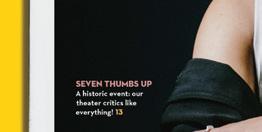

 By MEGAN KIRBY
By MEGAN KIRBY


For ages eternal, the sign in the window of the Montrose Avenue Culver’s read “Coming Soon.” Every time I got off at that Brown Line stop, the false promise taunted me. Time must move differently for frozen custard magnates than it does for mere mortals.
Finally, it was announced: The new Culver’s location would open May 31, 2021—oh glorious day! I planned to show up to the celebration to learn the flavor of the day, but my heart harbored a bigger wish. I wanted to meet Scoopie.


Do you know Scoopie? He’s the Culver’s mascot, a sentient custard cone with a dull grin and no discernible personality. Other fast food mascots at least hint at interior lives.

Ronald McDonald has an impish, winking approach. The Burger King is a noted pervert. But Scoopie is a blank slate, a creamy canvas to project our own desires. His blank eyes reveal nothing. No thoughts. Just custard. Will I ever know a peace like that?



To grow up in the midwest is to hold Culver’s in the highest regard. The Wisconsin-born fast food joint has now spread to 25 states, but it still feels like it belongs to us.
When I first visited Culver’s on a Wisconsin Dells road trip in the late 90s, it blew my childsized mind. I considered fast food brands as timeless entities we were born alongside, like folk songs, or income inequality. What a thrill,








to find a fresh-faced restaurant that specialized in ButterBurgers, cheese curds, and frozen custard—a staunch midwestern insistence that you should have dairy in your entrée, side, and dessert.



Until now, there were only two Culver’s locations in the city limits. From my north side apartment, both required CTA transfers. Over the years, I’ve grown skilled at tagging along on suburban car rides and cajoling my way into a Culver’s drive-thru. A highlight of any road trip became scanning the exits for that blessed blue oval—a dangerous gamble for a 31-year-old who refuses to take a Lactaid.
The new location would be walking distance from my apartment. I immediately texted my siblings to coordinate an opening day meetup. Family should stick together on historic days.
And I began fantasizing about meeting Scoopie. Maybe he would be cavorting out front, beckoning customers inside. Maybe Lori Lightfoot would show up and they would wield a giant pair of scissors together to cut the ceremonial ribbon. Whatever the case, he would surely take a photo with me, his biggest fan.
A confession: I’ve got a thing for fast food mascots. A framed Arby’s Oven Mitt hangs above my stove. A Hamburglar Halloween mask is tacked to my wall. Last winter, stoned on painkillers after a broken ankle surgery, I photoshopped myself in a series of pictures with Scoopie. They performed shockingly well on my Instagram story.
But when I checked the Culver’s website for any info on opening day festivities, I made a shocking discovery. Scoopie seems to be disappearing from their online presence. Instead, I found a punk-ass, glasses-wearing cheese curd named Curdis. (Ew.) Curdis keeps a blog on the Culver’s website, and even though it

hasn’t been updated since 2019, I do consider him my professional rival.










In my alarm, I shot an inquiry out to the Culver’s corporate e-mail: “Will Scoopie attend the opening of the new Chicago location?” No response arrived.


Culver’s was born in 1984 in Sauk City, Wisconsin. The town is also the birthplace of August Derleth, publisher of H.P. Lovecraft and frequent contributor to the Cthulhu mythos. Scoopie fits firmly in my own midwestern mythology, but this information hinted at something more monstrous: a dripping dairy being with human eyes and grin. Maybe Scoopie got too strong.
Nevertheless, when the 31st arrived, I held out hope. But when we arrived at the youngest Culver’s in the world, there was very little fanfare. No cheers, no champagne, not even a very long line at the takeout window. The framed photos on the walls pictured barns shining bright under the Wisconsin sun.

“There he is!” my brother said, and I whirled around, expecting to see Scoopie ambling out of the back room with his skinny arms held out to me. But no, it was just a Scoopie plushie in a glass case, limp and lifeless.

As I grabbed my patty melt and chocolate malt to go eat in the park, I thought about how things always change. Jobs change. Seasons change. Sometimes a city has two Culver’s, and then it has three. Sometimes an aging human body can no longer handle an obscene amount of dairy—though it is brave to try.
But I felt the truth spread through me, as warm and viscous as butter spreading over a burger bun. Scoopie can never die. Because he lives forever in my heart. v
When I heard the latest news about my not-so-beloved Chicago Bears, I thought I’d left the real world and entered the realm of some drug-induced fantasy. Have the bumbling boobs who run the Bears turned into Gordon Gekko—you know, a superslick operator who hustles fools into paying his obligations?
Oh, if only the Bears could be so cunning when it came to putting together a winning football team.
Let’s break it down. On Thursday, Ted Phillips—the front man for the McCaskey family that owns the Bears—issued the following statement:
“We recently submitted a bid to purchase the Arlington International Racecourse property. It’s our obligation to explore every possible option to ensure we’re doing what’s best for our organization and its future. If selected, this step allows us to further evaluate the property and its potential.”
Before we go further, let me say this: I don’t believe there’s any way the Bears themselves will actually pay out of their own pocket to buy the racetrack.
I say this not out of malice, but as a fan who’s followed the Bears since the 60s. If there’s one thing we know about the Bears, it’s that they’re cheap. Really cheap—as any current or former Bears player can tell you.
About Bears leadership Mike Ditka once
said: “He tosses nickels around like manhole covers.”
Specifically, Ditka was alluding to Papa Bear, George Halas, the team’s founder. But the wisecrack applies to Halas’s descendants who now own the team. It may be the only thing on which Ditka—who was MAGA before it even existed—and I agree.
Consider the case of Dick Butkus—one of the greatest Bears players ever. In 1974, Butkus sued the team because they cut him after he damaged his knee. The guy risked life and limb to play for the Bears, and those cheapskates wouldn’t even pay his medical bills.
That’s cheap. And coldhearted.
So, yes, I’m confident when I say there’s no way that the Bears will pay for that racetrack with their money.
Instead, I believe it’s a ploy. They’re either hoping that Arlington Heights sweetens the deal with a handout—most likely a TIF handout. Yes, they have tax increment financing in Arlington Heights. Which means property taxes would be diverted from Arlington Heights schools.
Or they’re hoping Mayor Lightfoot panics and throws money at the team rather than go down in history as the mayor who let the Bears leave Chicago.
It’s a straight-up power play—“the ol’ squeeze play,” as Ralph Kramden might call it. Looking to ignite a bidding war between
Chicago and Arlington Heights.
Here’s hoping that Mayor Lightfoot and Arlington Heights mayor Tom Hayes are too smart to fall for it.
At the moment, Mayor Lightfoot is showing common sense—reminding the Bears they have a lease through 2033. So shut up and play football.
Mayor Hayes, in contrast, is probably just a little too giddy. “We welcome the Chicago Bears’ interest in the Arlington Park site,” Hayes said in a statement. “It is a one-of-akind location, and we are glad that the Bears ownership sees its tremendous potential.”
Look, Arlington Heights, I can’t help you with this one. I’ve got enough problems trying to keep Chicago’s mayors from handing out billions in property tax dollars to gentrifying developers.
At the moment, the Bears have a lease to play at Soldier Field until 2033.

But apparently, they don’t like Soldier Field. It doesn’t have enough seats. Or a retractable roof. Or who knows what else—the Bears are always crying about something.
It’s kind of tacky for the Bears to trash Soldier Field. It was only about 20 years ago that Mayor Daley moved heaven and earth to round up the money to renovate the stadium in order to keep the Bears happy.
Back then, Daley and the Bears said it would only cost the public about $360 million to
fix the stadium. To be paid with hotel-motel taxes. But don’t worry—the people who pay hotel-motel taxes are probably out-of-towners. Think of it, Chicago, as free money.
Ignoring that if the city spends hotel-motel taxes on the Bears, they can’t spend it on things like schools or police or pensions, etc.
Meaning we pay more in fines, fees, and property taxes to compensate for the hotel-motel taxes the city is spending on the Bears.
Last I looked, the public cost of rebuilding Soldier Field was closing in on $1.2 billion, according to the Tribune
Also, while I’m at it: to rebuild Soldier Field, the city had to demolish the buildings that housed the Chicago Park District’s central headquarters.
That meant moving the headquarters to a building in Streeterville—that cost another $22 million.
Word of warning, Arlington Heights. Don’t believe the press releases when it comes to how much it costs to satisfy the Bears.
And what have the Bears done to show their appreciation to Chicago’s taxpayers for giving them all that money?
They’ve sucked. That’s what they’ve done.
The Bears haven’t won a Super Bowl since 1986. They haven’t been in a Super Bowl since 2007. They’re so bad at judging quarterback talent they traded up to draft Mitch Trubisky over Patrick Mahomes.
Taking Trubisky over Mahomes is like taking me over Michael Jordan to play on your pickup basketball team. OK, maybe not that bad. But you get the idea.
Let me close by quoting Rick Morrissey, sports columnist for the Chicago Sun-Times.
“If the Bears want to move to Arlington Heights, they should go,” Morrissey recently wrote. “It would be one more thing not to like about an increasingly unlikable franchise.”
Well said, Rick!
Hey, Bears, is Soldier Field not good enough for you? Go to Arlington Heights. Or Anchorage, Alaska. Or Antarctica. It’s all the same to me.
Find some other suckers to subsidize your mediocrity. Chicago’s got more pressing needs to take care of. v

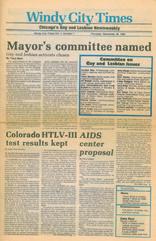






Q:Thanks for taking the time to share your expertise. Can you tell readers a bit about who you are and your background in expungement and record-sealing?
Beth Johnson: The pleasure is mine! My experience in expungement and sealing began when I was a law student intern at Cabrini Green Legal Aid (CGLA). In 2005, CGLA hired me as the Expungement Help Desk Coordinator. I worked at CGLA through 2019 as the Criminal Records Program Director, the Legal Director, and the Senior Policy Advisor. My entire legal career has been in the area of criminal records relief: expungement and sealing, pardons, certificates, waivers, and all other legal remedies from a past arrest or conviction. I’ve had the privilege of not just providing representation, but working in Springfield for nearly ten years alongside coalition partners to make our laws better and more accessible and to remove the barriers caused by criminal records. In 2019, I and two partners opened our own firm, the Rights & Restoration Law Group.
Q: We’ve learned that New Leaf is an important first step in this process. What is New Leaf?

Beth: New Leaf Illinois is a statewide network of legal aid and advocacy organizations with one purpose: help people access the new cannabis expungement remedies that came with the legalization bill and provide legal representation for free when eligible. The purpose of having expungement remedies built into the cannabis legalization bill was to allow people previously prosecuted for something that is now legal to remove records from public view so they no longer have barriers to employment, housing, education, or other life opportunities. New Leaf Illinois is an example of the State of Illinois not just passing legislation intended to help, but actually funding the services! State funding was appropriated to the Illinois Equal Justice Foundation (IEJF) to distribute to nonprofit organizations that provide legal services so people know about the laws, the remedies, and where to go to get help. IEJF has distributed state funding for legal aid for the last 20 years in Illinois, and this was a natural extension of the work for this important form of relief.
Q: Who does New Leaf help? Does it include people who don’t have a cannabis record?
Beth: New Leaf is there to help anyone with an Illinois cannabis conviction or arrest navigate and access the expungement process. The process and eligibility can be confusing, and the goal of the coordinated network is to have one place for people to work through the initial steps. New Leaf recognizes people can come with other arrests and convictions— and the legal aid organizations that are part of New Leaf can help with expungement and sealing of other records.
Q: What does the New Leaf aid process look like from start to finish?
Beth: The process starts with registering at newleafillinois.org or calling 855-963-9532. It’s a one-minute registration process, where a person provides their basic information and identifies what county they had an arrest or conviction for cannabis in. With that information, research is conducted and eligibility for relief is determined. Typically, within two days that person is contacted for a legal consultation. If eligible to vacate and expunge their cannabis conviction, and if individuals fall below a certain maximum income, they will be referred to a legal aid organization for representation in court—no matter what county in Illinois they live in.
Q: What are some common reasons that people don’t pursue help?
Beth: People often seek assistance after being denied an opportunity: a job o er that is rescinded, a rental apartment that is denied, an educational opportunity that is no longer available. Many people believe that when an arrest or conviction is older, it automatically goes away. Unfortunately, that is not true, and it requires a person to take action by filing in court. People also don’t always know where to start. One of the beautiful things about New Leaf Illinois is that there is one starting point—you don’t need to figure out where to go or what to do, the network is there to support you.
Q: Are there any other FAQs or common misconceptions you’d like to clarify for our readers?








Beth: People may have heard the news that half a million records have been expunged, not realizing the limitations of the automatic part of the law. Unfortunately, those half a million records were law enforcement records, not court records that are still viewable by employers, landlords, and all other agencies running background checks. And the automatic part only deals with non-convictions. The best course of action is to contact New Leaf to find out for sure what your next steps are. People also think if they have other arrests or convictions, why deal with a cannabis case? Again, if a person has other records, New Leaf organizations will address the cannabis and other incidents on a person’s record.

Dr. Charles Smith and other artists find a new home at the Art Preserve.
By DEANNA ISAACSBefore Black Lives Matter was a movement, Black lives mattered in the work of Dr. Charles Smith. A Vietnam vet and prodigious self-taught artist, he’s spent decades recreating the Black American experience in figurative sculpture, from the time of the slave ships to Harriet Tubman, MLK, and beyond.

The fact that, for a long time, people either weren’t interested or dismissed him as “crazy” didn’t diminish his output. He was on
a mission.
“Dr.” Smith (he gave himself the title), now lives in Louisiana, where he was born. But in 1999, when I interviewed him for the Reader, he was living in Aurora, Illinois, where his sculptures had spilled out of his modest home and were densely populating a sizable yard.
“The yard gradually became his museum,” I wrote, “thronged with hundreds of prisoners, runaways, and martyrs,” each face “unique and expressive,” every piece with its own
story.
This was the African American Heritage Museum and Black Veterans Archive, a drive-by, walk-through, sculptural history installation—free to all, and likely as not to be narrated in person by its creator.
“God said, ‘Use art. I give you a weapon,’” Smith told me then.
This story stuck with me over the years, in part because I made a colossal mistake in it, misidentifying Smith’s medium, which he has never exactly revealed. (He’ll now say only it’s a “masonry mix,” secret as the recipe for Coca-Cola.) But also because I found his figures so intellectually engaging I photographed them myself and the Reader published my photos.
So it was disturbing, earlier this year, to hear that Smith’s Aurora home/museum had fallen into disrepair and was being bulldozed. But, as it turns out, not as unfortunate as it might have been: in 2000, the Sheboygan, Wisconsin-based Kohler Foundation purchased approximately 500 of Smith’s Aurora pieces. About half of them were distributed to museums all over the country, and more than 200 went to Sheboygan’s John Michael Kohler Art Center, which will feature them—along with “immersive” exhibits of work by other artists—at its new outpost, the Art Preserve, opening June 26. (It’s free, but reservations required at jmkac.org.)
It’s a good reason to pile in the car and head north for a day trip or a weekend.
The Art Preserve is housed in a new, 56,000-square-foot, $35-million building whose most striking external features are the stacks of towering timbers, like so many pick-up sticks, that shade its large windows. Designed by Denver architectural firm Tres Birds, the three-story facility sits on 38 acres of former farmland about two-and-a-half miles from downtown Sheboygan (and, depending on tra c, two-and-a-half hours from downtown Chicago). It was the culminating project of Ruth DeYoung Kohler II, who died last November at the age of 79.
Granddaughter of the Kohler Company founder that the Art Center’s named for, and daughter of the former Chicago Tribune “women’s” editor that she was named for,
Kohler II was the Art Center’s director from 1972 to 2016. She was responsible for the Center’s strong reputation as an institution focused on folk and self-taught artists and, with her brother, Kohler Co. board chair Herbert V. Kohler Jr., launched a residency program that has had hundreds of artists collaborating with the company’s plumbing fixture artisans since 1974. The Art Center’s bathrooms are perennial winners in world’s best public toilet listings, and a highlight of that museum.
Artist-designed washrooms (including one by SAIC professor Michelle Grabner) are also a not-to-be-missed highlight of the new museum, where they fit neatly into the Preserve’s focus on artist-built environments. Rather than the usual cherry-picked collection of a piece or two by many artists (often the same artists, no matter the museum), the preserve has collected many pieces from a smaller number of artists, all distinctive for creating their own “visionary” worlds.
Many of these artists were unrecognized by the larger art world during their lifetimes, and most of the environments they created occupied their own living quarters, some of which have been moved to or partially rebuilt at the Art Preserve: they include the glitter-encrusted, Mississippi home of Rhinestone Cowboy Loy Bowlin; the Nebraska shed that houses the kinetic conglomeration of wire, foil, minerals, and what-have-you that constitutes Emery Blagdon’s The Healing Machine; and a reproduction of part of the Chicago apartment of longtime SAIC teacher and artist Ray Yoshida, brimming with his wide-ranging collection of folk, pop, indigenous, and other work. The Art Center owns 2,600 pieces from Yoshida’s collection, and 6,000 objects from the estate of Milwaukee-area multigenre artist Eugene Von Bruenchenhein. The idea throughout: the whole is more than the sum of the parts. It’s a curatorial mission no less obsessive than the work it collects.
When I visited, Dr. Smith’s people were lined up on metal storage racks on the third floor. Curator Laura Bickford told me they’ll be installed according to Smith’s directions when he comes to the museum in the fall. That should be worth a return trip.
Meanwhile, Smith told me by phone, he’s working on a second African American Heritage Museum and Black Veterans Archive in Hammond, Louisiana, where he’s also welcoming visitors, hoping to impress them with a history that’s still not well enough known.
@DeannaIsaacsWe are excited to fully reopen our most interactive exhibits geared towards younger visitors. Be sure to see these exhibitions when you visit the Museum!


Take a Stand Center
Interactive galleries guide visitors through social justice issues, empowering them with knowledge and inspiration while reminding them to stand against hatred in all its forms.
Make a Di erence! The Harvey L. Miller Family Youth Exhibition
Make a Di erence! features fun, hands-on activities that empower young visitors ages 8-13 to use their voices and make choices to stand up for themselves and others.
Due to the closing of this iconic institution, after 61-years St. Joseph High School will auction all its educational equipment, athletic equip., trophies & memorabilia, and furniture located at its Westchester, Illinois campus. St. Joe’s has been known for excellence in academics, and for one of the most successful basketball and soccer programs in the State of Illinois.
AS FEATURED IN THE 1994 DOCUMENTARY FILM, “HOOP DREAMS”.
LOTS BEGIN TO CLOSE: July 14th & 15th at 9:00am CST Each Day
LOCATION: 10900 W. Cermak Road Westchester, IL 60154
INSPECTION: By Appt. Only. Call Brian Clettenberg at 847.729.3380 or brianc@winternitz.com
FEATURING: Athletic Equipment, Championship Trophies, Plaques & Banners, Jerseys, Furniture, Music & Theater Dept’s, Science Dept., Cafeteria & Kitchen, Large Quantity of Memorabilia & Collectables, Computers, Audio/Visual Equip., Something for Everyone!!!


Winternitz Industrial Auctioneers & Appraisers
For More Information Contact: Charlie Winternitz, 847.272.0440 or charlie@winternitz.com
Visit Our Website: www.winternitz.com
Iwas startled when I saw the news come up on my Twitter feed. A young American journalist in Myanmar had been detained and was likely being held in the country’s Insein Prison, notorious for incarcerating political dissidents, infamous for reports of its horrendous human rights violations. I read the story and instantly recognized the journalist. Danny Fenster. Danny is a former student of mine whom I met at Columbia College Chicago in 2009.
I have been a creative writing professor for 16 years. In this time, I have taught hundreds and hundreds of eager creative dreamers, young idealists, experimental upstarts, wild talents, and overachievers on hyperdrive. And, yes, I’ve also taught apathetic slackers just looking to crawl across the finish line, diploma in hand, hoping to appease Mom and Dad. It’s impossible to remember every single student from every class, every semester, every year. But I remember Danny Fenster well.
Danny took my creative nonfiction course in the summer of 2009, the year he graduated from Columbia. There is always something special about a summer class. The enrollment is smaller, which a ords more time for individualized instruction. The students who take summer classes are usually motivated to graduate, and work diligently to rack up the necessary credits. The sun and the heat shimmer over the city outside the windows (at least at Columbia’s urban campus), while a small group of summer writers sit in the shade of the air-conditioned classrooms crafting stories, and fi nding a bond and connection. Danny’s class was no di erent.
Danny Fenster was from Huntington Woods, Michigan, a suburb outside of Detroit. He was a journalism major taking my course within the creative writing program. We wrote essays, criticism, rants, memoir chapters, and personal narratives. We also read a wide range of published creative non-
fiction books and excerpts. Danny was totally engaged in the class.
He was a lanky young guy, bespectacled, with a tousle of choppy brown hair often covered by a hat. He made an impression immediately. Danny was eager, curious, energetic, empathetic, funny, humble, and willing to approach the craft of nonfiction writing in new ways. Good writers are lifelong learners. That was Danny Fenster. No instructor forgets a student with these attributes.
Danny worked for a number of media outlets after graduating from Columbia and, three years ago, his career path led him to Myanmar. Since August 2020, he has worked for the independent news magazine Frontier Myanmar as its managing editor. He lives in the city of Yangon with his wife.
In February, Myanmar went through a violent military coup, and the new regime detained democratically elected leaders and clamped down on journalists and news organizations. Mass protests ensued, with reports of hundreds of civilians killed and thousands imprisoned. It is this unlawful overthrow of a democratically elected government that former Trump National Security Advisor Michael Flynn recently endorsed, stating, “. . . it should happen here.”
On Monday, May 24, Danny entered the Yangon International Airport. He had planned to fly home to Michigan to surprise his family, but before he could board the plane he was detained by authorities.
“Danny is like a tumbleweed,” said Danny’s brother, Bryan Fenster, by telephone from his home in Huntington Woods. “He travels with a backpack and that’s pretty much it. He made it all the way through security, made it all the way to the gate, had his PPE on—I guess they require everyone to wear a full gown and everything—and was minutes from boarding the plane and I think they tapped him on the shoulder and said, ‘Come with us.’”
Since Danny’s arrest, Bryan has completely
recalibrated his life as a father of two and an owner of a video production business to focus full-time on securing his brother’s safe release. “I believe that international law states that within 72 hours, an embassy needs access to their national,” said Bryan. “But there has been no contact.”
Bryan Fenster has worked closely alongside his local representative Congressman Andy Levin. “He has basically become an extension of our family at this point, we talk that much.” He also adds that the State Department has been working diligently and they are communicating by Zoom sometimes multiple times per day. He has confidence that our government is doing everything it possibly can to secure his brother’s safe release.
Bryan has launched a website to help raise awareness, and organized and promoted a MoveOn.org petition, which has tens of thousands of signatures of support.
But still, Bryan waits. He waits for some contact, some word about his brother.
Danny Fenster is, of course, emblematic of a much larger, more ominous trend. The assault on a free press and the silencing of truth. In the summer of ’09, when Danny took my class, we talked about the late American author Ray Bradbury. I am Bradbury’s longtime authorized biographer. He wrote, of course, many works across literature and media, but he’s best known for his 1953 novel Fahrenheit 451, a science fiction musing on totalitarianism, fascist rule, and the proliferation of technology in our lives and its anti-intellectual implications.
There is no doubt, the current war on journalism is real and marching forward. According to the Committee to Protect Journalists, an international nonprofit that defends the rights of journalists to safely report the news without fear of reprisal, there were 274 journalists imprisoned worldwide in 2020. CPJ also reports that at least 40 journalists have
been detained in Myanmar since the coup took place.
On March 9, Nathan Maung, another American journalist, was detained in Myanmar and transferred to Insein Prison, where Danny is thought to be held. Unlike Danny, Nathan was formally charged with a crime (the dissemination of information or “fake news,” a charge the military has used to target the press) and his condition and whereabouts were, at the very least, confi rmed. And then, in an unexpected twist, on June 14, the charges were dropped, Nathan was released and deported to the United States. This news gives hope to the Fenster family, and is hopefully a harbinger of good news for Danny.
Even so, if all of this sounds precariously close to a dystopian novel, frankly, we are already living it, folks. This is Fahrenheit 451
Just look at the rash of recent, profoundly troubling incidents and assaults on press freedoms around the world, and on journalists like Danny Fenster. And to all this, add the dizzying and intentional “fake news” accusations buzzing about as a means to confuse and befuddle the consumers of news—all of us. This is all directly from the fascist playbook: A Belarus fi ghter jet forcing an Irish passenger jet to divert and land in order to remove a dissident journalist; a Los Angeles Times freelancer being detained and strip-searched (notes, recorder, and phone confi scated) in Minnesota for covering a protest against the construction of an oil pipeline; a Russian freelance reporter for Radio Free Europe beaten by unidentified masked men; Nigerian authorities outlawing the use of Twitter. This is all intended as a way to intimidate and silence those who dare speak truth to power. This is why Danny Fenster is now enduring a dystopian nightmare. He delivers truth and he must be released, now
I’m grateful for that summer, in 2009, at Columbia College, when my path crossed with Danny Fenster’s. I’m proud of the journalist he became, working to illuminate truth in a time where many hope to douse the light.
Ray Bradbury used to tell me often, “Without the truth, without education, our citizens will be uninformed and can no longer participate in democracy.”
It seems this would be the goal of many. v
@Sam__WellerThe detainment of journalist and Columbia College graduate Danny Fenster in Myanmar is a detriment to free speech everywhere.










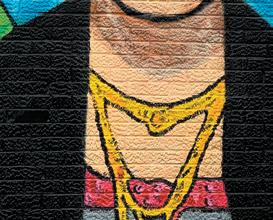



As Illinois prisons accelerated releases during the pandemic, many were forced into crowded, unmonitored residential reentry centers across Cook County.
By MICHAEL MURNEYWillie Jones clutched his chest and gasped for air. Alone in his bed in one of Elite Houses of Sober Living’s facilities just south of Chicago, Jones, 56, dragged himself into the house’s common area. There he collapsed to the floor, clinging to consciousness.
Days before in early February 2021, a fellow resident—whom the Illinois Department of Corrections (IDOC) had referred to Elite following his release from prison earlier that week—began to cough incessantly. Jones urged him to tell staff and alert the on-call medical team.
After nearly 30 years struggling with heroin addiction, Jones grapples daily with congestive heart failure, hepatitis C, and chronic pneumonia from weakened lungs. He knew these conditions put him at greater risk of serious illness or death if he contracted
the virus, which he had tried to explain to all Elite newcomers since the pandemic started.
“I always tell all the guys, every time they get here, ‘I’m sick, I got a bad heart, I got diabetes, so if you got the virus, you gotta do something, you gotta talk.’ Because I’ll be the fi rst one to die up in here,” said Jones. His housemate refused to tell staff or self-quarantine, despite Jones’s appeals. Hoping to avoid a confl ict, Jones stayed quiet and remained at Elite, not wanting to risk his hard-won sobriety—and unsure of where else he would go. Meanwhile, his housemate was allowed to move throughout the facility unquarantined and untested for several days. When the virus spread from his housemate to Jones earlier this year, its course was swift. He began to cough in the afternoon, and by that night, he said, each breath was a battle.
Jones and almost all residents of Elite’s six facilities in the Chicagoland area were previously incarcerated in an Illinois state prison before arriving at Elite.
A Reader analysis of documents obtained through public records requests found that Elite Houses of Sober Living is one of 23 companies contracted by the IDOC to operate at least 96 residential reentry centers across Illinois. Unlike Illinois’s four adult transitional centers, reentry centers are not subject to oversight by any federal, state, or local authority.
Like Jones’s housemate, many reentry center residents arrive at their assigned facilities directly from prison, on referral from the IDOC. Others, like Jones, reside there voluntarily.
Those referred to reentry centers by the IDOC are forced to live there as a condition of their parole. Though nearly all Illinois
reentry vendors operate under tax-exempt nonprofit status as inpatient sober living facilities, many of their formerly incarcerated residents have no documented history of substance abuse.

“Legally, you just have to have some address where IDOC can verify and fi nd you, in order to make it out the door,” said Phillip Whittington, corrections policy analyst at the John Howard Association, an Illinois prison watchdog group. “The vast majority of people being released, quite frankly, just have nowhere else to go,” he said.
The Reader ’s investigation found that the IDOC’s accelerated parole releases during the pandemic are straining reentry centers’ virus prevention and screening resources, and in some cases replicating the crowded conditions most conducive to viral transmission. Meanwhile, since the pandemic began, the IDOC has funneled more than $18 million in taxpayer dollars to reentry contractors. Neither the IDOC nor the Illinois Department of Human Services has installed any mechanisms for monitoring conditions in the facilities they operate, nor for documenting COVID-19 cases among their residents.
“The IDOC doesn’t consider these folks their responsibility after they leave prison,” said Whittington. “Reentry vendors are doing a job no one wants to do, and doing it relatively cheaply. So everyone’s happy to let them go unmonitored.”
When two of his housemates found him gasping for air on the floor of Elite’s common area, Willie Jones was close to death. With the last of his remaining strength, he wheezed, “You, carry me out the door. You, call the ambulance. I’m about to die up in here.”
When his younger sister became pregnant in 1982, Jones, then 18, started searching for a way to pay for the new expenses a baby was sure to bring. “I couldn’t find a job, so I started selling drugs,” he said. Jones recounts his past in rapid, dispassionate sentences.
He began selling marijuana and cocaine
in and around the Robert Taylor Homes, one of Chicago’s since-demolished public housing projects on the south side, where he lived with his grandmother and two younger sisters.
That same year, President Ronald Reagan declared a renewed “War on Drugs,” launching a suite of federal programs designed to enhance policing and levy harsh penalties on drug users and dealers.
The Corrections Corporation of America and GEO Group—America’s two largest private prison and reentry services companies to date—were both founded in the two years that followed Reagan’s declaration, initiating the rise of privatized penal institutions as a core component of U.S. carceral governance. Both companies now make around $2 billion in revenue annually.
By the time his niece was born in 1983, Jones had graduated to selling heroin. He also began using it to cope with the repeated traumas endemic to selling drugs to survive.
“We brutalized our bodies out there,” he said. “Then heroin took all that pain away.”
He continued to sell and use heroin for the next three years, until he was arrested and charged with felony drug possession in 1985. Jones spent most of the next eight years in state prisons, where heroin was still easy to fi nd, he said.
Meanwhile, private capital’s infi ltration of the penal system progressed, and Congress passed a series of draconian sentencing laws, lengthening mandatory minimums and establishing mandatory life sentences without parole for third-time felony o enders.
The prison population exploded as a result, rising from 50,000 in 1980 to 400,000 by 1997. Black and Latinx men were incarcerated at rates several times higher than their white counterparts. Private prisons and reentry services, meanwhile, ballooned in tandem.
When Jones was released in 1993, he was determined to get sober. He found a job at a Harold’s Chicken Shack on the south side. He found an apartment he could a ord nearby, then fell in love, and soon moved into a new apartment in Englewood with his first girlfriend.
Jones’s girlfriend was also in recovery from heroin addiction. For nearly two years, they worked together to keep each other sober. But when she relapsed in 1995, Jones soon found himself using alongside her.
“Someone can have years of sobriety, then see a cue and just instantly start again,” said
Dr. Daniel Fridberg, a professor of psychiatry at the University of Chicago. “We know that objects like drug paraphernalia are powerful cues.”
For Jones, his exposure to his girlfriend’s use sparked a slide back into addiction. For the next two decades, his life, he said, revolved around heroin. “I was staying in the streets, running around, hurting myself over and over. Then using took that pain away,” said Jones.
The prospect of another stint in prison motivated Jones’s recommitment to sobriety in 2013. After narrowly avoiding another arrest for heroin possession, “I just told myself, ‘No more, I gotta do this,’” he said. Jones checked himself into Elite Houses of Sober Living’s Chicago Heights facility a few months later.
After residing there and maintaining his sobriety for three years, Jones became the facility’s “house manager,” receiving room and board in exchange for onboarding new arrivals and keeping Elite’s owner apprised of any problems between residents. By the time the pandemic began in March 2020, Jones had lived and worked at Elite for nearly eight years. As Jones battled addiction and homelessness during the mid- to late 2000s, political tides were shifting away from tough-on-crime policies.
“In the last 20 years there’s been a bunch of political appetite for reducing our rates of incarceration . . . and politicians on the left and the right are picking up on that,” said Wanda Bertram, communications strategist at the Prison Policy Initiative.
Nonetheless, Bertram explained, neither progressives nor conservatives demonstrated concurrent appetites for risking elections on bold criminal justice reforms. “What we’ve been seeing as a result is a lot of moving money and people around to different kinds of carceral facilities, like reentry centers,” said Bertram.
Private prison companies and nonprofits pitched residential reentry centers as a cheaper alternative to mass incarceration, amassing bipartisan support from fiscal conservatives and criminal justice reform advocates alike, Bertram said.
President Barack Obama announced in 2009 that enhancing reentry services would be “a central part of the Obama Administration’s strategy to reform the criminal justice system,” and created a federal grant program to pump tax dollars into local reentry programming.
Enthusiasm for reentry services enhance-
ments continued under President Trump: Republican lawmakers introduced legislation aimed at reducing sentencing lengths and expanding federal reentry services in May 2018, which passed through both chambers of Congress with bipartisan support and was signed into law in December 2018.
The legislative and fi nancial e orts aimed at expanding reentry programming under two successive administrations, however, were never paired with any form of oversight for state and local reentry vendors. As a result, “we lack some of the most basic data about reentry facilities,” said Bertram. “You would think that somewhere there would be a list of all the reentry facilities in a certain state or list of all the reentry facilities in the country, but there isn’t. We don’t even have a good number on how many people are in those facilities.”
Today, Bertram explained, as a result of ongoing expansion of reentry programming as an alternative to mass incarceration, “the cost of incarceration is being shouldered by incarcerated people or families, and the private companies are accruing the profits.”
Reentry service providers were among the many companies who won lucrative city contracts by pitching city o cials during the early days of the pandemic.
Three days before Mayor Lori Lightfoot announced a mandatory stay-at-home order for the city of Chicago, Candace Moore, the mayor’s chief equity o cer, e-mailed then-Deputy Mayor Susan Lee.
“I just got a call from Victor at Safer,” she wrote, “they are working with the State on the release of individuals from state facilities. They are running into the problem of folks being eligible for release but don’t have a residence that they can go to.”
Moore was referring to Victor Dickson, the president and CEO of the Safer Foundation, which received about $13 million from the IDOC to manage reentry programming in several facilities across the state in 2019. The very next day, Dickson e-mailed Lee with a list of suggestions for managing reentry during the pandemic.
“Very helpful,” Lee wrote in response. “Will keep working on it.”
When Lightfoot issued the stay-at-home order on March 20, 2020, Jones said he already felt unprotected at Elite. Elite’s residents were still permitted to leave the facility to work; his housemates—nearly all formerly incarcerated, working “essential” jobs—con-
tinued to work during the day, then return to the facility at night as the pandemic raged.
Dickson e-mailed a group of Safer Foundation employees on March 26, stating that the IDOC and governor’s o ce had tasked Safer with “providing a central point of contact and coordination” for reentry services in Cook County during the pandemic. He noted that “we could certainly use fi nancial support to pay for this new function we will provide.”
Copied on the e-mail was William Filan, a lobbyist for the Safer Foundation. These e-mails—which the Reader found among the thousands of e-mails and documents released by DDoSecrets, a nonprofit whistleblower, earlier this year—show that Filan forwarded the e-mail to another city employee 20 minutes later, requesting contact with the city’s “criminal justice reform person in the governor’s o ce.” The city employee directed Filan to Deputy Mayor Susan Lee.
In the ensuing eight months, The Safer Foundation received about $16.7 million in public funds through IDOC contracts—nearly $3 million more than it received during the entire preceding year. The Safer Foundation has not responded to requests for comment on the exact role it plays in coordinating reentry between the IDOC and individual reentry facilities.
As state and local o cials passed reentry management off to the Safer Foundation, the IDOC was ramping up parole releases.
According to the University of California Los Angeles’s COVID-19 Behind Bars Project, IDOC released around 4,000 people on parole in March and April 2020 alone. The Reader ’s analysis of IDOC parole data shows that parole release rates during March and April 2020 were more than 50 percent higher than over the same period in 2019.
Invoices submitted by Elite to the IDOC show that Elite’s population of parole referrals more than doubled from March to April of last year. Albert Ellis, Elite’s owner, said he never received any specific instructions on establishing virus prevention protocols from the IDOC.
Like all 23 reentry vendors in Illinois, Elite also receives public funding through contracts with the Illinois Department of Human Services. But the IDHS never established protocols for its reentry contractors, nor provided personal protective equipment to their contracted facilities.
“We’ve been taking all the precautions, testing constantly, taking temperatures to enter the house, social distancing,” Ellis said.
continued from 19
“But we had to fi gure it out ourselves.”
“The pandemic blindsided us, because we didn’t have any protocol,” said Theron Scissom, owner and operator of It’s About Change Sober Living in Elgin, 35 miles northwest of Chicago. “[IDOC] pretty much sent us the people, and any protocol was kind of up to us.”
Scissom said that his facilities were being “bombarded” with IDOC referrals, particularly during March and April. All four It’s About Change facilities operated at or near capacity from at least March through September of last year, he said, “which made protocols even more di cult.”
More than 14,000 people were released on parole by the end of 2020, a rate 10 percent higher than over the same nine-month period in 2019. This year, the Reader ’s investigation found that elevated parole release rates have persisted.
Jones’s last memory from that early February night is of two EMTs rushing him into the back of an ambulance on a stretcher. Before losing consciousness, he rasped, “I need you to let them know at the hospital that I’ll be the first one to die up in there.”
At the Advocate Trinity emergency room in South Chicago, Jones was intubated and placed on life support, and put in a medically induced coma for nine days as his body battled the virus. Three weeks after doctors roused him to consciousness, Jones was removed from life support and released.
With nowhere else to go and no family to call, Jones was discharged into the care of Elite staff, and returned to his bed to convalesce. “I’ve almost died three or four times and now with the virus, what it did to my heart, this is too good to be true already, because I’m still living,” said Jones.
Nearly three months later, Jones is making plans for a life beyond Elite. “I’m gonna get my own apartment,” he said, “take care of my diabetes and such on my own.”
In the meantime, though, he is busier than ever, onboarding a new influx of residents from prisons across Illinois. Jones is scrambling to keep up, and sounded harried on the phone. A cacophony of voices in the background made him hard to hear. He apologized, saying he can’t talk right now. “It’s not a good time,” he said. “I’m just too busy, with all these new guys coming in.” v
@MurneyMichaelDevelopment and marketing associate Chinyere Farr-Douglas is the newest member of the Reader sta , and we couldn’t be more thrilled to have her on our team. Chinyere grew up in Baltimore with her parents, two sisters, and brother. After high school she took a chance and moved across the country to Seattle, where she worked concert halls and backstage festivals for a year. In her return from an eventful gap year, she relocated to the midwest to study communications at the University of Illinois at Chicago. The Reader landed on her radar not long after her arrival in 2016. “When I first moved to Chicago, the Reader was my go-to media source for all things to know about the city,” she says. An Aquarius, Chinyere is a fearless leader with a deep social consciousness and an irrepressible tendency to think outside the box. That all serves her well in her work, since she spends her days conjuring innovative ways to spread the Reader gospel and enhance relationships with our community members. Chinyere keeps the good vibes going after work as well; she enjoys hanging out at home with her très adorable cat Ace, or venturing all around town to relax at the lakefront, visit local shops in Pilsen, or take in nature at the Garfield Park Conservatory. She’s also a huge arts lover with diverse tastes in books, music, and film, and says that if someone made a film about her life, actress and producer Issa Rae would star in the leading role. On joining the Reader this spring, Chinyere says, “It’s a dream come true to be a part of a legacy paper that has had so much impact on the city.” The feeling is mutual, Chinyere—welcome aboard the Reader ship!
Twitter/Instagram: @chinyerefarr
Maya Dukmasova Senior Writer
Reader senior writer Maya Dukmasova was born in St. Petersburg and immigrated to the U.S. in the ’90s, shortly after the collapse of the Soviet Union. Her family eventually settled in upstate New York, where Maya made her altweekly debut while she was still in high school; she’s a two-time winner of the Syracuse New Times’s annual haiku contest. Maya studied philosophy and religion at the University of Rochester and earned her master’s in art history from the University of Cambridge before she moved to Chicago in 2013. Though she’s largely abandoned the 17-syllable structures of her traditional Japanese poetry-writing days, the honors have continued to stack up. Since joining the Reader in 2016, Maya’s investigative reporting and in-depth stories on Chicago housing, politics, and social injustice have won her three Peter Lisagor awards, two Association of Alternative Newspapers (AAN) awards, and grants from the Chicago Headline Club’s Watchdog Fund and the Fund for Investigative Journalism. In the past year, she’s also been selected to participate in the Illinois Humanities Envisioning Justice Program and a writing residency through the Logan Nonfiction Program. Industry and peer recognition are cool, for sure, but as a true Cancer, Maya is more concerned with fighting the good fight than with tooting her own horn. When it comes to working at the Reader, she says, “Being a part of an institution with deep roots and a legacy of excellence in the type of reporting I aspire to as a journalist is very motivating and humbling.” Maya likes relaxing at Pratt Beach and Promontory Point, enjoying nature at the Garfield Park Conservatory and Jackson Park’s Japanese Garden, meeting friends at the Sovereign in Edgewater, and snuggling with her orange cat Kesha (not named for Ke$ha). In 2020, Maya published A Home in Chicago: Rent, Ownership, and Neighborhood Struggle Since the Collapse of Public Housing, as part of the paper’s Best of the Chicago Reader book series—though we might as well call the collection The Best of Maya Dukmasova So Far because, if anything, Maya just keeps getting better.
Twitter/Instagram: @mdoukmas
As we look forward to our 50th Anniversary on October 1st we celebrate the staff of the Reader who make the paper possible.

Philip Montoro moved to Chicago on his 25th birthday in 1996, and the Reader had snatched him up by the end of that year. He started out as a substitute typesetter and worked his way through the ranks as a proofreader and associate editor, then became the paper’s full-time music editor in April 2004. As a drummer and a writer, Philip has developed equal passions for music and language, so the job fits him like a glove. He continues to use his position to center local artists and overlooked stories, despite a music-media landscape that often rewards clickbait and trend-chasing. “I’ve remained committed to music journalism for nearly 20 years for a simple reason,” he says. “The human species developed music long before it developed written language. If that doesn’t prove how important it is to binding together our communities, what will?”
Born in Ohio and raised in north Texas, Philip graduated from Rice University in Houston in 1994 and then earned a Master’s of fine arts in creative writing at the University of Oregon in Eugene. Philip can be found biking the lakefront trail year-round, shopping at Asian markets along Argyle and Devon for new cooking ingredients, checking out live music at Chicago’s independent venues, or sampling the creations of the city’s finest breweries. Reflecting on his long tenure at the Reader, Philip acknowledges that the paper has shrunk in some ways but points out that it’s grown in others. “The publication and its sta are much smaller, but we’re making a focused e ort to break from our historical reputation as a ‘white north-side paper’ and instead serve the whole city,” he says. “The Reader has always elevated the voices of fringe and underground figures—that’s probably the most important element of its legacy as an ‘alternative’ weekly—and today it’s also doing better by racially marginalized Chicagoans.”
Twitter: @pmontoro / Instagram: @philip.montoro
Leni Manaa-Hoppenworth was first drawn to the Reader while coming of age in the city. “Growing up, the Reader was the authority for me on what to do and where to go in Chicago,” she says. Things came full circle in 2018, when she o cially joined the paper as a senior account executive and uno cially as its sta -meeting photographer. “Today, I’m able to not only witness, but be a part of a team of amazing humans working every day to reflect back unique stories of Chicagoans that make this city work,” she says. Leni has a unique Chicago story herself: A classically trained ballerina, she graduated from the Chicago Academy for the Arts before earning her Bachelor’s degree in physical therapy at the University of Illinois at Chicago. Her love of dance proved to be irrepressible, though, and in the early ’00s she opened dancewear shop Chicago Dance Supply in Andersonville. Leni discovered her fierce political spirit during the turbulent 2016 presidential election, and she channeled it into founding two local chapters of the Indivisible Project (Indivisible Illinois and Indivisible Illinois 9th District Anderson-Edgewater), a nationwide direct-action movement that supports inclusion, tolerance, and democracy. Leni brings her passion for community to her work at the paper, where in addition to sales, she’s spearheaded an initiative to enhance the paper’s relationships with Chicago’s nonprofit community, and collaborates with columnist Ben Joravsky to book grassroots political leaders on his weekly podcast. Outside of work, the north sider enjoys Argentine Tango dancing at Lincoln Square’s Barba Yianni restaurant, relaxing at the Foster Avenue Beach, and spending time with her husband Mike; their teenagers Joseph, Sydney, and Sam; and their two cats, CC and Jessie.

Twitter/Instagram: @lenihoppenworth www.facebook.com/leni.manaahoppenworth/Chicago






















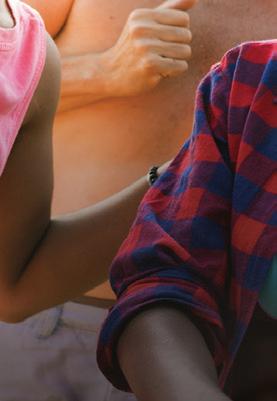














(Evanston Township High School’s The Evanstonian). He read his parents’ books on Black history, but hearing Amiri Baraka speak while he was a journalism student at Southern Illinois University inspired where he should focus his creative energy.
Chicago Black cartoonists who brought social commentary to the funny pages
 By AARON COHEN
By AARON COHEN
Imagine a world to come when mysterious green people subject whites to Jim Crow segregation and a multiracial duo of time travelers launches an uprising. Or conjure a view of the 1960s when race riots became the source of children’s inventions or romantic entreaties. Chicago’s African American cartoonists have created such tales for decades, and
their often neglected work is now receiving wider attention.
These cartoonists comprise a significant part of the Museum of Contemporary Art’s upcoming exhibit, “Chicago Comics: 1960s to Now.” These artists are also the subject of the MCA’s 200-page companion book, It’s Life as I See It: Black Cartoonists In Chicago, 1940-
1980. Numerous styles, attitudes, and subjects encompass this legacy. Some of these comics were originally printed several years ago in African American newspapers and magazines but have been languishing in archives. A few others were self-published and distributed by the artists themselves.
“This stu was marginalized: no one knew where it was,” said cartoonist and author Charles Johnson, whose art and writing appears in the exhibit and book. “Just like the curriculum in our schools—because of segregation—marginalized, if not erased completely, people of color. That was true up through the 60s and beyond. Black art just wasn’t there. Black intellectuals just weren’t in the curriculum.”
The new compilation and exhibit address that exclusion while these comics also offer
“CHICAGO COMICS: 1960S TO NOW”
on view through October 3, 2021 at the Museum of Contemporary Art, 220 E. Chicago, mcachicago.org
IT’S LIFE AS I SEE IT: BLACK CARTOONISTS IN CHICAGO, 1940-1980
Edited by Dan Nadel for New York Review Comics and Museum of Contemporary Art Chicago,
nyrb.comdaring and often hilarious depictions of the 20th century’s major political and social movements. Tom Floyd’s single-panel satires of corporate racial initiatives were part of his 1969 book, Integration Is A Bitch! , and remain prescient more than 50 years later. The children in Morrie Turner’s Dinky Fellas and Wee Pals discussed racism within the comics pages of the mid-1960s Chicago Defender . Seitu Hayden’s comic strip, Waliku , highlighted both the struggles and warmth in everyday urban life in early 1970s issues of the same newspaper. While shared ideas run throughout the comics, all of these cartoonists approached their art through distinctive experiences.
Johnson began passionately drawing while he was growing up in Evanston. As a teenager in the 1960s, he studied with New York-based cartoonist Lawrence Lariar while also publishing comics in his high school newspaper
“Baraka impressed me with one thing that he said,” Johnson recalled. “He said, ‘Take your talent back home to the Black community.’ I had been drawing intensely for seven years, anybody who would give me a chance, I would do it. For college paper, town paper, I did everything, panel cartoons, comics. But I hadn’t thought about accessing and dealing imaginatively with Black history and Black culture.”
Right after Baraka’s talk, Johnson cut classes for a week and drew 89 cartoons in that time. He began assembling his ideas for a book called Black Humor, which Johnson Publishing Company published after selections of it ran in the Chicago Tribune Magazine . The 1970 book satirizes racists and racial assumptions but also makes light of Black militancy. Still, a gentleness runs throughout these panels— Johnson’s caricatures are never overly harsh.
“One of the lessons of Lawrence Lariar’s course was avoiding stereotypes,” Johnson said. “There used to be very vicious stereotypes of Jewish, Black, and Irish people, and he was a liberal Jewish man who said, ‘Don’t do that.’ And I remember cartoons that were in Muhammad Speaks , the cartoonist would always draw white characters with tails, like devils, and I looked at that and thought, ‘Well, OK, that’s the Nation Of Islam, that’s what they talk about and how they depict things,’ and I don’t do that. I know lots of di erent kinds of people who are good people.”
Like Johnson, Seitu Hayden spent his youth collecting comics and had pivotal encounters with Black consciousness programs in college. He moved to Chicago from Fort Wayne, Indiana, to attend art school in the late 1960s. Hayden became involved with Black student groups at Roosevelt University while also becoming aware of activists at the galvanizing 1972 Black Political Convention in Gary. At the same time, he absorbed the underground drawings of Robert Crumb and Spain Rodriguez while watching Dick Gregory and Richard Pryor. All of this played a part in his early 1970s comic strip that adapted its name from the Swahili word for grandchildren.
“I was sort of politicized,” Hayden said. “I was young, idealistic, and thought maybe we can rid ourselves of pesky old racism. My dad thought I was becoming a Black Panther, but I
was looking at Spain.”
Hayden gleaned from his own childhood for Waliku, although he said that Fort Wayne was different from the city neighborhood he depicted. Local thugs—real and imagined—are part of the humor but so is a loving memory of Christmas in a time of deprivation. The Chicago Defender’s fine arts editor Earl Calloway liked it and the strip ran weekly. Although Hayden had hoped for it to run daily, he said he did not understand that syndication meant that it was cheaper for the paper to run old strips of Popeye. Still, he added, “Ten dollars a week was decent cash for a broke college student in 1972. I bought most of the Marvel [comics] I wanted and a few snacks.”
Settings, situations, and dialogue made Waliku ahead of its time. Hayden added that a main character, Marcus, may have been a precedent for the outspoken Huey Freeman decades later in The Boondocks . While Hayden’s use of dialect derived from reading Richard Wright’s novels, the scant response he received came from his use of language.
“At one point, I got wind that some people at the paper didn’t like my use of grammar, Black English,” Hayden said. “There was not even the term Ebonics at that time. Looking back, I would have used more commas and apostrophes. But I got zero feedback as far as what people thought of the strip, I was just doing it.”
As It’s Life as I See It shows, Waliku also continued a theme of children, or childlike characters, bringing up tough issues in comics. In the late 1940s, Jackie Ormes’s precocious Patty-Jo, from her Patty-Jo ’N’ Ginger ,
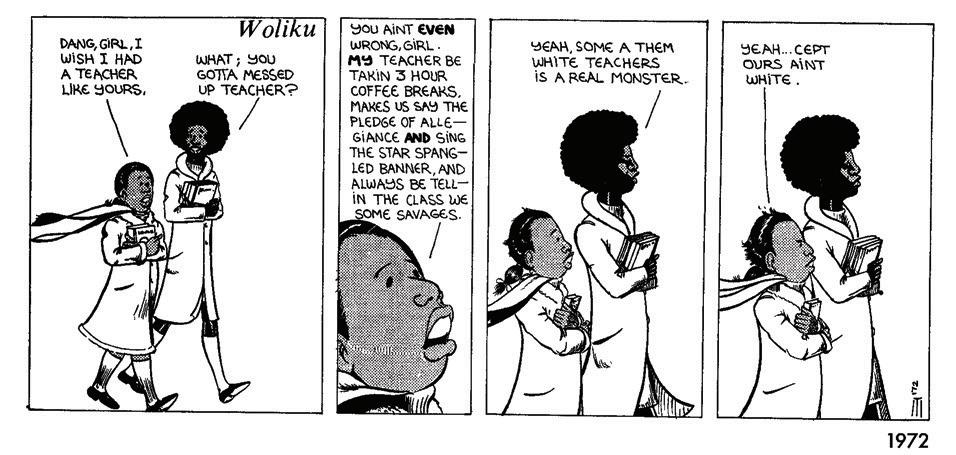
questioned military spending. The boys and girls in Turner’s strips debate historical and lingering issues of identity (as do their dogs). Dan Nadel, who edited the book and curated the exhibit, said that these tropes represent a lengthy tradition.
“This is a technique that is woven into the history of comics: Like with Ignatz Mouse in [early 20th century strip] Krazy Kat expressing complex philosophical ideas,” Nadel said. “It’s an old trope and it works because you can say from the mouths of babes, have these innocent figures saying sophisticated things and people will listen.”
Science and science fiction also run throughout these cartoons, all of which predate the term “Afrofuturism.” Jay Jackson’s allegorical serial, Bungleton Green And The Mystic Commandos, from 1944 depicts a 21st century when “ruthless green men” deny whites jobs and housing as well as subject them to police brutality and lynching. His episodes were drawn in a style similar to his era’s DC Comics (Superman, Wonder Woman). Using more kinetic visuals, Turtel Onli’s NOG, Protector Of The Pyramids from 1981 blends Egyptology with intergalactic combat.
Onli’s friend Yaoundé Olu combined her career as a science teacher with producing a range of art and running the South Shore arts institution Osun. Like Hayden, she also saw that the late 1960s underground comix movement from artists like Crumb and Chicagoan Jay Lynch opened up unconventional possibilities. Her use of physics and space travel— such as in Slinky Ledbetter & Comp’ny Vs. The Gravity Gang from 1980—have been described
as Afrofuturist. While she is aware of the word and once hung out with the musician closely associated with it (Sun Ra), Olu does not feel that it is entirely accurate. She prefers the term “retrofuturism.”
“My work is not about the future,” Olu said. “It’s about the past, present, and potential future and other times in the here and now. Retrofuturism goes back to the past. Kind of like Star Wars, the introduction to Star Wars [“A long time ago, in a galaxy far away . . .”] is where my images originate. These are African kinds of concepts that may be right now in other dimensions, but not necessarily the future. I use other living modalities, usually focusing on African American images in the cosmos, not necessarily just the future.”
That cosmos goes back to some core elements as Olu drew the fanciful adventures of Oxy and Calci Adams. Commonly known as oxygen and calcium, the pair would meet and their union formed a compound. But Olu also cast them in everyday situations where they took on other dimensions in interacting with people on the street.
“These are superheroes not of brawn, but brains and mysticism,” Olu said. “They’re about helping people spiritually.”
While African American cartoonists in Chicago have had fewer opportunities with the decline in Black print publications, they have continued working. Some, like Olu, created their own venues. Others, like Hayden, took on assignments in other industries, such as hair care.
“It would have been cool to do the comic strip my whole career, but I’ve enjoyed the
smorgasbord of art I’ve been able to do,” Hayden said. “I’ve had a whole career doing art and that’s what I’m especially proud of. It doesn’t matter how it happens, I’m just happy I was able to support myself, my wife, my kids and still be around doing stu .”
Some of the cartoonists in the exhibit and compilation built reputations through working across di erent media. Johnson remains committed to drawing but became far better known for his words rather than his images. His novel Middle Passage won the National Book Award in 1990 and along with myriad accolades for his fiction and nonfiction, he directed the creative writing program at the University of Washington. Kerry James Marshall contributed his recent comic strips to the exhibit and created the book’s cover, although it’s his mastery as a painter that is globally acclaimed. Olu retired from teaching but she previously balanced her scholastic duties along with cartooning—drawing editorial cartoons weekly for the Crusader Newspaper Group—with drumming and displaying her artwork at the Bridgeport Art Center (she is regularly part of its Third Friday series).
The exhibit and It’s Life as I See It provide these cartoonists with a substantial new platform for their comics, and its participants are upbeat about this visibility.
“I hope that people see this as an opportunity to broaden the conversation of what history is and most importantly look at more cartoonists, publish more of this work,” Nadel said. “I just wanted to show the diversity of approaches, people who make comics, themes, ways of drawing, ways one can make personal comics free of constraints.”
More diverse cartoonists are seeing their work published in high-profile publications nowadays. Johnson said that in the 1960s there were no Black cartoonists in The New Yorker. Today, Olu pointed to the praise that the magazine’s contributor Liz Montague is earning as an example of a young African American artist’s achievement within current media. Olu added that the book and exhibit will tell everyone about who blazed the trail for such changes to happen.
“I would love to have not just the broader community but the African American community heighten their awareness of African American cartoonists,” Olu said. “I would hope that we could be pacesetters for a future when people would readily see their role models as a guide to what they’re going to be doing.”
ARTIST COLLECTIVE
And the massive survey of artists does it well.
BY S. NICOLE LANEThe nonprofit, artist-run network Tiger Strikes Asteroid has five locations across the U.S. in Los Angeles, Philadelphia, New York, Chicago, and Greenville, South Carolina. Their network of artists is vast, as they work to promote emerging, mid-career, and established creatives. “It feels like the first time,” a new show at Mana Contemporary in Pilsen, grazes the surface of the artists involved in the community.
Started in 2009, the roster of people connected to TSA is constantly evolving. Curators Teresa Silva and Holly Cahill do a substantial job of telling a story between the works in the way they display and situate them with one another. Typically, large comprehensive group shows tend to appear muddy—the works are disjointed and don’t have a sense of flow. That’s natural, of course, because organizing
50 individual artists isn’t an easy process. But “It feels like the first time” is cohesive and complementary as each work seems to build off of the last, either through color scheme, shape, or theme. In an exhibition this large, the artworks still seem to share a dialogue and build on one another to represent a shared sense of communication, a thread of commonality. The show also represents the network’s future and how these artistic relationships and methods of collaboration may grow together when exhibited side-by-side. Works in the exhibition include sculpture, painting, video, drawing, photography, collage, and assemblage that touch on certain frameworks within the world (like intimacy, death, geography, and geometry). When I begin to travel around the gallery, I traverse past similar themes, color schemes, and
shapes.
The large gallery space on Mana Contemporary’s fifth floor includes two rooms. The first room features various mediums of work. I’m immediately drawn to a video piece by New York’s TSA codirector, Brooklyn-based artist Daniel Johnson, entitled Simply Beautiful , 2020. A hand slowly inches its way from the left side of the video, dancing along with the music as it finally rests on the Black dildo sitting on a table in the center of the screen. The video is mesmerizing as the tension between the hand touching and not touching the dildo is amplified.
Mirroring this type of tension is Greenville TSA founder April Dauscha’s video and physical pieces, Sash , 2020 and Ancestral Interaction (sash) , 2021. For approximately one minute, the viewer watches tulle and silk
R “IT FEELS LIKE THE FIRST TIME”
Through 9/30 : schedule an appointment online; Mana Contemporary, 2233 S. Throop, manacontemporary.com.

TOM VAN EYNDE
with beads and thread being dragged over a person’s skin. Underneath the tulle, the viewer can see what appears to be a human body, but it’s unclear what area it is until the final reveal. The figure breathes as their body moves up and down and shadows dance on their skin. Moving through the gallery, I see more links and bonds between the works. No Title, 2019 by Sun You includes blocks of color with polymer clay depicting a home, or physical structure with some sort of passage to look in (or look out). It’s possibly a map, or a wall from a bird’s-eye view. Regardless, I’m drawn to the choice in material that is displayed next to Vincent Como’s works, No Title, 2021, which are ballpoint pen drawings that are similarly square-shaped blocks. Reader Repository , 2017 by Suzanne Dittenber is an 8-by-12 piece made from wax—and carries on this movement of geometric square-shapes in the left back corner of the gallery. Dittenber’s work is a part of a larger series focusing on the ceramics and castings of blank books.
Once I round the back corner and make my way on to the back wall, I’m struck by the exhibition’s name-sake, It feels like the first time , 2021 by Cait Finley. Here, we see a nod towards the otherworldly aliens, also known as the grey people. Finley’s airbrushed painting looks like a tank top you buy from the beach stores on the strip—something you wear after a vacation to New Mexico, or Mars. Close by, on a pedestal, is Nichola Kinch’s Souvenirs From the Apocalypse , 2019 where porcelain sculptures that appear like artifacts are housed underneath a plastic bubble. It can be somewhat difficult to review shows with works from various artists. The exhibition can be too large, or too flooded with imagery, and the works don’t always coexist together. But for TSA, it’s a standout show. Each work, whether a video piece or an alligator head turning on a record player, is strong on its own. “Part of our goal was not just to mount an exhibition but to nurture the possibility for future collaborations,” say Silva and Cahill. The individual works don’t need each other to carry the show; however, as a collection, and as the voices of TSA, their collective side-by-side display illustrates the kinship of artists and curators. v
@snicolelane
Kick off the summer with these events.
By SALEM COLLO-JULINWe’re open! While most of the state and the city has returned to business as usual in some ways, masks are still recommended for many public situations (and required sometimes, including when riding on the CTA). Here are a few activities (on and oline) to consider over the next few weeks. We encourage you to follow the guidelines that the events and businesses that you choose to patronize have in place. Stay safe and enjoy.
Break the Siege: Medical Relief for Gaza
This livestream features a stellar list of artists, speakers, and musicians joining together to raise money for the Palestine Children’s Relief Fund and the Al-Awda Hospital in Gaza via Doctors Without Borders. The online streaming program is hosted by HotHouse and features Amir ElSa ar, Maggie Brown, the Brooklyn Nomads, Vijay Iyer, and more. Sat 6/26, 7 PM, register, donate, and find viewing information at hothouse.net.
Chicago Reader Book Club: Fatimah Asghar

The Chicago Reader Book Club presents an online conversation between Fatimah Asghar, poet, filmmaker, and author of If They Come
For Us and Reader co-editor in chief Sujay Kumar. Thu 6/24, 6:30 PM, ticket required for Zoom access; purchase at chicagoreader.com/ bookclub, $20 for single session.
Chosen Few Picnic and Festival
The annual Chosen Few Picnic and Festival is a virtual online event again this year, featuring guest sets by Louie Vega, David Morales, and DJ Spen. The entire day will stream via the StageIt platform. Sat 7/3, 10 AM-10 PM, chosenfewdjs.com, $10.
First Tuesdays with Maya and Ben
The Reader’s own Ben Joravsky and Maya Dukmasova host the first event of the year at the Hideout’s patio space with First Tuesdays. Tonight will feature a discussion about the fight for an elected school board in Chicago. This is a ticketed event and you must be 21
A survivors’ story fraught with intrigue, bravery, and human frailty
or over with proof of COVID-19 vaccination. Tue 7/6, 6:30 PM, Hideout, 1354 W. Wabansia, hideoutchicago.com, $5.
Jaimie Branch: Fly or Die
Constellation hosts a concert by musician
Jaimie Branch and her acclaimed ensemble Fly or Die. The show is open with limited capacity and also viewable at the venue’s YouTube channel. Sat 7/3, 8:30 PM, Constellation, 3111 N. Western, constellation-chicago.com, $20.
LowDown Brass Band
LowDown Brass Band performs a limited capacity indoor concert at FitzGerald’s in Berwyn, open to those 21 and over. Fri 7/2, 9 PM, 6615 Roosevelt Rd., Berwyn, fitzgeraldsnightclub.com, $20.
Midsummer Block Party
The Kimball Arts Center, located near the 606 Trail, celebrates its recent building renovations with a Midsummer Block Party featuring food, beer, cider, and batched cocktails from Ørkenoy (the brewery located in the Center) and guest vendors, along with music DJed by Wild Prairie Records and artwork for sale. It’s free and open to all ages with preregistration requested: at press time, tickets were sold out but walk-ins will be allowed entry depending on capacity. Sat 6/26, 11 AM-8 PM, the Kimball Arts Center, 1757 N. Kimball, kimballartschicago.com, free.
Vintage Market
Vintage Market in Andersonville is an outdoor event with a variety of local clothing, gift, jewelry, and art vendors plus food from Downstate Donuts and the Happy Lobster Truck. Suggested donation benefits Andersonville Chamber of Commerce’s neighborhood programming. Sun 6/27, 10 AM-3 PM, 1500 W. Catalpa, andersonville.org, $5 suggested donation. v
@hollo
(SCENES FROM THE BRITISH WRECK COMMISSIONER’S INQUIRY, 1912)
BY OWEN MCCAFFERTY | DIRECTED BY VANESSA STALLING

STREAMING ON-DEMAND JUNE 14 - JULY 11, 2021
Tickets at (773) 753-4472 | CourtTheatre.org
Sponsored by Gustavo “Chip” Bamberger and Martha Van Haitsma, the Sidley Austin Foundation, Karen and Bob Lewis, Kevin Hochberg and James McDaniel, and the Elizabeth F. Cheney Foundation
there other movies/books/plays that were a touchstone?
Being a public driver has never been an easy way to make a living. But with the demise of the traditional taxi industry, the job has gotten even harder. Throw in systemic racism, classism, then top it o with COVID-19, and it’s a wonder there’s anyone left willing to risk driving strangers anywhere, anytime. Yet, this is precisely the setting of Reginald Edmund’s Ride Share , a solo play that grew out of Edmund’s own experiences driving. (Edmund originally began sharing his stories as a driver on his Facebook page.)
I drove a cab for 12 years and most of Edmund’s words and observations rang absolutely true. The driver’s seat is a unique vantage point to view the best and worst of humanity. Ride Share now joins a lineage that includes August Wilson’s Jitney and Will Kern’s Hellcab in the tradition of great staged public driver narratives.
Ahead of its world premiere as a digital coproduction of Writers Theatre and Black Lives, Black Words (directed by Edmund’s wife Simeilia Hodge-Dallaway and starring Kamal Angelo Bolden, who appeared in an ear-

lier livestreaming version with BLBW in July 2020), Edmund was kind enough to answer some questions about the production and his ride-share experiences via e-mail.
Dmitry Samarov: Did you envision this as a theater piece when you wrote it? Or did you always hope it would be filmed?
Reginald Edmund: I had pictured it as a hybrid. Something that sat in between the world of theater and film. I had originally conceptualized it as something audiences would experience through Zoom. I wrote it right at the cusp of COVID, during the time of the pandemic when theaters had completely closed shop and were leaving a large number of artists, especially those that were POC, out of work, and wondering where their next check was coming from. So I decided that I was going to use this moment through my organization Black Lives, Black Words as a means to provide artists of color a way to create meaningful socially relevant work that audiences can easily access. We created The Plays for the People
online season, which provided artists of color with artistic employment opportunities and a way to have a creative outlet. It was only at the coaxing of my wife and cofounder of Black Lives, Black Words that I decided to place my own writing into the season. Normally, I feel bad putting my own work out before anyone else’s. But I think I needed that moment to put this narrative out.
Front-seat passengers were a big no-no in taxi times. Seems like passengers sit wherever they want in rideshares. The line between personal and professional was fuzzy in taxis but seems to have disappeared with rideshare. Did you find it a challenge to keep the interactions with people who sat in your car businesslike?
I would often find myself playing therapist to drunk people who get out of the club late, breaking up disputes, and being a listening ear to people telling me all kinds of stories that I couldn’t even imagine. On the negative side, I would also have to deal with a lot of microaggression, racism, and classism.
Did you feel powerless at the whim of the apps?
Oh yeah, totally! You have very limited power. You are dependent on the ride-share app and
RIDE SHARE
6/23 -7/25 : available on demand anytime with purchase, 847-242- 6000 or writerstheatre.org, Solo $ 40, Duo $ 65, Trio $ 85, Ensemble (4+), $100
GPS to go wherever the app sends you in fear of losing ratings or making enough income for the day. During the time that I was driving in Chicago, the pandemic had occurred and the industry was saturated with drivers, therefore the number of rides were extremely limited. The app would send me to the farthest corners of Illinois and sometimes beyond. Places that I never knew existed and sometimes places that would put me in very vulnerable situations.
You mentioned Travis Bickle from Taxi Driver in the play. He’s sort of the patron saint/sinner for any public driver, but were
Yeah, I mean so many great minds, especially August Wilson’s Jitney , helped to stir the pot. I was inspired by works like Following by Christopher Nolan, and Safe by Todd Haynes. I wanted to capture that unnerving feeling that’s found in those isolationist kinds of films. But also writers like Toni Morrison, Octavia Butler, and Tananarive Due also played a part in inspiring me and I hope people catch some of those influences and that adds to the thrill of the ride. Ultimately my goal is to tell a damn good story that blurs lines and doesn’t fit into what audiences expect.
Can you talk a little about the Dark Rider? Guardian angel, devil-on-the-shoulder, embodiment of collective memory, something else?
The Dark Rider is all of the above. It’s the complexity of the inner mind when we’re in a place of darkness, but also it’s the manifestation of pain and sorrow and struggles caused by oppression of being Black in America and bottled up and held in for 400 years. I remember reading about generational trauma in relation to the descendants of Holocaust survivors and recognizing the same experience within the Black community that can be dated back from 400-plus years. The overpopulated prisons, police brutality, Tulsa Race Riots, slavery, Jim Crow, etc. It was important for me to show a character who is living in contemporary America but also (like so many of us) haunted by the echoes of the past.
Did you regain your love of driving after quitting rideshare?
Right after I left doing the ride-share hustle, my wife and I went on a road trip from Illinois to Louisiana and then to my hometown in Texas. That was the first time I felt truly free driving in I don’t even know how long. Now my wife and I will go on road trips and explore the city, and outside of tra c, I have found the joy in driving that I used to have before I started doing ridesharing.
Looking back, would you say your experience driving was a net positive for your life?
The best way to answer this is like Beyoncé, I turned lemons into Lemonade v
Fri-Sat 6/25 -6/26 ; ticketed online entry every half hour between 5 and 7: 30 PM CDT, luckyplush.com, sliding scale $ 5 -$ 50 ($25 suggested)
Their new digital show explores the meaning of spaces and collaboration.
BY IRENE HSIAOFor over a year, the Harris Theater has loomed like an abyss in the center of the Loop, darker and more cavernous than it’s ever been: no drinks in the lobbies, no coats in the checkroom, no tickets ripped, no programs leafed and loosed on the floor. No hum of human gathering, no line out the restroom door, no echo of exhaust in the parking structure, no us. Though it has opened its rehearsal studio and its stage for artists to create digital works and hosted a steady stream of virtual content, its 1,525 seats will remain empty until (according to the latest calendar) October.
“The piece we are making is about the potential and the sadness and beauty of big empty spaces like that,” says Julia Rhoads, artistic director of Lucky Plush Productions, which is a resident company at the Harris. “What is that, to be in that huge empty space alone?”
And what now are we after a year of not sitting in the collective dark of the theater? Pixelated? Low-resolution? Two-dimensional? A little sti ? The Map of Now, a digital festival presented by Lucky Plush, is a tour of Chicago cultural venues designed to be experienced over Gather.Town, a platform that graphically mimics an 8-bit video game, o ering a playful interpretation of our recalibration to space, ourselves, and others. Audiences will roam a map of Chicago as avatars, exploring dance, theater, music, and comedy performances filmed at the Harris, Links Hall, Logan Center for the Arts, and Steppenwolf.
In March 2020, Lucky Plush was rehearsing in preparation for a tour of its most recent work, Rink Life, when the pandemic put a halt to their plans. With a repertoire of devised work that combines repartee with movement and occasional bursts of song, all hinging on
Guide for The Map of Now ; Lucky Plush in 2016’s SuperStrip at the Harris Theater COURTESY LUCKY
the fine timing common to comedians and trapeze artists that tips performance from crystalline order to cacophony, Lucky Plush was initially at a loss for how to proceed (“We tried rehearsing over Zoom, but singing, casual dialogue, it just didn’t work,” recalls Rhoads).
Yet even without performing, the company has remained on the map through its Virtual Dance Lab, a series of online classes taught by Lucky Plush artists and dance artists in the city and beyond. “I think that that became logical when the pandemic happened,” says Rhoads. “I was already planning my cocurricular programming for the University of Chicago”—where she is a lecturer in dance in the Committee on Theater and Performance Studies. “I’ve got all these teachers who are lined up to do cocurricular work, and they’re expecting to be paid, and I need to keep these students moving.
“At the same time, Lucky Plush was looking at shutting down. We have community classes and we do a constellation of classes when we’re on tour. So it made sense to combine e orts and keep not only our artists employed, but all the people that I’ve been engaging with through UChicago, where I try to connect students with a broad range of artists”—artists who have taught classes including Cuban salsa fusion, breaking, tutting, voguing, Graham, Dunham, and more. Lucky Plush also began a blog series, focused on their creation process from the past 20 years, as well as that of other artists in Chicago. “It just made sense, with all that was going on, to really lean into that expanded family, and to point to other artists’ work—and to their Venmo handles. Maybe some money came in. I don’t know.”
Collaboration and Lucky Plush’s context in a broader community of dance and theater is also the organizing principle behind The Map of Now . “We make devised work,” says Rhoads. “Collaboration is really exciting to me. It’s hard to always come up with the next thing, so I really lean into and love all the people I get to work with, because they’re smart, and they make the work better. The Map of Now is an extension of our want to be in a studio together as an ensemble—and being on a map with these other partners and these other artists feels really significant and important.”
Lucky Plush’s Happy Returns , recorded at the Harris this month, draws material from older works, such as Cinderbox (2007), and
includes ensemble members returning from past productions, as well as a few who were born in the last year. “We had two babies this year in the Lucky Plush family,” says Rhoads. “They’re going to star, because babies should. We’re creating a piece that is about a coming together of a group and the process of navigating touch again. We’re playing with cameras with our ensemble members and these little tiny, beautiful beings, to crack open being in a space and coming together in a space like that.”
Creating dance for the camera—and attending a Neo-Futurists benefit hosted on Gather.Town—piqued Rhoads’s curiosity about other Chicago venues that Lucky Plush had partnered with over the years. “I asked them to curate artists that have relationships with those venues—whatever that means to them. And then we could play on this digital map”—a custom-created map of Chicago by Dragon Productions Theatre Company in Redwood City, California, working with UChicago students. “A very idealistic way of thinking about it would be, people will be like, ‘I didn’t even know about the Logan Center.’ And now my little avatar gets to walk there, see what it looks like on the inside, click on interactive objects in the theater space and see avery r. young, Sam Trump, Bril Barrett and the whole M.A.D.D. Rhythms crew—then teleport to Links and see some work there. Hopefully people will have fun with the unknown of it. For me, the performance is equally about the experience of running into people on this little retro gaming style world as it is seeing the works that are in these spaces.” To that end, the map features theater lobby spaces and other gathering points where audience avatars can meet and converse privately.
The deliberately low-tech first-generation 1980s Legend of Zelda -esque vibe of Gather. Town might be viewed as an extension of Lucky Plush’s prepandemic exploration of 1970s roller rinks in Rink Life. “It’s nostalgia for before everything was so in an electronic space,” suggests Rhoads. “There’s a familiarity to songs of that genre that even kids now know so well—classics, disco, or 80s pop—something anchoring about that across generations and across experience. I think there’s also something to imagining times when you’re just doing the thing and not watching yourself have the experience of the thing, or capturing a selfie of yourself doing the thing, that’s compelling.” v @IreneCHsiao

Ifirst came to know Sparks on the occasion of seeing them live several years ago. They played not just one, but two shows at Lincoln Hall, the relatively intimate venue furnishing the ideal circumstances under which to discover this utterly idiosyncratic band. A friend of mine—a fellow cinephile who, like myself, participates heavily in the local film community—remarked that if something had happened at one of those shows, half the Chicago moviegoing crowd would have been wiped out. It was a humorous in-joke, since we couldn’t turn around at either show without bumping into someone we knew from seeing movies most every day.
This is to say that, in addition to being one of the greatest bands, Sparks might also be the ultimate movie lovers’ band, so entrenched is their craft in the art of cinema. Another friend recently wondered on social media whether this could be the year so-called “average people” finally discover Sparks—a premonition elicited by two films involving the not-yetbut-should-be iconic duo: this documentary

The Sparks Brothers , directed by Edgar Wright (Shaun of the Dead, Scott Pilgrim vs. the World, Baby Driver), and the forthcoming Annette, a fiction feature starring Adam Driver and Marion Cotillard and directed by French wunderkind Leos Carax from an original script by the band, who also wrote new music for the film.
So it would seem Ron and Russell Mael, born and raised in California but whose look and sound often cause people to mistake them for a European band, are finally getting their due. That made the concept of this documentary, more than two hours long and propelled by the force of Focus Features’ PR machine, even more exciting. Early in the film, Wright opines in voiceover that Sparks is “successful, underrated, hugely influential, and criminally overlooked—all at the same time.” And he’s not wrong; Sparks is simultaneously one of the most well-liked bands in some circles and one that most have never heard of in others. That’s true of many bands, but what sets Sparks apart is how long they’ve been at it. Both brothers are in their 70s, and they’ve been recording music and performing for five decades. They’ve written more than 300 songs and recorded 25 albums. Hell, they even appeared in an episode of Gilmore Girls (Show creators Amy Sherman-Palladino and Daniel Palladino are big fans and appear in the documentary.)
It’s somewhat forgivable, then, that Wright’s ode is essentially an annotated version of the band’s Wikipedia page. Anyone who likes Sparks will appreciate this aggressive overview of their personal lives and careers, and there’s no denying that Wright is a filmmaker whose enjoyment in making films is palpable.
Disappointing might be a better word for it; one might have hoped that, when time came for Sparks to get their due, the treatment would better reflect the band’s singularity. The film is ambitious, touching on every one of Sparks’ albums, with talking heads to elucidate on the record taking center stage. But Wright’s rabid inclusion of every famous person who even remotely likes Sparks cheapens the endeavor a bit. Among those featured are Beck, Neil Gaiman, “Weird Al” Yankovic, Mike Myers, Fred Armisen, Mark Gatiss, Jason Schwartzman, Jack Antonoff, and Patton Oswalt. Some of the insights are illuminating, especially those from people who have worked with Sparks and real-life fans who have dedicated significant parts of their lives to the band. Current and former Sparks band members and producers, such as Tony Visconti and Giorgio Moroder, speak thoughtfully on their collaborations with the brothers, helping to balance out the who’s who of Sparks’ celebrity fandom. Still, most of the interviewees veer into the realm of the bromidic. Not for nothing, when Wright appears onscreen, he labels himself a fanboy; one senses that the idea for this film came to fruition in a group text with his famous buddies.
Wright shot the talking head footage in black and white, a rather superfluous aesthetic choice. Interspersed throughout are clever animated sequences, as are now found in most documentaries. Wright employs a mix of 2D and stop-motion animation, plus full-on Ron and Russell puppets that I’m sure are now a beloved souvenir. The most annoying device is the interstitials that introduce each segment, featuring the title of a song or album spelled out in stylish typeface with a random definition below it. These unnecessary flourishes bring to mind the fail-safe exordium beloved by lazy college students the world over: “The dictionary defines Sparks as . . .” Wright also focuses excessively on the band’s album cover art, another example of a rather shallow preoccupation that overshadows the integrity of its subject.
At one point, Beck astutely observes, “If you want to understand Ron and Russell, you need to see them through one prism, and that prism is cinema.” The richest part of the film is the exploration of the brothers’ enduring cinephilia, from Russell’s New Wave-inspired
student film to their unrealized collaborations with directors Jacques Tati and Tim Burton; their 22nd album, The Seduction of Ingmar Bergman, is a full-fledged radio musical drama that’s been performed as a live show and was briefly slated to be adapted into a feature film by Canadian director Guy Maddin.
Appropriately, the elements of the documentary that are cinematic do the brothers justice. The editing conveys more through wryly curated archival footage than any of the random celebrities remarking on cover art. This material includes charming photographs from the Maels’ childhood (pretty boy frontman Russell was a football player in high school; keyboardist Ron, perhaps best known for his Charlie Chaplin/“Hitler” mustache, has always rocked some impressive facial hair); concert and interview clips; and imagery completely unrelated to the duo, which at times evokes a smart essay film rather than the rote documentary this is.
Fans of the mildly elusive musicians will enjoy learning about aspects of their lives they prefer to keep private, though nothing that’s revealed could be termed a bombshell. The music, that unparalleled combination of Russell’s vociferous falsetto and Ron’s ingenious lyrics (in addition to his keyboard parts), stands for itself. To Wright’s credit, if his goal is to make viewers, be they previously familiar with Sparks or not, want to go out and listen to their music, then he certainly succeeds. In keeping with their cinematic aspirations, Sparks’ music is the perfect soundtrack, even when they’re the narrative. Their sheer presence likewise bolsters the film; the duo are charming and funny, with such ease as befits those who have been performing for most of their lives. They seem set on maintaining that last air of mystique not commonly allowed to celebrities nowadays, withholding certain tidbits of information (specifically around their love lives) and joking about others.
Sparks may not have sold out arenas in the States, but now they’ll be adorning the mega screens of multiplexes across the country, in a movie directed by a filmmaker whose name will certainly be a draw. In just two months time, audiences will be flocking—one can only hope—to see the band’s cinematic aspirations realized by none other than Leos Carax. Perhaps next time Sparks is in town, we’ll be bumping into many more folks who became fans as a result of this and Annette ; even better if we start seeing them at the movie theater, inspired by the brothers’ reverent cinephilia.
Get showtimes and see reviews of everything playing this week at chicagoreader.com/movies
Summer of 85
mately offers an intriguing take on revenge horror. Le to die in the woods by a sadistic sheriff and her mean girl underlings a er the attack, Lisa seeks retribution all the while struggling to balance her new supernatural abilities with her underlying humanity. It’s an astute take on a female awakening that furthers the argument that more horror films should center on a wider range of people and experiences. Fresh and fun, the compelling storytelling is sure to pull viewers in as it seamlessly weaves werewolf lore into a tried and true revenge narrative complete with working thrills and chills. When paired with the subtle yet impressive makeup work and a perfectly eerie soundtrack, the movie provides an entertaining and endearing entry into the genre.
—BECCA JAMES 92 min. In wide release on VOD
order to emphasize how little there is to inherently set them apart. The rich have sewn their own ruin before the movie begins: the violence of Mexico City’s income disparities begets the dystopian mayhem that follows. The force that puts down the mayhem is only a legalized barbarism.
Pregnancy is hell—figuratively and, as in this constipated quasi-horror feature directed by John Lee (Pee-wee’s Big Holiday), literally. Broad City comedian Ilana Glazer (she and Lee worked together on the show) stars as a marketing professional who’s struggling to get pregnant; her husband (Justin Theroux) suggests they seek the assistance of his med school professor (Pierce Brosnan), an esteemed fertility specialist. Glazer’s Lucy soon becomes pregnant with triplets, the reduction from three to one of which prompts what at first might appear to be a mental breakdown. In the tradition of Rosemary’s Baby (an obvious influence; the film was scripted by Lee and Glazer, based on a story concocted in collaboration with author Alissa Nutting), it’s initially indeterminate whether Lucy is truly unstable or if something’s up between her husband, the doctor, and the clinic’s peculiar staff (Gretchen Mol, who plays an overly cheerful nurse, is especially discomfiting). There’s a lot going on in terms of what the film is exploring—infertility, reproductive autonomy, and the experience of being pregnant in the workplace, among other things—though it probes nothing with any depth. Glazer is an interesting performer, but Brosnan and Mol stand out amidst the enveloping mediocrity. On the whole it’s vaguely reminiscent of a staid, direct-to-video horror film from the 90s, complete with an unnerving, sporadic pulse of a soundtrack. With Sophia Bush. —KATHLEEN SACHS 92 min. Hulu
The first feature from Barack and Michelle Obama’s Higher Ground Productions, based on a bestselling 2011 memoir by Matthew Logelin, Fatherhood tells the story of Matt Logelin (Kevin Hart), a recently widowed father who struggles through the trials and tribulations of raising a newborn daughter. With a skeptical motherin-law (Alfre Woodard) pushing to adopt baby Maddy
(Melody Hurd), Matt strikes out on his own, trying to build a world in which he and Maddy don’t need to rely on anyone but themselves. While not breaking any new ground, Fatherhood is a pleasant enough watch. The film has its genuine moments of heartfelt joy and comedic nuance, but overall suffers from a paint-by-numbers plot, and an inability to successfully translate its dramatic stakes into emotional resonance. The introduction of romantic interest Swan (DeWanda Wise) serves as the primary narrative conflict in the second half of the film, but it’s not much of one, as all of the characters are too genuinely well-intentioned for any real concern over their relationship to build. That said, the performances across the board are enjoyable, with Hart showing an expressive range and Hurd charming in her precociousness. —ADAM MULLINS-KHATIB 109 min. Netflix
Holler offers a considered coming-of-age story set in working-class Ohio. Writer-director Nicole Riegel’s film follows Ruth (Jessica Barden of Netflix’s The End of the F***ing World), a young woman who joins a dangerous scrap metal crew to pay for her education and the chance at a better life. Barden, as has come to be expected, makes the stoic character compelling. Cool colors with splashes of rust and lilac permeate the film, placing a sunset-like filter over the harsh winter setting. It acts as a bleak but beautiful background for Ruth’s life, which is also at odds. She is at once rooted in her community as a daughter to her drug-addicted mother Rhonda (Pamela Adlon), a sister to her older brother Blaze (Gus Halper), and a coworker at a factory in danger of closing, but she also seeks to leave those labels behind for something solely her own. Will she?
—BECCA JAMES 90 min. In wide release on VOD
I Am Lisa is a mesmerizing movie made on a micro budget. Following small-town, local-loser Lisa (Kristen Vaganos) a er she’s bitten by a werewolf, it ulti-
Jacob Tremblay voices the title character, a young sea monster living in the waters of the picturesque Italian Riviera. Just as he was taught by his parents, Luca fears “the change”—the transformation from sea monster to “land monster” that happens on dry land—until one day, free-spirited Alberto (Jack Dylan Grazer) pulls him above the surface and introduces him to all the wonders of being human. Alberto’s poster of a shiny new Vespa gets the pair obsessed with the idea of owning one, the ultimate means by which to escape and see the world. To earn the money for it, they head to town and enter the Portorosso Cup (a fictional classic Italian triathlon of swimming, cycling, and pasta-eating), making friends and enemies along the way, all while avoiding even a single drop of water that could out them as sea monsters to the town of fishers.
Luca feels like the perfect balance of Disney/Pixar, with stunning animation and allusions to classics like The Little Mermaid and Finding Nemo, without getting overly tragic or grand in its lessons (see: Soul). It’s full of likeable characters and genuine platonic love, perfectly isolated in seaside Italy; set anywhere else, the film would feel much more cookie-cutter. When the movie started, I was wary that Disney was pulling a classic Disney, recycling and repackaging a story we’ve all seen before just to make more money. But while the basic premise is nothing new—a young dreamer with overbearing parents escapes to a new world—Luca proves to have enough beauty and character of its own that it is well worth the watch. —TARYN ALLEN 95 min. Disney+
Protestors infiltrate a high-class backyard wedding, loot the safes, graffiti all the art in the house, extort millions in ransom money, and kill anyone who resists. Later, part of restoring order is for uniformed guards to execute a half-dozen of the suspected kidnappers, douse the bodies in kerosene, and torch them. Director Michel Franco (A er Lucia) shows us these different perversions of justice, one slowly bleeding into the other, in
Still, it’s hard to see pregnant women shot through the belly, or the daughters of high-powered aristocrats herded into a cage where they are numbered with a Sharpie on the forehead and raped, and feel that anyone is being served the most just of deserts. The kidnappers and rioters are by and large anonymous, even faceless; Franco mostly films them from over the shoulder. The dizzying, near-comic collapse of values under the duress of poverty and despair echoes Buñuel’s Los olvidados (1950), while the explosive street violence and crackdown tactics recall those documented in The Battle of Chile (1975–1979) by Patricio Guzmán. While hard to watch, this is a brave film for extrapolating from the paradoxes of an unequal society through to one horrifyingly imagined version of its downfall. —MAX MALLER 88 min. In wide release on VOD
During a Q&A session last year, French director François Ozon discussed what it meant to him as a teenager in 1985 to discover Aidan Chambers’s Dance On My Grave a young adult novel of same-sex desire set in an Essex beach town. “It was very strong for us to read this story—in which there is death and love—at a time when the disease of AIDS was everywhere,” he said. The screenplay Ozon adapted from the novel lay unproduced for four decades; it is now the basis for this film, which returns to an earlier mode in Ozon’s work seldom seen since 2003’s Swimming Pool. A poignant sun-drenched nostalgia piece that whisks the viewer through all of puppy love’s wild twists and turns, the film manages not to unduly romanticize its young characters’ innocence in the face of either desire or death.
Adjusting the novel’s setting to the Normandy coast, the central love affair in Ozon’s film is between brooding, morbid teen boy Alexis (Félix Lefebvre) and David (Benjamin Voisin), the tall, tan, grinning daredevil who rescues Alexis when the sailboat he’s borrowed capsizes in a rainstorm. It isn’t long before everyone in this movie is too toned and half-naked for anyone else in the movie to handle. David’s mother (Valeria Bruni Tedeschi, in an arresting performance) can barely keep her mitts off Alexis, a confusing thing to inflict on a boy who’s obsessed with your son. British exchange student Kate (Philippine Velge), poor girl, winds up caught at one corner of a gay love triangle before she knows it. As summer’s end complicates the dream, Alexis’s total commitment to David becomes unrealistic. But in a movie where desire is the only law, what’s unrealistic still gets its shot at being real, even if it only lasts for a summer. —MAX MALLER 100 min. Music Box Theatre v

Marcos Hernández is a restless person, his speech rapid and his hands continuously busy. He and three friends—Juan Herrera, Carolina Duarte, and Tonatiuh Ayala—chat around a conference table under fluorescent lights in what would look like a nondescript office space were it not for the raised platform in one corner, where a drum
set and other bits of music gear hint at the sound and sociability once hosted here. On a warm Sunday afternoon in May, I’ve joined them on the second floor of a former commercial o ce building adjoining what used to be a metal-recycling business at 3200 S. Kedzie in Little Village.
Hernández, an auto mechanic, and Herrera, a sign painter, both live on the first floor of
the building, where they also maintain studios to create music and graphic art. But the second floor is a treasured space not only for the building’s shifting roster of artists and residents but also far beyond it. Since 2016, it’s been the home of La Casa del Inmigrante (“Immigrant House”), a DIY cultural organization formed by five current Casa residents and three friends, including one who visits
periodically from Minneapolis. The group faces imminent eviction, but it’s in no danger of dissolving.
Everyone at the table is a member of La Casa del Inmigrante, and every member is an immigrant from Mexico. “Esto es la base” (“This is the foundation”), explains Duarte. She and Ayala, a carpenter, both live on the north side. The entire building at 3200 S. Kedzie has come to be known as La Casa del Inmigrante, not least because all five of its current tenants are members of the collective. They’ve used the space to support local artists, including nonmembers, by providing them with free studios and hosting workshops where they can share their crafts—in music, theater, and visual art—with the larger community. They’ve raised money to buy and distribute shoes to children in the Mexican state of Aguascalientes, and over the years they’ve repeatedly used the narrow, low-ceilinged, second-story space to host punk bands playing benefit shows. Proceeds from those shows have gone to the victims of the 2017 earthquake in Oaxaca, to the families of the 43 students disappeared in 2014 in Ayotzinapa, Guerrero, and to people displaced by prolonged political violence in Chenalhó, Chiapas, among others.
La Casa has also thrown five benefit shows for La Biblioteca Social Reconstruir, an independent Mexico City library that bills itself as an acervo anarquista (“anarchist archive”). The BSR is something of an inspiration and a model for the Casa folks, who dream big when it comes to new types of events they want to hold in their space: artisans’ markets, workshops for elderly adults, even dance circles. Like their counterparts at the comparatively venerable BSR (it was founded in 1978, when its founder made his personal library publicly accessible), they strive to create a place where people can gather to enjoy and inform themselves. As autonomous organizations unconnected to the nonprofit ecosystem, La Casa del Inmigrante and the BSR have struggled to secure spaces in which to operate—they’re both in gentrifying cities where housing costs are high and getting higher.
“Los espacios son carísimos,” affirms Ayala—rents are very expensive. It’s a common challenge for DIY institutions, which purposefully refuse to set up hierarchical organizations with paid sta and other overhead costs (and whose informal nature often means
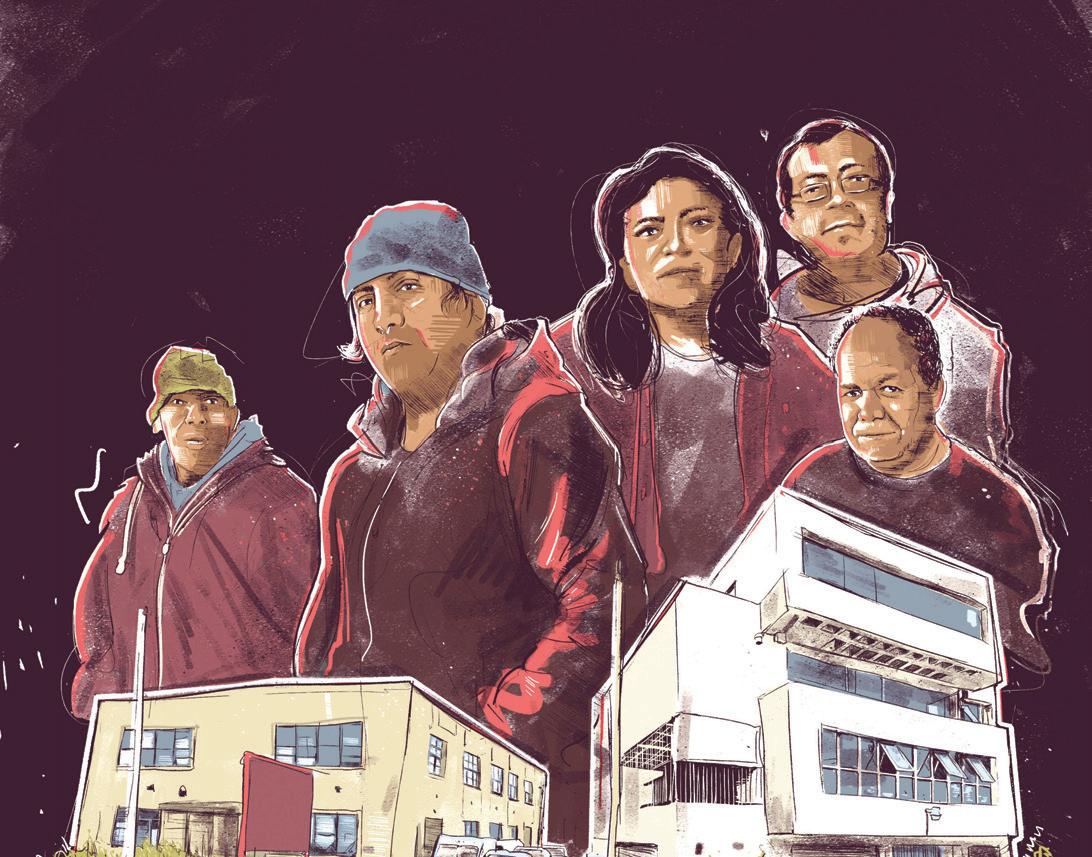
they can’t access established funding sources such as granting agencies). The BSR was evicted from a space in Mexico City in 2009 and remained without a home until 2015. La Casa del Inmigrante seems likely to endure a similar ordeal if the city’s eviction moratorium ends on June 26—which it will, if not extended again by Governor Pritzker.
La Casa’s struggles over the space began at the height of the pandemic. The Chicago Southwest Development Corporation, working with Saint Anthony Hospital, had acquired the property from La Casa’s original landlord, Azteca Mall LLC, in 2018. It plans to use the land as part of a huge development project called the Focal Point Community Campus, which would include a new Saint Anthony Hospital as well as housing and retail space.
(The CSDC’s CEO, Guy Medaglia, is also president and CEO of the hospital.) In October 2020, the CSDC posted notice of their plans to demolish the building at 3200 S. Kedzie to make way for the development.
The conversation in the Casa conference room has become an impassioned torrent of information about the group’s activities and aspirations, continuing unbroken for 22 minutes, in response to just one question from me: “What’s your relationship to the BSR?” Hernández, who’s been listening to the others talk and busily picking at a stubborn strip of tape stuck to the table, finally pipes up with a rapid-fire account of how he encouraged his friends’ embrace of the Mexico City institution. Though all four of these Casa folks are originally from Mexico City, only Hernández has in-person knowledge of the library.
The BSR is a one-of-a-kind place, its impressive collection of leftist historical and political literature amassed by Ricardo Mestre Ventura, one of several Spanish Civil War exiles who settled in Mexico City after fleeing Franco’s fascist regime in the 1930s. Mestre was an anarchist whose belief in the power of the written word had been shaped by his own education in workers’ libraries in Spain, and during his exile he amassed his collection while working as a bookseller and editor. He opened the library in rented space on Avenida Morelos in Mexico City’s historic district, in the hopes that its central location would render it accessible to the largest possible number of people in the sprawling megalopolis.
Mexico has nothing like the robust public library system we take for granted in the United States. Not only are public libraries rare and lending privileges rarer, but books themselves can be much more expensive. Specific titles—especially on a subject such as anarchism—are hard to find in Mexico City’s street markets, despite their teeming trade in
secondhand books, and even if you can track down a volume online (not a popular option among people I know), you might not be able to a ord it.
Mestre not only made his collection public but also established the library and its environs as a gathering place. He frequently met with fellow Spanish exiles at nearby Café La Habana, a famous haunt for the city’s cultural and political thinkers (rumored to be where Fidel Castro and Che Guevara brainstormed the Cuban Revolution). Mestre was equally motivated to befriend young people interested in anarchism, and for a particular group of young people, the timing couldn’t have been better—the city’s punk scene was coalescing during the same period when Mestre was building an audience for his young library.
Two of the library’s current caretakers, Martha García and Kiko (who’s asked to be identified only by his nickname), remember Mestre as di erent from the other aging exiles: more approachable, less fixated on reminiscing about the past, and actively interested in Mexican politics as well as young people’s views on social problems. “He had a lot of empathy for people younger than himself,” says Kiko. He adds that this sentiment translated into a deep mutual respect between Mestre and the punk kids—mostly people in their teens and early 20s—who increasingly began to frequent the BSR.
Finding public places to gather in peace, without the intervention of police or government authorities, was a challenge for young people in Mexico City in the 1980s and continues to be today. The Biblioteca Social Reconstruir became a place where the city’s punks could educate themselves and work on fanzines or other projects of their own. Marcos Hernández first visited the library in the mid-1990s, when he was a high school kid in Ecatepec—a municipality in the north of Mexico City that’s called “Ecatepunk” for all the punk fans who live there.
“The truth is that I didn’t like to read,” Hernández admits. Originally, he says, he was more involved in what he calls “destroy punk,” a more hedonistic way of engaging with the scene. But as he was drawn into a more socially conscious circle of punk-scene friends, he began to spend more time at the library. He describes it as a precious place—you could photocopy stu for free, and no one would run you o for hanging around with your friends. He says it’s where he started to enjoy learning, and where his involvement with punk evolved into something more politically engaged— something grounded in the anarchist ideas that he heard about and witnessed in practice at the BSR.
So deep was the connection Mestre felt
with young people such as Hernández that, when he died in 1997, he left the library in their care—with the express wish that it remain publicly accessible. Unfortunately, he had never bought a building to house it, and renting o ce space in downtown Mexico City was no easy thing (and hasn’t gotten easier). At the time, formal waged work was disappearing in the struggling local economy, which had endured one financial crisis after another from the 1970s onward. Mestre’s death occurred in the wake of the so-called Tequila Crisis of 1994, when the value of the peso plummeted, spurring a $50 billion bailout by the International Monetary Fund. When I arrived in Mexico City in 2008, people shrugged when I referred to the global financial crisis then still unfolding. They were too inured to economic disaster for that crisis to register as a new calamity.
These economic upheavals exacerbated wealth inequality and contributed to the steady transformation of Mexico City. Its picturesque, heavily touristed historic center was increasingly at the heart of battles about who should be able to use public space and how. Despite the recession that began in 2008—by which point at least half of Mexican workers made their living from informal as opposed to on-the-books labor—city o cials were preparing for high-profile bicentennial events in 2010. Street vendors were evicted from parts of the historic district, and its already high rents rose further still.
By then, the Biblioteca Social Reconstruir had moved twice and was located in an old office building near La Alameda Central, a park that encompasses the majestic art deco Palacio de Bellas Artes, a major cultural and performing arts institution in the historic district. García says the library’s rent was then close to 4,000 pesos monthly (roughly $335 at 2008 exchange rates), a small fortune for the punks struggling to keep it alive. I was lucky to get to know the library a little before it was evicted in early 2009, after months of struggling to make that rent.
For the next six years, García’s sister took charge of storing the library’s collection. It includes valuable and even irreplaceable books and newspapers: 19th-century Spanishlanguage editions of the works of anarchist forefather Pierre-Joseph Proudhon, Diego Abad de Santillán’s 1925 biography of Mexican anarchist Ricardo Flores Magón, an original issue of the newspaper Regeneración (published by the Flores Magón brothers in the early 20th century), and dozens of European papers from the Spanish Civil War period.
Finally, in 2015, the library signed a two-year renewable contract with the Frente Auténtico del Trabajo (FAT), one of Mexico’s only auto-
More information about the Biblioteca Social Reconstruir is available at bibliotecasocialreconstruir.wordpress.com and the library’s Facebook page.
nomous labor unions. The BSR reopened on the ground floor of the union’s building and resumed providing a space for self-improvement and sociability. The library’s relationship with the FAT is sympathetic, even symbiotic, but the situation remains precarious—every two years, its contract must be renegotiated. For now, at least, García says that the FAT allows the BSR to use the space in exchange for a monthly contribution of 3,500 pesos ($175) to the building’s maintenance and other expenses.
In 2008, just before the Biblioteca Social Reconstruir’s eviction, Hernández had moved to Chicago and started working with the friends who would form La Casa del Inmigrante. The Casa project began around 2014 with a film series they called Video Club en Resistencia: using portable equipment in borrowed spaces, they screened documentaries with the goal of fostering dialogue among communities in Pilsen, where Hernández and Herrera then lived.
“Desde allá tenemos esa inquietud,” says Herrera (“Since then, we’ve had this restless desire”). The film series was the first outlet for their drive to amplify issues such as immigration and environmental justice. Duarte says they’d also been experimenting with local activism, looking for ways to make a di erence directly—they wanted to use methods that were “más orgánico,” instead of relying on nonprofits or other established organizations.
When Hernández learned of the BSR’s reopening in 2015, he told the other members of La Casa del Inmigrante about its history, its mission, and its DIY methods. As they learned more about the library’s role as a meeting space, not only for punks and anarchists throughout Mexico City but also for its immediate neighbors, they saw parallels with their own efforts. The library’s autonomous organization, without formal hierarchies, also struck a chord. La Casa del Inmigrante held its first benefit show for the library that year.
In 2017, I attended the third festival, by then called Breaking the Borders. The first fest had been held at a di erent DIY venue, but since 2016 the Casa folks had been hosting events at the S. Kedzie address, having partnered with their friend Guillermo Hernández (no relation to Marcos), a theater producer who was renting the space from Azteca Mall LLC.
continued from 31
The third Breaking the Borders fest was an all-night marathon with seven acts on the lineup, including Marcos Hernández’s own Desafío and out-of-state visitors such as New York City hardcore band Huasipungo. It occupied a warehouse space that the friends had cleared of debris, and they’d later rehabilitate the adjoining o ce building that I visited last month. The 2017 benefit raised $600 for the library, according to the money transfer posted on Hernández’s Facebook page.
“Derecha la flecha, aquí no hay trucos,” quips Herrera (“The arrow flies directly, here there are no tricks”). The Casa operates with a transparency and directness that most charity organizations can’t match. The members choose a cause, brainstorm ways to help, come to a consensus, and then get to work themselves. “No nos condicionamos ante nada,” says Ayala (“We are not influenced by anything”). They’re not subordinate to anyone and cherish their independence, which they link to their interest in anarchism. The recipients of their support tend to appreciate seeing documentation of how much the Casa raised and what it cost to send (services such as Western Union take a bite of international cash transfers). That manner of operating is a “reference,” explains Duarte, a calling card recognized by some of their Mexican beneficiaries. She laughs, imagining how they’d be described: “En Chicago, unas personas inquietas.” Those restless, driven people in Chicago. The Casa folks have needed every ounce of their impressive energy over the past several months. Hernández and Herrera describe struggles with the Chicago Southwest Development Corporation that have left the collective’s members weary—particularly the five who live in the S. Kedzie building. “Estamos cansados de pelearnos con ellos,” says Hernández (“We’re tired of fighting with them”).
La Casa del Inmigrante had begun working with Guillermo Hernández in 2016, and the group eventually sublet space from him at 3200 S. Kedzie. Their troubles with the CSDC began in earnest after he became seriously ill and died in August 2020. As Borderless Magazine reported in February 2021, the Casa members had been indirectly paying rent to the CSDC for years through Guillermo Hernández, and they contacted the company immediately after his death in an attempt to continue paying their rent directly. The CSDC refused to accept the money, insisting that it would deal only with the o cial leaseholder.
In October, the tenants at La Casa received notice of the CSDC’s intent to demolish the building. The next month American Demolition, contracted by the CSDC, put up a fence
around the property and hired private security to surveil it.
Since then, the Casa residents report periodically being locked out by that fence—and even being locked in. Just after Hernández and I reestablished contact in April, he apologized via text for a lapse in communication: “Tuvimos otro lock in, pero ya se resolvió todo” (“We had another lock-in, but now everything has been resolved”).
The residents also say they’ve gotten notices from the CSDC and its proxies as recently as June 14 (directly or via their lawyer) claiming that the building is uninhabitable and in urgent need of inspection. The allegation that the space is in dangerous disrepair bemuses La Casa’s residents, who have cozy little apartments on the first floor that they built for themselves in disused office space—tidy dwellings that they show off with no small pride.
“No quiero estresarme,” Herrera told me after the latest notice (“I don’t want to stress myself out”). The CSDC’s lawyer had told La Casa’s lawyer that an inspection would occur on the following day, June 15, but it never happened. The Casa group is represented by attorney Kelli Dudley, who runs the Resistance Legal Clinic and teaches housing law at DePaul University. She wrote to me about the inspection warnings: “This landlord has, in the past, tried to misuse the City’s services by having them ‘inspect’ the premises, condemn the premises, and remove the tenants on that basis instead of going through the recognized court proceedings to get possession.”
Hernández and Herrera also say that the private security service at the property, contracted via American Demolition, has been less than professional. “Nos están acosando todo el tiempo” (“They are harassing us all the time”), says Hernández. (The February Border less story details the situation.) Hernández estimates conservatively that officers from the Chicago Police Department “han venido aquí como tres, cuatro veces” (“have arrived here like three or four times”), and Herrera recalls that they once brought five patrol cars (“cinco patrullas”).
Hernández and Herrera switch to English to replicate their dialogue with the cops: “What are you doing here?”
“Get the fuck out of here, guys!”
“But we live here!” Hernández protests.
“No, no one lives here.”
The Chicago Police Department has not engaged in any detail with the allegations from La Casa tenants. “The Cook County Sheri ’s Department is in charge of the eviction process,” reads the department’s response. “Anyone who feels they have been mistreated by a CPD o cer is encouraged to call 311 and file
a complaint with COPA, who will investigate allegations of misconduct.” (Casa residents have shared photos and video with the Reader that document visits from CPD, not from sheri ’s o cers.) A representative from American Demolition states that as of June 1, the company is no longer involved with the CSDC project. The Casa folks confirm that the site has had di erent security since then.
The CSDC has not directly replied to the allegations either. Perhaps because the company shares a CEO with Saint Anthony Hospital, one of its partners in the proposed Focal Point Community Campus, my request for comment is eventually referred to Jim Sifuentes, the hospital’s senior vice president of mission and community development. He initially characterizes the residents of 3200 S. Kedzie as “trespassers” and repeatedly brings up how unsafe the space allegedly is. “I don’t understand why they would want to stay there,” he says.
When I point out the connotations of “trespasser,” though, Sifuentes changes his tone. Pressed about the complaints of the residents at 3200 S. Kedzie—specifically lock-ins and problems with security personnel—he uses a less confrontational word. “We have not stopped the tenants from coming in and out of the place,” he says. Though he claims that “the Fire Prevention Bureau has listed this building as a dangerous building” (Dudley disagrees), he can’t explain why the city has not therefore agreed to inspect the property. “I can’t speak for the city of Chicago,” he says.
Sifuentes also claims that the hospital has o ered to help the residents find a new home. The Casa residents respond that they did receive an o er—to be placed in a homeless shelter. That wasn’t as safe an option during COVID, and they weren’t willing to move to a place where they couldn’t re-create their studios—some of them have been able to use the Kedzie space to keep working through the pandemic.
Sifuentes is keen to emphasize the good that Saint Anthony Hospital does: “We serve the marginalized,” he says. I ask if those ends justify the means in this case. “If this was a residence, it would be a different story,” he replies. “It would be di erent if we didn’t have a history of living out our mission.”
Dudley doesn’t believe the question of whether the 3200 S. Kedzie space is technically a residence is even relevant.
“The Chicago Residential Landlord and Tenant Ordinance is not tied to zoning determinations,” she says. “In fact, it can apply to an area someone uses as a sleeping place unless excluded under exceptions to the ordinance, which this property does not appear to be.”
She also thinks the e ort to characterize the residents’ presence as illegitimate has no basis in fact. “Legally speaking, the Casa residents are tenants, not squatters,” she explains. “This is because the root of the tenancy goes back to an agreement between a now-deceased tenant and the former owner. At one time, payments were being accepted from the current tenants, there was communication with them, and the tenancy was otherwise acknowledged.”
Unfortunately, none of this may help the Casa del Inmigrante crew stay put. They know that eventually they’ll need to leave their current home, not least because the eviction moratorium appears to be ending soon. They’ve been doing what they can to safeguard their personal safety and La Casa’s existence during these past several months. And they continue to live out the collective’s principles by helping their friends.
Since their most recent annual benefit for the Biblioteca Social Reconstruir in 2019, the Casa group have been constrained by the pandemic and the precarity of their housing. But this past January, they were able to show their support when the library faced a very different but equally grievous need. Héctor Hernández Becerril (known as “Tobi”), the former punk kid who’d arguably grown closest to Mestre and played a significant role at the library after his death, had contracted COVID. Hernández and the Casa folks sent out a GoFundMe call to contacts in Chicago, Mexico City, and beyond and raised $1,966 to cover his care. The donations went instead to pay for his funeral.
Today the Casa group’s friends at the Biblioteca Social Reconstruir o er solidarity in their hour of need. The library is a well-respected DIY cultural institution that’s survived many trials of its own over the decades, and its volunteer personnel can give valuable advice and encouragement. But even if they were to return years of favors by hosting a benefit show for La Casa, it wouldn’t help—and not just because the peso is quite weak compared to the dollar. The problem isn’t that the Casa folks can’t pay rent but rather that their landlord won’t accept it and wants them gone.
I ask García what message the BSR would send to La Casa del Inmigrante. “You have to weld yourself to the struggle,” she says. “The question is to find another space, no? To find another space and to keep giving life to all of this.” Gentrification is a common threat, in Chicago as well as Mexico City. “They want to erase us, no? It’s also erasing social projects, communitarian projects, and we have to fight so that they don’t erase us, don’t eliminate us.”
“We begin anew,” concurs Kiko. “Lo importante es seguir adelante.” The important thing, he says, is to keep moving forward. v










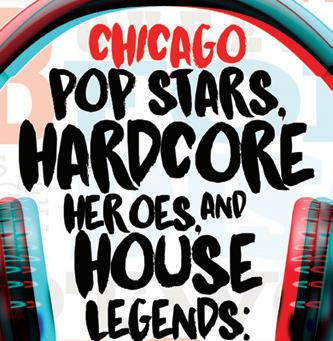



Recommended and notable releases and critics’ insights for the week of June 24

debut
Lucy Dacus, Home Video Matadorlucydacus.bandcamp.com/album/home-video
Mike Lust, Demented Wings Forge Again forgeagainrecords.bandcamp.com/album/demented-wingsFULL DISCLOSURE: MIKE LUST has recorded a handful of records I’ve played on. I also played in a band with him for a while. But there are probably a few hundred local musicians who could say the same thing. Between his prolific career as a recording engineer, his nearly 20-year tenure as the high-kicking, guitar-shredding front man for local outfit Tight Phantomz, his countless stints as a sideman for all sorts of punk and rock bands, and his reliable presence as a larger-than-life, always-on, out-and-about personality, Lust is ubiquitous not only in Chicago music but in Chicago life. His decades of solid musical output have led to his first-ever solo record, Demented Wings, out June 18 on long-running local DIY label Forge Again. Coming from such an over-the-top character, this collection of simple, introspective pop music is a pleasant and welcome surprise. Performed almost entirely by Lust, the mostly minimal songs on Demented Wings include warm, fuzzy, lo-fi forays into synth pop, introspective plays at shoegaze, and catchy takes on bedroom psych. Lead single “Danceteria,” which is anchored by a straightforward keyboard melody and mellow, hooky vocals that sound a bit like Bob Pollard, could play on a loop for an hour and I’d be thrilled. The stomp of “Chrome Intentions” hints at the kind of sleazy swagger you’d expect from Lust, while album highlight “Distort It, Pony” sounds like it could be a lost Ride demo. An album this heartfelt was the last thing I expected from someone as out-there as Mike Lust—a guy I once saw spike a bass guitar onto the venue floor from the stage. These songs can easily get stuck in your head, which is par for the course for Lust, but they also feel deep and sweet, which definitely isn’t—and that just goes to prove he can do it all.
—LUCA CIMARUSTIThe moment you start reflecting on a time that’s past, it’s no longer something you’re living—it becomes something you’ve lived. Lucy Dacus documents and interrogates her own coming-of-age on her new third album, Home Video . A er being blindsided by the success of her 2016 debut, No Burden , Dacus was forced to reckon with her hometown of Richmond, Virginia, which had swily turned from safe haven to minefield as she rose to fame: assumptions circulated, jealousy seethed, and strangers came knocking at her door. With Home Video, Dacus reclaims her homegrown memories, taking space to muse on her past. Right from the opening track, “Hot and Heavy,” she proves that she’s retained her preternatural knack for earworm melodies and gut-punching couplets (“You used to be so sweet / Now you’re a firecracker on a crowded street”). Such wry poetics would sound like posturing in most singers’ mouths, but Dacus’s honeydipped voice and vivid delivery are as warm and sweet as the summer days she reminisces about. The song “VBS” (which stands for “vacation Bible school”) recounts a hormone-fueled, guilt-ridden Christian-camp romance in cringe-inducing detail. Dacus falls hard and fast for a boy who loves Slayer and weed and snorting nutmeg—the kind of minutiae that only feels romantic if you haven’t lived long enough to know better. Religion makes another appearance in “Triple Dog Dare,” which rehashes a youthful queer tryst that couldn’t overcome the fear of God. Against a backdrop of synth and mellotron, longtime live-show staple “Thumbs” tells the tale of Dacus helping a friend break the last threads binding her to her estranged father—blood is no thicker than the rum and Cokes that made him a runaway drunk. Dacus explores weighty topics—death and love and the casualties wrought by the passage of time—but she sings with the lightness of stones skipping over water. Dacus’s Boygenius bandmates, Phoebe Bridgers and Julien Baker, add vocal harmonies on “Please Stay” and “Going Going Gone,” deepening the tenderness of Home Video and giving extra he to otherwise rough-hewn acoustic tracks. Though the album is saturated with celluloid nostalgia, it’s far from wistful or mournful. At 26, Dacus is an old soul, and she understands that what she sees in the rearview mirror isn’t scorched earth, lost to her forever—it’s still her world, in limbo between repression and recollection.
—SHANNON NICO SHREIBAKJean-Luc Guionnet, L’épaisseur de L’air Thin Wrist thinwrist.bandcamp.com/album/l-paisseur-de-lair
Jean-Luc Guionnet’s relationship to music is complicated, and it shows. As a youth, he drew while his father played saxophone, and he didn’t much like what he heard. When he changed his mind during his teens and started making his own music, his first instruments were keyboards, spliced tape, and drums; he only came around to playing saxophone himself because the horn was easy to carry. Since the late 1990s, Guionnet has contributed to more than 80 albums, coming at music from a variety of angles: he’s used recordings of people talking about their listening environments to cra a medi-
brings a clear vision to intense subject matter, but that’s not his whole skill set—it turns out he’s just as good at music that’s supposed to be carefree and fun. On his new EP, Juke Skywalker Vol. 1 (House of Marcell), he celebrates by nonchalantly unloading life-affirming verses atop instrumentals built for maximum joy. These songs emphasize Kinsey’s rapping rather than his storytelling—he’s talented enough on the mike that he can lock into the songs’ strict rhythms while still sounding loose. His athletic performances mirror the sweltering juke percussion, and he makes it all seem easy. —LEOR
GALILL’Rain, Fatigue Mexican Summer shop.mexicansummer.com/product/lrain-fatigue
L’Rain quickly wanders away from them—and from everyone else—to nurture her own “future poisonblooded little babies” (as she sings on “Blame Me”). Her devotion to her own idiosyncratic path makes Fatigue a weird, lovely, and restless album.
—NOAH BERLATSKYColumbia polocapalot.com
tation upon space and memory, employed church organs as vast sound generators, and improvised on alto saxophone alone and in small groups. For years Guionnet has been playing solo saxophone concerts, but he’s never released an album of that music until now. The double LP L’épaisseur de L’air (“The Thickness of Air”) reveals that while Guionnet has mastered the instrument, his relationship with it remains conflicted. He defies the horn’s conventional vocabulary, challenging both its physical limits and his own. Sometimes he uses circular breathing to play unbroken, minutes-long ribbons of translucent sound that form shapes so slowly you can barely perceive them; at other times he spits out masticated notes as though they were unexpectedly bitter seeds. Guionnet’s music expresses extremes of sound and form, and the intensity of his efforts betrays an undercurrent of powerful emotion. The gorgeous severity of the LP’s gatefold sleeve,
whose images he drew and etched, also gives a primary role to the visual art he used to make while he wished his father would stop playing.
—BILL MEYERChicago rapper and librarian Roy Kinsey has drawn national attention for his remarkable concept albums and their sensitive, piercingly thoughtful lyrics. In 2018 he dropped Blackie: A Story by Roy Kinsey , a deeply personal and thoroughly researched record about race in America that’s informed by Kinsey’s family history and the Great Migration; last year he put out Kinsey: A Memoir , which makes equally nuanced and emotionally resonant observations about Black queerness. Kinsey

Brooklyn composer and multi-instrumentalist Taja Cheek, aka L’Rain, has titled her sophomore album Fatigue (Mexican Summer), but she doesn’t sound tired. Her aesthetic is languidly manic, with an eclectic mix of genres and moods bobbing in and out of her layered, psychedelic orchestral pop. Opener “Fly, Die,” kicks off with washes of voices and instrumental sounds interspersed with sudden stops, like a radio station coming in and out of tune. The rest of the album blithely channel surfs through an alternate realm of interdimensional playlists: sweet, distorted shoegaze pop that transforms into gospel testifying in a basement church (“Find It”), a kids’ jump-rope game interrupted by an electroacoustic intrusion (“Black Clap”), and some sort of broken retro dance (“Two Face”). Album closer “Take Two,” about a toxic friendship that’s beyond repair, sounds like a Dua Lipa track being eaten by an exceedingly stoned Day-Glo revenant. L’Rain’s 2017 self-titled debut was a ravishingly melancholy tribute to her mother, who died during the making of the album. Fatigue is more ambivalent and vacillating in mood; its shi ing styles and odd interpolations make its sad moments feel charged with energy and give its upbeat passages an edge of uncanny desperation. Syd Barrett, Marvin Gaye, and Animal Collective all seem like spiritual touchstones, but

In a self-aggrandizing public announcement last month about the return of Lollapalooza, Mayor Lori Lightfoot tweeted a cringey promotional video where she played music for Department of Public Health commissioner Allison Arwady onstage at the Petrillo Music Shell in Grant Park. Early in the clip, Lightfoot changes the soundtrack from a Foo Fighters tune to Polo G’s “Rapstar,” which had debuted atop the Billboard Hot 100 in April. But I don’t believe that this mayor, who violently upholds the status quo, has ever considered Polo G’s lyrics or even listened to the songs that have propelled him to international fame. If she had, she would’ve noticed him writing about a deep well of trauma stemming from decades of racist disinvestment in Chicago’s Black communities and the resulting violence. If Lightfoot enjoys anything about Polo G’s music, it must be the way it can separate upwardly mobile Lolla attendees from their money. The video says less about her than it does about the city’s biggest recent rap star, who rose to heights reached by fewer and fewer artists in the streaming era on the strength of two acclaimed albums: his vivid, commanding debut, 2019’s Die a Legend, and its forceful follow-up, 2020’s The Goat Polo G, born Taurus Bartlett, doesn’t need to prove himself to anyone. And yet his new third album, Hall of Fame (Columbia), seems engineered to impress a music industry he’s already conquered—and whose ranks include the people who’ve booked him for an a ernoon set preceding treacly, inoffensive California pop artist Lauv at the largest music festival in the rapper’s hometown. (Though

to be fair, the segues on the Lollapalooza schedule are generally a mess across the board.) Hall of Fame includes a few too many guests (among them Lil Wayne, Nicki Minaj, Rod Wave, G Herbo, and Lil Durk), a few too many songs (at 20 tracks, it’s his longest album), and a handful of odd musical choices that clash with the star’s baseline of melodic drill (the pedestrian pop-punk affectations of “Broken Guitars”). Fortunately, Polo G’s nonchalant magnetism and high-caliber vocals are strong enough to push through some of the album’s weak spots. On “Epidemic” he addresses the fragility of Black life amid factional gang violence in succinct, plainspoken lines and a sweetly sung hook, proving his singular strength by teasing out such complexities with an emotional performance.
—LEOR GALILScientists, Negativity
In the Red scientists.bandcamp.com/album/negativity
It’s a common misconception that true, filthy rock ’n’ roll died in the early 80s after being eclipsed by new wave, whose shiny commercial sound piled on the gated reverb, drum machines, keytars, and New Romantic vocals. In fact, noisy rock and garage punk flourished underground during that era, thanks to the likes of the Jesus and Mary Chain, Butthole Surfers, Loop, Dwarves, and Australian caveman thudders the Scientists, whose front man and guitarist, Kim Salmon, formed the noirish, blackenedearth postpunk band in 1978 and later put in a few stints in homicidally heavy alt-rock group Beasts of Bourbon. Though till this year the Scientists had only squeezed out two albums (plus several mini albums, EPs, and singles), they’ve left their dark stain on rock history, which the Numero Group celebrated with a box set and reissues in 2016. Shortly therea er, the band began recording new EPs and touring again—this author was extremely fortunate to see their incendiary performance at the East Room in 2018, where they absolutely slayed on a cover of Jacques Dutronc’s “Mini-Mini-Mini.”

Despite the fact that band members now live in
two different countries, the Scientists have at last cra ed their third proper album, Negativity . Lead guitarist Tony Thewlis mailed his riffs from London to Salmon in Australia, who fleshed them out with bassist Boris Sujdovic (also a founding member) and drummer Leanne Cowie (who first joined the group in 1985). The fuzz bombs laid down on the opening cut, “Outsider,” cement the band’s mission statement. “Make It Go Away” and “Naysayer” bristle with similar intensity, combining rhythmic scuzz with Salmon’s ominous half-spoken vocals. The gnarly “Seventeen” and the sarcastic “The Science of Suave” come closest to the Scientists’ vintage sound: dirty, mutant surf licks, saturated with reverb and Stooges-style bluster, much like their 80s contemporaries the Gun Club and Pussy Galore. With its catchy chorus, snappy drums, and cooing background vocals, “I Wasn’t Good Enough” could’ve been a radio hit—though perhaps in a strange dimension where first-generation punks such as Jayne County and Johnny Thunders formed the foundation of classic rock rather than dismantling it. The band throw a melodic curveball with the slow-burning “Moth-Eaten Velvet,” a tribute to the Velvet Underground that features piano by Salmon’s daughter Emma, trumpet by producer Myles Mumford, and a full-tilt string section. The track would’ve made a fine, elegiac album closer, but instead of bowing out gracefully, the Scientists sign off with the trudging, irreverent experiment “Outer Space Boogie,” whose lyrics consist mostly of “C’mon let’s boogie / Out here in space.” I don’t know about you, but I feel like the world could use far more swinging for the cosmos—and the Scientists might just take you there with muddy 80s moon boots on.
—STEVE KRAKOWHyunhye SEo, Strands Room40 room40.bandcamp.com/album/strands
Hyunhye Seo, also known as Angela Seo, has been a member of inscrutable experimental-rock band Xiu Xiu since 2009, providing synths, piano, and
vocals to flesh out their consistently beguiling, unsettling sound. On her debut solo record, Strands (Room40), Seo conjures discomfort in new ways, trading in Xiu Xiu’s outré pop grotesqueries for two 18-minute pieces, one of ambience and the other of solo piano. “Strands I” starts off surreptitiously, with a low, nondescript hum that quietly grows. The desolate atmosphere at play in the track’s oscillating electronics gives off the constant sense that we’re all by our lonesome, forced to confront our inner demons. The text that accompanies the album bolsters this cryptic feeling: Seo describes strands of her hair turning up everywhere she’s been, serving as unpleasant reminders of regrettable decisions and past selves. Moments of relative peace occasionally arise as the track progresses, with gongs and other percussion creating foggy drones, but any serenity is short-lived; the song’s serpentine flow ensures that no moment of solace lasts long. “Strands II,” the piano piece, is even more anxiety inducing. Its ambulatory melodies feel like they’re in constant search of an ending, and they’re shrouded in just enough reverb to create a hazy, disorienting environment—a feeling that’s intensified when piano notes coalesce into a cloud of groggy clanging. Halfway through the track, Seo repeatedly taps a single key and lets it fade into nothing. After a pause, she moves into passages that make astute use of silence, where the negative space creates as much tension as her piano playing. The two pieces on Strands are two sides of the same coin: Seo can capture the ominous with whatever tools she employs.
—JOSHUA MINSOO KIMUdababy, Udababy LP Why?
udababy.bandcamp.com/album/udababy-lp
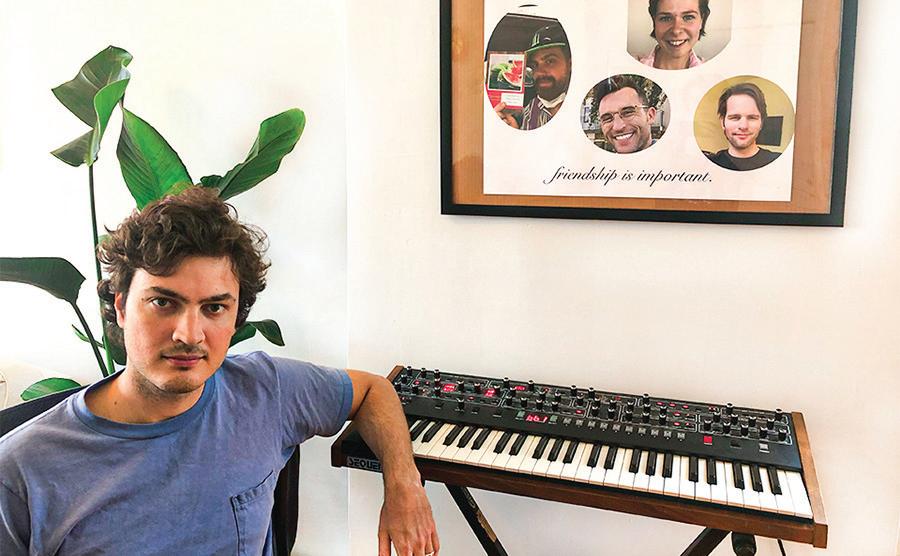
Judging from the energy of practically every Why? Records release, the four rappers who make up the underground Chicago hip-hop collective and label could easily spend the rest of their lives collaborating in different configurations on a half dozen albums per year. Udababy LP, the debut full-length
from Why? duo Udababy, is no exception. Rappers Joshua Virtue (who produced most of the record) and Davis convene amid worn-in instrumentals that are just the right amount of rickety and loose, hitting the sweet spot targeted by every underground hip-hop producer with an affection for grit. Roughhewn and occasionally melancholy, these tracks befit the MCs’ performances: on “2004 World Series of Dice,” for instance, Davis’s mellow, gravelly voice saunters over an unsteady piano loop and dragging drumbeat while Virtue shouts like he’s phoning in from the deck of a merchant ship weathering an open-ocean storm. Both rappers relish moving verses around in their mouths, homing in on the exact right speed and intensity for their delivery, and each song contains reams of ideas that sometimes feel like non sequiturs and sometimes arrive as single pieces of a puzzle about our complicated world. You’ll want to listen to these tracks over and over, so you’re sure to eventually find the treasures Udababy have buried.
—LEOR GALILA couple years ago, Chicago art-rock group Woongi dropped an album intended as an unofficial soundtrack for a 1993 kids’ film featuring a magical flying skateboard voiced by Dom DeLuise. You can try to find spots where the synth-focused songs on Rip’s Cuts might fit into the movie, titled The Skateboard Kid, but their cheeky playfulness speaks for itself. Woongi’s new self-released follow-up, Fruits of the Midi, is a touch subtler but still delightfully silly. The dramatic art-rock freak-out “Fish Fry” combines its proggy riffing with a quick shot of goofiness: on the chorus, a breathy falsetto vocal expresses a desire to mix things up this weekend and host a party for consuming fried cod. The taut and elegant music on Fruits of the Midi demonstrates Woongi’s vibrant, ongoing evolution, and the band’s puckishness helps their maximalist aesthetic keep its feet on the ground.
—LEOR GALIL vMt. Joy, Rookie 7/30, 11 PM, Thalia Hall, 17+
Mt. Joy, Trampled by Turtles 9/23, 8 PM, Chicago Theatre b
AMONG THE MANY outstanding live acts Gossip Wolf has missed over the past 15 months, few rank higher than the LowDown Brass Band. Their mix of New Orleans-style second-line horns with hip-hop and reggae rhythms can make any venue feel like a delightfully sweaty street parade. In February, the band began releasing a series of one- and two-minute tracks, each accompanied by a video (most were shot outdoors, including on the Riverwalk, by the Calder Flamingo in Federal Plaza, and in a convertible on Lake Shore Drive). On Friday, July 2, they’ll drop all ten on an album called Mini Reel Sessions, and that night they’ll play a limited-capacity show at FitzGerald’s . Even better, another fulllength is coming in November!
Allen Moore , a multidisciplinary artist from Robbins, Illinois, calls his work a “social allegory, conversing with symbols and institutions conducive to the constructs of race, social class and personal introspection.” He paints, sculpts, and makes experimental music, and for his new tape, Lived a deviL (out last week on local label Monastral), he played LPs cast by hand from graphite and okra leaves on multiple turntables, augmenting their scratchy output with keyboards and electronics. On eerie, other worldly tracks such as “Black Is Beautiful,” Moore’s crackling thumps and old soul samples sound like transmissions from beyond the edge of the known universe.
Chicago singer-songwriter Jean Cochrane makes tender, disarming indie pop as Hard Femme. Until last week their newest full-length was 2014’s Masculinity and Other Inconveniences, but the brandnew A Layer of Topsoil makes up for lost time with hook-filled songs about queerness, gender, and, um, corporate social media (“Lonely Starbucks Lovers”). Fans of sensitive indie rock a la Belle & Sebastian can buy A Layer of Topsoil via Bandcamp. —J.R. NELSON AND LEOR GALIL
Got a tip? Tweet @Gossip_Wolf or e-mail gossipwolf@chicagoreader.com.

AFI, Cold Cave 3/13/2022, 7 PM, Riviera Theatre b
Omar Apollo, Serena Isioma, Oston 7/27, 7 PM, Metro b
Bahamas, Sam Weber 10/23, 8 PM, the Vic, 18+
Band of Horses, Michigander
7/31, 11 PM, Metro, 18+
Courtney Barnett, Julia Jacklin 1/23/2022, 7:30 PM, Chicago Theatre b

bbno$, Shotgun Willy, ceo@ business.net, Savagerealm
10/24, 6:30 PM, House of Blues b
Big Wild, Cannons 7/31, 11 PM, House of Blues, 17+
Black Label Society, Obituary, Prong 10/17, 7:30 PM, House of Blues, 17+
Black Pistol Fire, Waltzer 7/28, 9 PM, Empty Bottle
Bloodman, Coyote Man 8/6, 7:30 PM, Bottom Lounge, 17+
Blue October 9/17, 8 PM, House of Blues, 17+
Boy Pablo, Jawny 7/29, 11 PM, Thalia Hall, 17+
Billy Branch & the Sons of Blues, Lurrie Bell 7/2, 7 PM, American Legion Hall Post 42, Evanston
Break the Siege: Medical Relief for Gaza featuring Amir ElSaffar, Ronnie Malley, Vijay Iyer, Canadian Arabic Orchestra, James Falzone, Omar Offendum, Kayem, Brooklyn Nomads, Marty McCormack, El Wadi Ensemble, and more 6/26-6/27, 7 PM, stream at twitch.tv/ hothouseglobal F b
Brokeback 7/24, 9 PM, Thalia Hall, 17+
Cajun Vagabonds, Volo Bogtrotters 7/16, 7 PM, American Legion Hall Post 42, Evanston
Cannonball 7/4, 9 PM, FitzGerald’s, Berwyn
Cavetown, Sydney Rose 8/1, 11:30 AM, Thalia Hall b
Chase Atlantic 11/10, 6:30 PM, Riviera Theatre b City Morgue 10/3, 6 PM, Patio Theater b
Dayglow, Renforshort 7/28, 7:30 PM, Lincoln Hall b Indigo De Souza 9/30, 8:30 PM, Beat Kitchen, 17+
Deacon Blues 7/7, 8 PM, City Winery b
Deeohgee 7/2, 7 PM, FitzGerald’s, Berwyn F b Downtown Brown 7/24, 7 PM, Subterranean, 17+
Drama 7/27, 8 PM, Lincoln Hall, 18+
Kevan E ekhari 7/3, 7/10, 7/17, 7/24, 8/7, and 8/14, 9 PM, Tack Room b
Elohim 7/29, 11 PM, Lincoln Hall, 18+
Emo Nite 8/6, 9 PM, Subterranean, 17+
Ester, Orisun 7/8, 8 PM, Schubas Dominic Fike, Kenny Mason 7/28, 7:30 PM, House of Blues b
Freddie Gibbs 8/1, 11 PM, Metro, 18+ Grandson 7/29, 11 PM, Subterranean, 17+
Chris Greene Quartet 7/18, 7 PM, SPACE, Evanston b
Jack Harlow 7/29, 11 PM, the Vic, 18+
Howard Hewett 7/8, 7 PM, City Winery b
Hinds 7/30, 11 PM, Empty Bottle Horsegirl, Lifeguard 7/10, 8 PM, Schubas b
Brittany Howard, Noga Erez
7/31, 11 PM, Thalia Hall, 17+ Idaho, Slights, String and Return 7/11, 8 PM, FitzGerald’s, Berwyn Mason Jennings, Dead Horses
8/20, 7 PM, American Legion Hall Post 42, Evanston
Jillie 7/2, 9 PM, Tack Room F
Naturally 7 7/3, 6 and 9 PM, City Winery b
Lukas Nelson & Promise of the Real 9/30, 7:30 PM, the Vic, 18+
Neosoul night featuring Loona Dae, Why? Footclan, Trew, Manasseh 7/7, 9 PM, Punch House F
Nouvelle Vague 9/17, 10 PM, Empty Bottle
070 Shake 10/15, 8 PM, House of Blues b
Orchestral Manoeuvres in the Dark 5/6/2022, 8 PM, Riviera Theatre, 18+
Orville Peck 7/28, 9 PM, Thalia Hall, 17+
Peekaboo, Eprom, Tvboo, 11/12, 8:30 PM, Riviera Theatre, 18+
Porches 7/31, 11 PM, Empty Bottle
Post Sex Nachos, Superkick
8/12, 8 PM, Beat Kitchen, 17+
Jimmy Eat World, Aquadolls
7/30, 11 PM, Metro, 18+
Noah Kahan 10/23, 8 PM, House of Blues b
Kali Masi, Hi Ho, Telethon 8/27, 9 PM, GMan Tavern
Kitchen Dwellers, Coyote Riot 10/9, 9 PM, Martyrs’
Langhorne Slim (solo) 8/13, 8 PM, Thalia Hall b
Lauv, Sophie Cates 7/29, 11 PM, Park West, 18+
Damian Lazarus 7/2, 11 PM, Concord Music Hall, 18+
Lettuce 11/19, 9 PM, the Vic, 18+
Limp Bizkit 7/29, 11 PM, Metro, 18+
Liquid Soul 7/24, 7 and 10 PM, SPACE, Evanston b
LowDown Brass Band 7/2, 9 PM, FitzGerald’s, Berwyn LP, Lauren Sanderson 7/28, 9 PM, Metro, 18+ Stephen Lynch 8/21, 7:30 PM, Park West, 18+
Manwolves 7/22, 8:30 PM, Thalia Hall, 17+
The Marías 2/24/2022, 7:30 PM, the Vic, 18+ Marina 2/15/2022, 7:30 PM, Chicago Theatre b
Marwood’s Fall 8/7, 7:30 PM, Bottom Lounge, 17+
Max & Olivia O’Brien, Sebastian Paul 7/28, 7 PM, Park West b
Chrisette Michele 7/1-7/2, 6:30 and 9:30 PM, City Winery b
The Midnight 3/10/20223/11/2022, 7:30 PM, the Vic, 18+
Minor Moon, Sarah Weddle
7/9, 8 PM, Schubas
Miyavi 10/20, 8 PM, Cobra Lounge, 17+
Mr. Chair 7/22, 8 PM, SPACE, Evanston b
Modest Mouse, Sir Chloe 7/31, 11 PM, the Vic, 18+
Motherfolk, Hacky Turtles
8/19, 7:15 PM, Cobra Lounge b
Never miss a show again. Sign up for the newsletter at chicagoreader. com/early
7 PM, Sketchbook Brewery and Taproom, Skokie, opener added Goo Goo Dolls 8/4/2022, 7 PM, Huntington Bank Pavilion, rescheduled b Bill Grady 7/3, 7/17, and 7/31, 4 PM, Martyrs’, show added F
Jon Langford & His Fancy Men, Bethany Thomas 7/11, 7 PM, Sketchbook Brewery and Taproom, Skokie, opener added Passport Vibes Afrobeat Street Festival 8/22, noon, the Promontory, rescheduled b
R&B Only Live featuring DJ
Tiara Monique 8/28, 8:15 PM, House of Blues
Marc Rebillet, LP Giobbi 8/1, 11 PM, House of Blues, 17+
Rebirth Brass Band 9/24, 10 PM; 9/25, 7 and 10 PM, Martyrs’
SAINt JHN 7/30, 11 PM, Park West, 18+ Steel Wheels 7/30, 7 PM, American Legion Hall Post 42, Evanston
Still Woozy, Wallice 2/19/2022, 7:30 PM, Riviera Theatre b
Strawberry Girls, Andres, Amarionette 9/4, 8 PM, Beat Kitchen, 17+
$uicideboy$, Slowthai 7/29, 11 PM, House of Blues, 17+
Surfaces, Goth Babe 7/31, 11 PM, Park West, 18+ Taco 8/14, 9 PM, Bottom Lounge, 17+
Nicholas Tremulis 7/18, 3 PM, GMan Tavern
Twenty One Pilots 10/13, 7:30 PM, House of Blues b
White Reaper, Glove 7/31, 11 PM, Subterranean, 17+ Wild Rivers 10/9, 8 PM, Metro b
Yellow Days 11/23, 8 PM, Metro, 18+
Young the Giant 7/30, 11 PM, House of Blues, 17+
Angel Bat Dawid, Oui Ennui 7/3, 9 PM, Empty Bottle, opener added Angel Bat Dawid, Philip Armstrong 7/2, 9 PM, Empty Bottle, opener added Architects, Polyphia, Loathe 12/1, 7:30 PM, Riviera Theatre, openers added, 18+
Bleachers, Claud 10/28, 7 PM, Aragon Ballroom, time changed b
Flat Five, Paul Cebar 7/9,
Purity Ring, Dawn Richard 11/5, 7:30 PM, Riviera Theatre, opener added b Pvris, Royal & the Serpent 8/7, 8 PM, House of Blues, opener added b
Todd Snider, Jamie Lin Wilson 11/5, 8 PM, Park West, time changed, 18+ Squid 11/13-11/14, 9:30 PM, Empty Bottle, show added; 11/13 sold out
Archers of Loaf 7/24, 10 PM, Subterranean BoDeans 7/30, 8 PM, North Shore Center for the Performing Arts, Skokie b Rachel Brooke 7/16, 7 PM, Bananna’s Comedy Shack at Reggies
Chosen Few Festival featuring Louie Vega, David Morales, DJ Spen, and more 7/3, 10 AM, livestream at chosenfewdjs.com b
Joan Collaso 7/14, 6 PM, DuSable Museum of African American History b Everclear, Hoobastank 7/14, 8 PM, Concord Music Hall, 17+ Goddamn Gallows 7/14, 8 PM, Reggies Rock Club, 17+ Grant Park Orchestra 7/2-7/3, 6:30 PM, Pritzker Pavilion, Millennium Park F b
Keefe Jackson, Lia Kohl, and Macie Stewart 7/9, 7 PM, Hideout
Luggage 7/14, 9:30 PM, Empty Bottle Makaya McCraven 7/9-7/10, 7 PM, Thalia Hall b
Joanie Pallatto 7/18, 4 PM, Green Mill
Summer Smash Festival featuring A$AP Rocky, Lil Baby, Lil Uzi Vert, and more 8/208/22, Douglass Park b v
CHICAGO
Hali Palombo, 29, is a composer and sound artist who works in found and lost audio and media, frequently including shortwave radio, and creates visual art and video installations from slow-scan television. Her January release Cylinder Loops collages audio from antique wax cylinders, and in March she launched an intermittent podcast, Unknown America, that delves into historical oddities and obscurities. She’s been making field recordings of Wisconsin tourist attraction the House on the Rock (“It’s terrifying—I’m very inspired by it”),

which she plans to use for a seven-inch coming out this summer via local label Ballast.
There’s actually a very specific point I developed an interest in shortwave radio. I was 13 years old. I was at a family barbecue with my grandfather and a bunch of other family members. I was closest to my grandpa. He was very into shortwave radio, and I remember we were sitting at the dining-room table, and he said, “Hey, you look really bored—do you wanna see something cool?”
He went out into his car, and he brought in a huge old radio and plugged it in. So we sat there in the dark living room—everyone else was outside eating ribs and burgers and whatnot—and we sat inside and we listened to shortwave. For three or four hours, we scanned around. We listened to Radio Havana, which is a Cuban station, for a long time. I had a little recorder, a voice recorder that I got at a school book fair that was supposed to be disguised as a pen, because it was, like, for spies. I would record bits I found to be interesting. I
would just listen to them over and over again.
Almost immediately I got a shortwave radio—it was a survival radio, so in order to power it you had to use a hand crank. You’d get a decent amount of reception and power for like 30 minutes, and then you’d have to crank it again. My mom would hear me at four in the morning, frantically trying to generate energy for this radio, and she would come in and tell me, “Please go to sleep. You must go to sleep. Please stop listening to the radio.”
What interests me about shortwave radio
CHICAGOANS OF NOTE
“A lot of the most fascinating audio that I’ve found has been things that most people would just skip over.”
As told to PHILIP MONTORO
is you can hear people and music and sounds from quite literally all over the world. And it isn’t extensively moderated and curated like FM radio is, or even AM radio. In 30 minutes you can hear 50 di erent countries. You can hear someone sitting in a truck babbling or an amateur radio operator who’s 90 years old talking into the ether, to nobody, and you can hear very unusual music that is sometimes being played live. You can hear Morse code. It’s an infinite generator for audio that you’ll hear once and never hear it again. It’s just fascinating and exciting in every way.
Slow-scan television is—people who transmit on shortwave radio, they’re able to transmit these bursts of shrill-sounding data, and you can use an interpreter to translate the data burst into an image. They’ll send, like, pictures of their kids, they’ll send weird stu —girls in bikinis or animals or what have you.
I’ve done like four or five works that are based entirely in slow-scan television. What I do is I translate my own images—photographs I take—into those bursts of data, and then I retranslate them back into an image. And I film all of that. The audio that’s translated into the image is just a bunch of beeps and shrieking— it’s awful. What I do is I create microminiature compositions to go with the slow-scan television, often from field recordings at the location where I take the photograph.
Granted, my career is only three years old, but the further I get, the more I use shortwave radio samples as texture or layering on top of real instruments. On my second record, which is called Cherry Ripe , I used more samples, but I chopped them up, I put a delay on them, I processed them in various ways until they were really foggy and kind of obscured and a little more mysterious.
Cylinder Loops is a wax cylinder collage record. Every track is about a minute and a half long, and I sourced the wax cylinder samples from UC Santa Barbara—they have a massive library of wax cylinder samples that are completely free to use. I cobbled them together into stand-alone little tracks that I felt emphasized certain qualities of the cylinders. Like if there was somebody speaking, I wanted to highlight that by maybe putting a little bit of soft music underneath it.
If there was any genre that Cylinder Loops fell into, it would probably be hauntology. My work is forgotten, lost media that I cobble together into something new. A lot of the shortwave radio stu , no one will ever hear again
unless I commit it to a recording and create something from it.
When I was maybe 21 or 22, I got my first car, and I spent a ton of time driving, and I developed an obsessive interest in anything transient and liminal. And by that I mean stu that you pass through to get somewhere else, kind of otherworldly but functional places—rest stops, tollbooths, truck stops, windmill farms.
My first encounter with something of that nature was—there was this huge smokestack in Joliet that was on fire, that I saw when I was driving. It was one of those places that was tucked way o the side of the highway somewhere, but you could see it incredibly clearly. It took me nearly an hour, when I pulled o the highway, to actually find the flaming smokestack I saw, and when I did it was really majestic and it resonated with me in a way that I couldn’t explain.
After that I developed a really sharp interest in things that are so pervasive and so obvious yet generally ignored—people don’t really recognize the beauty in them because they aren’t paying close enough attention. That for me applied to my interest in found audio and lost audio, these bits of audio or images or photographs or bits of paraphernalia that are kind of forgotten and fall by the wayside and are just discarded.
I would take audio samples of coins ricocheting down slots into the tollbooth, and I would collect receipts from weird fast-food restaurants. I have a ton of video taken of empty airports and empty malls. Basically places that are transient and kind of disregarded. In a lot of cases, shortwave radio falls into that category, because a lot of the most fascinating audio that I’ve found has been things that most people would just skip over.
I have hours of recordings of Morse code. CB radio—truckers talking to each other, which is something that 99 percent of the population would have no interest in, but they have the most insane, hilarious conversations. I feel like my job as a composer is to bring those things into the light and present them in a way that people will find fascinating and beautiful and worth listening to.
I spent about six months teaching myself Morse code. It took that long because I’m not the best at picking up languages, and Morse code is deceptively di cult. I would take recordings of the Morse code on shortwave radio and I would slow it down significantly—I used Audacity to really slow it down—and I would
sit there with a pencil and a piece of paper. There’s a subreddit dedicated to Morse code, and a lot of the people who post on there are old guys who have gotten so good at it that they can just hear it at the speed it’s transmitted and they can translate, which is unthinkable to me.
A lot of the time what you hear is either amateur radio operators just saying hi to their friends, basically, or you would get things that seem like they would be gibberish, but more likely somebody was trying to transmit a message to another person that they wanted to conceal in some way—be it an amateur radio operator or maybe a spy from a long time ago. I learned Morse code for exactly that purpose, because I had all of these recordings and I was way too curious to not try to find out what they meant.
When I have downtime during my o ce job, I go down pretty comprehensive Wikipedia rabbit holes. I’ll click on a region of the country, and then I’ll just repeatedly click on links until I find something that is truly bizarre and unheard of. And then I’ll base an episode of Unknown America on that. Alternately, there’s a terrific website called Roadside America, and it breaks down every state in the country by places of interest or roadside attractions or sites where obscure battles were fought or weird cemeteries.
It’s a lot of finding obscure events in history and people and places and just obsessively researching them and reading about them and writing about them and then composing appropriate scores. There is a culture around podcasting that I find to be quite frustrating— it really is a bunch of derivative pop-culture nonsense. Like, how many podcasts about Buffy the Vampire Slayer do you need to make? There’s like 50. I try to make stu that is (1) very short and (2) about subjects that there are very likely no podcasts about.
I did Vishnu Springs. Vishnu Springs was a—they would call them health spas in the early 1900s. Essentially there was a stream running through a very dense forest in southern Illinois that someone built a hotel and a really small village near, and they advertised the mineral spring running through the plot of land as having healing qualities. So people came, and obviously the mineral water didn’t work, and that was kind of the town’s downfall.
Another topic was the Collyer brothers, New York City’s first widely documented hoarders—they were active in the early 1900s. That’s more of a well-known topic. I think
some people know who the Collyer brothers were.
Brother Stair was a maniacal preacher who broadcasted on shortwave radio for years. He was notorious because he purchased airtime on hundreds of stations, so you essentially could not scan through the radio for five minutes without encountering one of his sermons. And his sermons were—across the board, his entire life—vile. He was homophobic, he was extremely racist, he would scream at his followers. He was just a ba ing figure. He was extremely pervasive and drove other shows o the radio because he purchased their airtime. That’s what got me interested in him. He made a huge impact on the world of shortwave radio. I put out that podcast, and like a week later he died. And I’m like, Oh no, did I do that?
I love House on the Rock. As far as I know, it was this either millionaire or billionaire’s mansion that he filled with his collections of weapons and cars and dolls and swords, and going into it is just bizarre. I’ve never seen that much stuff in that enclosed of a space. Everywhere you turn, there’s some new insane thing to encounter. There’s a giant carousel there. There’s a statue of a giant squid fighting a whale. There’s a huge collection of cars. It’s like the world’s most fucked-up flea market. It’s so strange. You can tell walking through it that the person who owned it and who curated all that stu was completely unhinged. That makes it even better.
My seven-inch has a ton of samples of the House on the Rock’s automated bands and orchestras. Every time I go listen to these automated bands, they’re like one half-step more out of tune. They sound so comical and bizarre. I’m sure someone is going in there and tuning the violins and the basses and what have you, but they always sound just insanely out of tune, which is hilarious. I take samples every time I’m there.
What I’d like to do with any of my work is build atmosphere. I don’t really write lyrics, so the most important thing to me when I’m creating a song or composition is to draw attention to something that’s unheard of and also to build a sense of place, to build atmosphere, and to put the listener in a place that I manufacture for them. So whether that is making them feel nostalgic or scared or, you know, kind of intrigued—those are pretty much the ways that I would like my listeners to feel. Not happy! No. Or excited. But scared would be good. v
More than 50,000 copies will be available at nearly 1,200 locations across the city and suburbs.




July 8, 2021

July 22, 2020

Aug. 5, 2021

Aug. 19, 2021
Sept. 2, 2021
Sept. 16, 2021
Sept. 30, 2021
Oct. 14, 2021
Oct. 28, 2021
Nov. 11, 2021

Nov. 25, 2021
Dec. 9, 2021
Dec. 23, 2021
Cannabis Special Section
Year of Chicago Music +

Food Issue
Music Issue: Festival Guide + Windy City Times Insert
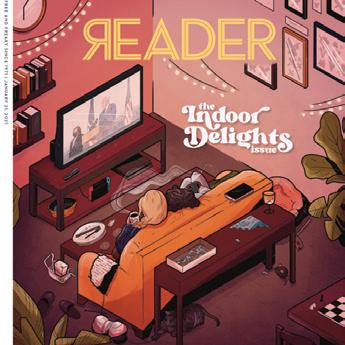
Fall Arts Preview


50th Anniversary Issue 1
50th Anniversary Issue 2
Cannabis Special Section
Nonprofit Issue
Drinks Issue + WCT Insert
Year in Review

My
Keep
By DAN SAVAGEQ : I’m a 40-year-old gay male. I live in a big city, in a dense neighborhood. While I’ve been working from home during COVID, I’ve been sitting at my kitchen table facing a big window. Across the alley is an apartment with a deck. At one point, I noticed a cute, young, muscular guy outside. I ran into this guy a few weeks later at a neighborhood liquor store. While I was looking at porn one night I was stunned to find his nudes and a link to his OnlyFans. I instantly subscribed, went through everything, including his gay sex vids, and, yeah, I came. I tipped him and put in a few comments about what kind of content he should put up next. He took my suggestions and I tipped him again. About a week ago he knocked on my door and asked if I had jumper cables. That night, I found a six-pack of beer by my door and a note from him thanking me for my help. I got back on his page and came so hard as I drank his beer. I don’t want to have sex with this guy— he’s not really my type and he’s too young. I do get off on knowing that I can pull up his dick pics whenever I want and that he will do anything for a few bucks. But I question if I’m crossing a line. He obviously doesn’t know his neighbor is jerking
off to him and probably wants to keep his porn life separate from his private life. Should I feel gross about this? —REAR
WINDOWA : You know something about your neighbor that your neighbor doesn’t know you know about him, RW, and knowledge is power and having power over someone can be sexy. Power imbalances are such a turn-on that people will manufacture them in their absence. For some people having less power (or giving up the power they have) is a turn-on; for others having more power (or being granted more power) is a turn-on. So long as everything is consensual and no one is being exploited or exploitative, RW, no one has to feel gross about it. (Please note: making sure no one is being exploited during consensual power play or during consensual sex in the presence of a significant power imbalance requires thoughtful self-scrutiny, solid communication skills, and a willingness to negotiate and renegotiate.)
What you’re doing is consensual and no one is being exploited. Your hot neighbor is putting his content out there for gay and bi men to enjoy—and straight and bi women too—and being recognized by someone at the
he may be too young for you—and you can absolutely set a floor—whether men in their 40s are too old for him is his call to make.
Q : My girlfriend gave me an impromptu blow job on our way to a party. When we arrived she kissed our host—a mutual (and vaccinated) friend—on the lips. This friend gave my

liquor store or on the street was always a risk. Jacking off to your neighbor’s videos and enjoying the very slight power imbalance and helping him pay his bills in the process isn’t gross. It’s the modern porn business working as intended.

But even if your hot neighbor feels no shame about the work he does—and here’s hoping he doesn’t because there’s nothing shameful about it—your hot neighbor may not care to be reminded that his neighbors could be jerking off to him. (Or have it confirmed that at least one is.) If you were to get to know him better—surely you’ll say hello the next time you see him at the liquor store—and you became acquaintances and he brought up what he does for a living, RW, then you should tell him you’re a subscriber. But until that point err on the side of keeping your mouth shut and your wallet open. You’re not endorsing or reinforcing shame about making porn by being discreet; instead you’re making a reasonable assumption about a boundary someone in his position is very likely to have and respecting that assumed boundary. And finally, RW, I’m not sure I believe you when you say this guy isn’t your type considering the number of loads you’ve blown while watching his porn. And while
girlfriend a strange look. I practice good personal hygiene but we’re pretty sure our host could smell my dick on my girlfriend. Should she have refrained from kissing the host? Excused herself to wash her face first? What’s the protocol here? —WHERE THAT MOUTH HAS BEEN
A : Kissing someone a er they’ve given a blow job to someone else—it’s a risk we all take when we kiss people we aren’t dating. Hell, it’s a
risk some of us take when we kiss the people we are dating. But as a courtesy to others someone who’s just given a blow job should go for the cheek instead. Unless they’re kissing the person they just blew, of course, in which case wide open mouth with tongue. v
Send letters to mail@ savagelove.net. Download the Savage Lovecast at savagelovecast.com. @fakedansavage
hot neighbor is on OnlyFans
your mouth shut and your wallet open, this is how the modern porn business works.JOE NEWTON









Book Club members receive an additional 10% off at the following stores:
The Book Cellar | 4736 N. Lincoln 60625 773-293-2665 | bookcellarinc.com
Bookie’s | 10324 S. Western 60643 312-890-3860 | bookiesbookstores.com
Bucket O’Blood Books and Records | 3182 N. Elston 60618 312-890-3860 | bucketoblood.com
The Dial Bookshop | 410 S. Michigan, 2nd Floor 60605 dialbookshop.com
Madison Street Books | 1127 W. Madison 60607 312-929-4140 | madstreetbooks.com
Pilsen Community Books | 1102 W. 18th St. 60608 312-478-9434 | pilsencommunitybooks.com
Roscoe Books | 2142 W. Roscoe 60618 773-857-2676 | roscoebooks.com
Semicolon | 515 N. Halsted 60642 312-877-5170 | semicolonchi.com
Seminary Co-Op Bookstore | 5751 S. Woodlawn 60637 773-752-4381 | semcoop.com

We’re continuing the conversation! Watch for the next Reader Cannabis Conversations on August 5, 2021


Space is limited. Reserve your spot now. For more information, contact ads@chicagoreader.com

Volumes Bookcafe | 1474 N. Milwaukee 60622 773-697-8066 | volumesbooks.com
Women & Children First | 5233 N. Clark 60640 773-769-9299 | womenandchildrenfirst.com

This yearlong partnership with independent bookstores is supported by the Poetry Foundation.



Mikki Kendall
Hood Feminism: Notes From the Women That a Movement Forgot
Author Talk: Oct. 22, 2020
Sonali Dev Recipe for Persuasion
Author Talk: Nov. 19, 2020
Riva Lehrer Golem Girl
Author Talk: Dec. 17, 2020
Emil Ferris My Favorite Thing Is Monsters
Author Talk: Jan. 28, 2021
Eve Ewing
1919
Author Talk: Feb. 25, 2021
Nnedi Okorafor Remote Control
Author Talk: Mar. 25, 2021
Natalie Moore
The South Side
Author Talk: Apr. 22, 2021

Rebecca Makkai
The Great Believers
Author Talk: May 26, 2021
Fatimah Asghar
If They Come for Us
Author Talk: June 24, 2021
Kayla Ancrum Darling
Author Talk: July 22, 2021
Jessica Hopper (TBD)
Author Talk: Aug. 26, 2021
Precious Brady-Davis I Have Always Been Me: A Memoir
Book Club membership includes: Exclusive access to conversations between Authors and the Reader Discounts to your favorite independent bookstores




A curated monthly newsletter A members-only discussion forum Special offers from Reader partners





K. Ancrum is the author of the award-winning thriller The Wicker King, a lesbian romance; The Weight of the Stars; and the upcoming Peter Pan thriller Darling. Ancrum is a Chicago native passionate about diversity and representation in young adult fiction. She currently writes most of her work in the lush gardens of the Chicago Art Institute.
Presented by:
Author Talk: Sep. 23, 2021 Learn
Presented by:
Karen Hawkins is co-editor in chief of the Chicago Reader. She is also the owner and founder of feminist media company Rebellious Magazine for Women. Her journalism background includes positions with the Associated Press and the Windy City Times



































Potash Markets Grocery Stores located @ 875 N. State Street and 1525 N. Clark Street are hiring team associates for PartTime employment in the following areas: Deli-Cashiers-Stockers-Produce-Salad Bar-Meat-and Bakery. PotashMarkets is a Family Owned and Operated since 1950. To apply: visit our website @ www. potashmarkets.com
Front Desk/Reception
Prestigious Multi-Cultural salon in the South Loop seeking an outstanding candidate for Front Desk/ Reception. Hours vary by day Tuesday - Saturday. Seeking a reliable individual with to provide excellent customer service. Please send your resume including hours of availability to info@ vancleefhair.com.
ing and development strategy; 5 years of experience defining learning solutions that support functional requirements;
5 years of experience developing, implementing, and maintaining training programs and curriculums; 5 years of experience engaging with stakeholders to deliver solutions required to support organizational goals at a local and global level; and 5 years of experience identifying and evaluating the applicability of new learning development vehicles, tools, or programs to management.
Job location: Chicago, IL. To apply, please visit https://careers.northerntrust.com and enter job requisition number 21056 when prompted. Alternatively, please send your resume, cover letter, and a copy of the ad to: I. Tello, 50 S. LaSalle St., Chicago, IL 60603.
ADMINISTRATIVE
SALES & MARKETING
FOOD & DRINK
SPAS & SALONS
BIKE JOBS
GENERAL REAL ESTATE RENTALS FOR SALE
NON-RESIDENTIAL ROOMATES
GOODS SERVICES
HEALTH & WELLNESS INSTRUCTION
MUSIC & ARTS
NOTICES
MESSAGES
LEGAL NOTICES
ADULT SERVICES
The Northern Trust Company seeks Senior Training Consultant, Team Leader to consult with all levels of management to translate business requirements into learning and organization development strategy. Ensure that learning and development interventions are aligned with the needs of the Fund Accounting Business Unit and Northern Trust. Design and develop training material to eliminate knowledge gaps, address specific fund accounting learning needs, and measure success. Deliver trainings in the company’s proprietary fund accounting processes and components. Assess the effectiveness of the programs utilizing departmental metrics and the impact of learning to the attendees. Act as technical expert, train new partners, review the work of others, and provide regular feedback and coaching. Assign tasks to the training team, organize the team’s work, set priorities, monitor activity, and ensure timely and accurate completion of projects and deliverables. Conduct the full performance management process and work closely with partners’ direct managers on staffing decisions. Position requires 5 years of experience with conducting learning needs analysis consultations to understand learning needs. Experience must include a minimum of: 5 years of experience translating business requirements into learn-
Dermacare LLC seeks a Front-End Software Engineer in Chicago, IL to dsign highly funcnl & intuitive UI/UX cmpnents fr admin, med & ptientfacng sftwre. Submit resume to: steve@dermacare.com.
Groupon, Inc. is seeking a Machine Learning Scientist in Chicago, IL w/ the following responsibilities: Use stateof-the-art techniques such as deep learning, computer vision and natural language processing to design end-to-end machine learning solutions. 5% travel reqd. Position based out of Chicago HQ but can telecommute 100% w/in San Francisco commuting area. Apply at www.grouponcareers. com by searching keyword R25059
IT Chicago, IL
SW Engin 2 - Comcast Cable Comm, LLC, Chicago, IL. Create custom SW products to facilitate ad booking & finance functions that support clients. Reqs: Bach in CS, Engin, or rltd & 1 yr exp dvlp enterprise-scale SW in Agile dvlpmt environ; & use C#, JavaScript, jQuery, SQL Server, HTML, CSS & REST web services; of which 6 mos incl use GitHub & ORM frmwks; create modular code use IOC container; & use CI/CD tools. Apply to: Denise_Mapes@ cable.comcast.com. Ref
Job ID# 5496
Data/BI Engin 3 — Comcast Cable Comm, LLC, Chicago, IL. Contrib to Data & BI Team, resp for design & implmnt central real-time report pltfrm. Reqs: Bach in CS, Engin or rltd; 2 yrs exp design & prgrm relational DB use SQL; dvlp ETL process use SSIS; use C#.NET & SSAS; & apply automate process. Apply to: Denise_Mapes@ cable.comcast.com Ref
Job ID #0050
The Lester & Rosalie Anixter Center seeks Assistant Managers for Chicago, IL to oversee treatment plans for patients that have been diagnosed with various mental health illnesses. Bachelor’s in Psychology or Psychology Counseling/related field+2yrs exp req’d. Req’d Skills: Conducting individual & group psychotherapy sessions; counseling patients diagnosed w/ mental health illnesses inclu schizophrenia, bipolar disorders, Post-Traumatic stress disorder, learning disabilities, developmental disabilities, traumatic brain injuries, depression related disorders, anxiety related disorders, & victims of sexual abuse & domestic violence; Psychosocial rehabilitation; developing & reviewing treatment plans; proficient in American Sign Language. Req’d licenses & certifications: Illinois Licensed Professional Counselor. Send resume to S. Lesure, Careers@anixter. org, Ref: BPD
Groupon, Inc. is seeking a Director, Global VMO in Chicago, IL w/ the following responsibilities: Develop & monitor the strategy, deployment & consolidation of Groupon’s Global Operations for Merchant & Editorial Services in NAM, EMEA & APAC. 15% travel reqd. Apply at www.grouponcareers.com by searching keyword R25058
RefugeeOne (www.refugeeone.org) is seeking a part- time (20 hours) Executive Assistant , reporting to the Executive Director and Director of Human Resources. Duties include handling confidential information; correspondence; organization of Board and other executive level meetings.; assistance with recruitment and orientation of new staff.
5-7 years of experience, self -directed, proactive problem solver , able to prioritize and juggle multiple projects in tight timeframe. Comfortable in multi- cultural workplace. Send cover letter and resume to jdouglas@ refugeeone.org
RefugeeOne (www.refugeeone.org) is seeking a part-time (20 hours) book- keeper , responsible for monthly bank and account reconciliations, payroll assistance, processing of accounts receivable and payable. Reports to the Director of Finance. 3+ Years of experience, preferably in non- profit accounting. Familiarity with accounting software including Sage MIP. Flexible work schedule. Send resume and cover letter to jdouglas@refugeeone.org
TransUnion, LLC seeks Senior Consultants for Chicago, IL location to collaborate with solution architects and leads to analyze user needs; translate requirements for developers to create s/w product designs.. Master’s in Comp Eng/ Electronics Eng/related field + 2yrs exp. or Bachelor’s in Comp Eng/Electronics Eng/related field + 5yrs exp req’d. Req’d Skills: Agile/Rally; Ab Initio; Java; Informatica; Express>IT; Cucumber; Business Driven Development framework; Robot framework; Sharepoint; Confluence; Unix; Linux; Visio; Kanban; Scrum methodologies; Waterfall; communicate w/business users to elicit product requirements; exp. translating requirements to developers; articulating sw testing results to business stakeholders; collaborate in Agile teams to estimate & forecast work. 20% telecommuting permitted. Send resume to: A. Goodpasture, REF: VB, 555 W Adams, Chicago, IL 60661
Peak6 Group, LLC seeks Systems Engineer, Cloud Computing in Chicago, IL to anlyze & implment SaaS & cloud platform & architecture. Reqs. Bachelor’s or foreign equiv. in Computer Engin’g, or Engin’g field with quantitative & systems engin’g coursework & one year post-baccalaureate exp. as Cloud Analyst, Cloud Consultant, or rel. role. Quantitative analysis coursework must incl. vector calculus, electronics & sensors, & digital computation & program’g, or directly rel. study. Exp. must incl. Azure App Srvcs, Cosmos DB, Agile Software Methodologies, AngularJS, JSON, Atlassian JIRA, SendGrid and Salesforce. Mail resume: Peak6 Group, LLC c/o C. Schroeder 141 W. Jackson Blvd., Ste. 500, Chicago, IL 60604
lalo s hi a o o e has openings for SOFTWARE ENGINEERS (multiple types/levels): Identify & develop technology solutions for clients. TO APPLY: Go to www.jobpostingtoday. com, search for job code 66570 & submit resume.
Medline Industries, Inc. has multi open’gs in Mundelein, IL for:
A) SAP Configuration Analyst II (SD/OTC) to enhance IS apps supp’tng Order to Cash & related biz func’tns. Apply at: medline.taleo. net/careersection/ md_confidential/jobapply.ftl?lang=en&job=INF01009W
B) Project Manager, Managed Care to lead Agile del’vry & ensure succs’ful del’vry of new tech. Apply at: medline. taleo.net/careersection/ md_confidential/jobapply.ftl?lang=en&job=INF01009X
C) Developer Analyst III (Front-End (E-Commerce)) to design & impl’mnt solu’tns for B 2B E-Comm system. Apply at: medline. taleo.net/careersection/ md_confidential/jobapply.ftl?lang=en&job=INF01009Y
D) Development Automation Engineer to define & provide DevOps ser’ves to supp’t various apps. Apply at: medline. taleo.net/careersection/ md_confidential/jobapply.ftl?lang=en&job=INF01009Z
E) Java Developer III to design & impl’mnt sol’tns for web commrc initiatives. Apply at: medline. taleo.net/careersection/ md_confidential/jobapply.ftl?lang=en&job=INF0100A0
F) Manager, IS Applications (SAP Operations) to lead SAP Op’s team in daily oper’tns for SAP ecosystem. Apply at: medline.taleo.net/careersection/md_confidential/ jobapply.ftl?lang=en&job=INF0100A1
G) Jr Java Developer Analyst to analyze app req’mnts & dvlp apps for back-end & frontend. Apply at: medline. taleo.net/careersection/ md_confidential/jobapply.ftl?lang=en&job=INF0100A2
No trvl; no telcomm for positions A thru G.
TransUnion, LLC seeks Lead Developers for Chicago, IL location to design, develop & enable new software application features.
Master’s in Comp Sci/ Eng/Info Systems/Info Tech or any Engineering/ related field + 2yrs exp or Bachelor’s in Comp Sci/
Eng/Info Systems/Info Tech or any Engineering/ related field + 5yrs exp req’d. Skills req’d: full Software development lifecycle (SDLC) exp. w/ Java, python, JavaScript, HTML, CSS, Linux, Angular JS, shell scripting, relational database design and data modeling, PL/ SQL, SQL, ORM, J2EE, RabbitMQ, Agile, Scrum, CI/CD, microservices, DevOps or Systems Engineering, Jenkins, sonar, git, maven, API, REST, Spring. Send resume to: A. Goodpasture, REF: VP, 555 W Adams, Chicago, IL 60661
TransUnion, LLC seeks Engineers for various & unanticipated worksites throughout the US (HQ: Chicago, IL) to dev, create, customize, & modify sw apps & tools.
Bachelor’s in Comp Sci/Comp Eng/related field +2yrs exp req’d. Skills req’d: Exp w/APIs (swagger, express, flask), AWS (lambda, S3 Athena, Redshift, CodePipeline, SQS, SNS, CloudWatch), Nodejs, Python, Docker, Postgres, Javascript, HTTP, HTML, CSS, Angularjs. Telecommuting permitted. Send resume to: A. Goodpasture, REF: SKS, 555 W Adams, Chicago, IL 60661
TransUnion, LLC seeks Lead Engineers for Chicago, IL location to lead dev, design & architecting of sw apps. Master’s in Comp Sci/Comp Eng/ any Eng or related field + 3yrs exp. or Bachelor’s in Comp Sci/Comp Eng/any Eng or related field +5yrs exp. req’d. Req’d skills: sw design exp w/ Java, scala, SQL, NoSQL, data modeling, data analytics, Linux, shell scripting, Agile/Scrum, Spring/ Hibernate, Redis, Apache Spark, Hadoop, YARN, SonarCube, Junit, Jmeter, TDD, Spring OAUTH, ETL, Docker & Kubernetes, Rest API, SOAP, Git, CICD (Jenkins/Ansible), Cloud (AWS, PCF), Spring Boot, Microservices, Kafka Streams, Splunk & Grafana dashboard, at least 1yr exp in deterministic mathematical matching solutions. 20% telecommuting permitted. Send resume to: A. Goodpasture, REF: DGP, 555 W Adams, Chicago, IL 60661
TransUnion, LLC seeks Sr. Managers for Chicago, IL location to lead a team of professional IT analysts & consultants responsible for designing & developing customized Decision Services proprietary sw. Master’s in Management Info Sys-
tems/Business Admin./ Financial Management/ Management/related field + 2yrs exp. or Bachelor’s in Management Info Systems/Business Admin./ Financial Management/ Management/related field + 5yrs exp. req’d. Req’d skills: 2yrs w/sw development life cycle; business process automation; implementation of decision engines; credit policy automation; implementation of bureau credit scores; credit sw marketing; management of multi-functional teams (business analysts, developers, quality assurance & support personnel). Telecommuting permitted. 5% travel req’d. Send resume to: A. Goodpasture, REF: RTM, 555 W Adams, Chicago, IL 60661
TransUnion, LLC seeks Specialists III for various & unanticipated worksites throughout the US (HQ: Chicago, IL) to install, config, & rebuild network servers, peripherals, services, settings, storage. Master’s in Comp Sci/Comp Eng/Info Tech/Info Mngmt or any Eng or related field + 2yrs exp. or Comp Sci/Comp Eng/Info Tech/Info Mngmt or any Eng or related field +5yrs exp. req’d. Req’d skills: exp w/Linux (RHEL), networking & storage (SAN/NAS), Windows, Automation, Config mngmt & orchestration, vSphere, VMWare, ESXi, VCenter, HA, DRS, Server & Storage vMotion, ActiveDirectory, IAM, Powershell, PowerCLI, Server racks, mounts; AWS Cloud Computing. 100% Telecommuting permitted. Send resume to: A. Goodpasture, REF: GVV, 555 W Adams, Chicago, IL 60661
TransUnion, LLC seeks Sr. Lead Developers for Chicago, IL location to design, implement & maintain sw apps. Master’s in Comp Sci/Tech/ Comp Eng/any Eng field/ related field +3yrs exp. or Bachelor’s in Comp Sci/Tech/Comp Eng/any Eng field/related field +5yrs exp. req’d. Req’d skills: sw app exp w/ Java, J2EE, JSP, Spring, Struts, UML, EJB, SQL, PL/SQL, shell script, Unix shell script, Javascript, HTML, Eclipse, Apache ActiveMQ, SOAP UI, MS Visio, WebSphere, Autosys, Squirrel SQL Client, DB2, Oracle, Git, Maven, Jenkins, Confluence, SonarQube, Open Mule ESB, TOMCAT, Tiles, Junit, Agile, Introscope, Splunk, Spring Boot. Send resume to: A. Goodpasture, REF: MAS, 555 W Adams, Chicago, IL 60661
TransUnion, LLC seeks Data Scientists for Chicago, IL location, partner w/internal & external cross-functional teams to drive new business initiatives. Master’s in Statistics/Mathematics/ Analytics/Comp. Sci./Info. Systems/any Eng. or other quantitative field + 2yrs exp. req’d. Skills req’d: exp. w/data analytics, SQL, data manipulation & model development using R, sparklyR; Python, Hadoop, Hive, Tableau, statistical models (regression, classification, decision tree, random forest, machine learning), experimentation, data mining (databases, SQL queries for data extraction). 40% telecommuting permitted. Send resume to: A. Goodpasture, REF: NP, 555 W Adams, Chicago, IL 60661

TransUnion, LLC seeks Consultants for various and unanticipated worksites throughout the US (HQ: Chicago, IL) to design, develop, implement & maintain sw & web-based app. Master’s in Comp Sci/Comp Eng/related Eng field + 2yrs exp. or Bachelor’s in Comp Sci/Comp Eng/ related Eng field +5yrs exp. req’d. Req’d skills: .Net framework, C#, VB.NET, WFC, WPF, IIS, SQL server, Stored procedure, Triggers, Views, Functions, Web services, Architectural patterns,





SSIS, SSRS, Linux. 100% telecommuting permitted. Send resume to: A. Goodpasture, REF: DD, 555 W Adams, Chicago, IL 60661





Find your next home on Dwellsy, the site to find hard to find rentals. Over 20,000 Chicagoland rental homes and apartments available.
Dwellsy.com




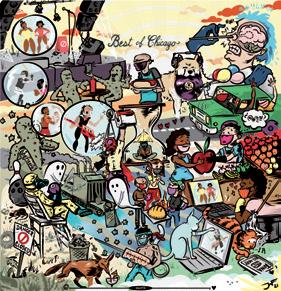

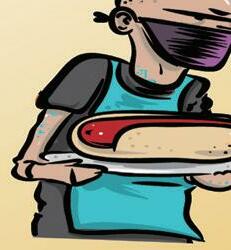
CLEANING SERVICES



CHESTNUT ORGANIZING AND CLEANING

SERVICES: especially for people who need an organizing service because of depression, elderly, physical or mental challenges or other causes for your home’s clutter, disorganization, dysfunction, etc. We can organize for the downsizing of your current possessions to more easily move into a smaller home. With your help, we can help to organize your move. We can organize and clean for the deceased in lieu of having the bereaved needing to do the preparation to sell or rent the deceased’s home. We are absolutely not judgmental; we’ve seen and done “worse”

than your job assignment. With your help, can we please help you? Chestnut Cleaning Service: 312332-5575. www.ChestnutCleaning.com

Have you had an unwanted sexual experience since age 18? Did you tell someone in your life about it who is also willing to participate?




Women ages 18+ who have someone else in their life they told about their experience also willing to participate will be paid to complete a confidential online research survey for the Women’s Dyadic Support Study. Contact Dr. Sarah Ullman of the University of Illinois at Chicago, Criminology, Law, & Justice Department at ForWomen@uic.edu, 312-996-5508. Protocol #2021-0019.










Danielle’s Lip Service, Erotic Phone Chat. 24/7. Must be 21+. Credit/ Debit Cards Accepted. All Fetishes and Fantasies Are Welcomed. Personal, Private and Discrete. 773-935-4995

EROTIC PHONE CHAT
Sexy Singles, Sweet Coeds, Hipster Gals. Only .99c.









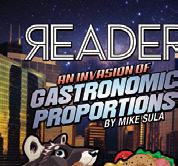



























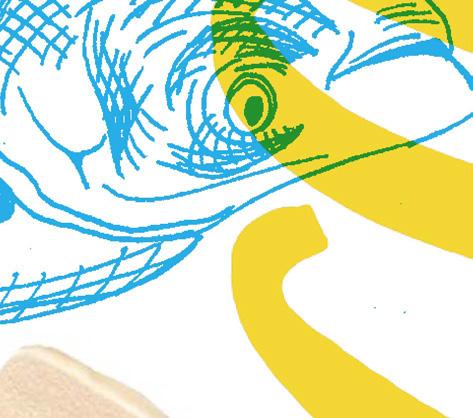










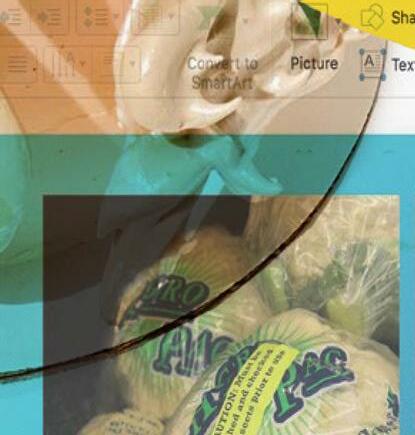



I recall M&K Poultry most by what my family calls “the smell of money.”

Snack foods in the front, squawking in the back. The squawking went on until a customer arrived, and then it didn’t. I was there with two class mates to learn about live butchery, to speak with its practitioners, to in terview its clientele, to examine, I thought, a segment of the American population free from the cognitive dissonance that afflicts many meatconsuming individuals.
Despite having grown up in a commu nity of livestock farmers, 4H legacies, and FFA leaders, live butchery was en tirely foreign to me. Like most Ame rican consumers, my meat came from the supermarket in plastic casing, bac ked by white or black styrofoam, pic
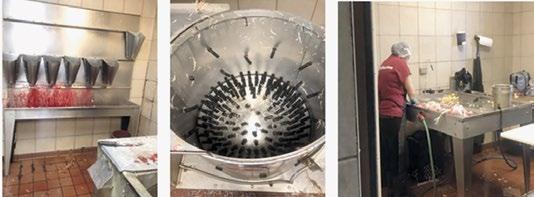
ked out from a cool shelf under harsh light. The idea of the animal was deta ched from the sandwich. What M&K mal and the sandwich, it represented to
By Rachel Abramsfrom such direct ingredients can be. That’s why the couple came back, again and again, for that little taste of some other place, some other age. We selected a chicken, said goodbye to N&R, and left with the bird in a paper
The most provocative part of the visit wasn’t the unusual experience of watching your dinner die, it was uncovering the distance in any two people’s food nostalgia. Food is weird. Me-
chicken propped against a pastel pillow of Fruit Loops; another photo showed our chicken, dismembered and painstakingly reconstructed, exhibiting the kind of homely care the preparation of a meal entails; a final photo places chicken nuggets alongside mashed potatoes and peas, ketchup and pickles on the side, a quintessential childhood meal from an unfamiliar source.


Chicago’s kosher food gem Romanian Kosher Butcher located in West Rogers Park. These stores are always busy and provide a fascinating insight into the kosher industry. When you walk in on a Sunday afternoon, you can see anyone from
Waiting to turn off the squawking while, N shared stories of the fresh figs she’d eaten growing up, the fresh meat, how sentimental a meal made
In a series of photographs, we linked the minimally-processed and unfamiliar with the colorful, highly-processed foods of our own Gen Z nostalgia. A photo we playfully called Toucan Sam in Repose had our head-on, raw

pair would help us pick a poultry. They obliged, walking us through the traits to look for in a ripe bird. All the unfami
As an addendum to the project, we captured audio footage of the M&K kill floor. In conversation with the idea of nostalgia and the meals we prepared bridging individual nostalgias, it draws out the common form of it all, and is a reminder that these variations can and do exist at the same time within any community.

Why is kosher food in Chicago so bad and so limited? This is the question I began my project asking, and the truth is, that despite having multiple parts, it is not a particularly difficult question to answer. The lack of quality kosher restaurants in Chicago essentially boils down to a lack of eating out culture among Kosher keeping people, a lack of interest in “kosher cuisine” among non-kosher keepers, and the manipulation of the Chicago Rabbinical Council through their monopoly on kosher food certification in the Chicago area. Kosher restaurants have a captive audience who are essentially willing to eat and pay for whatever is available to them due to the limited options in the kosher space, but non-kosher keeping patrons, with a wide variety of high quality options at a range of prices, are not willing to pay 20 dollars for a pastrami sandwich or 17 dollars for a limp Greek salad. In communities like Skokie and West Rogers Park, where the vast majority of the religious Jews in the Chicago area reside, a fair number of kosher restaurants have been able to succeed, but each one leaves something to be desired, whether in ambiance, food, or pricing. The restaurants know the demand exists and understand that they need only do the bare minimum to have the support of these captive communities.
While kosher restaurants may often feel empty, or it may be unclear how they continue to pay their bills, one place that is never lacking are the kosher grocery stores. Chicago and its suburbs are served by two full-service kosher grocery stores, as well as two Jewel-Osco’s and a Mariano’s in which there exists full service kosher grocery stores, and of course
ultra-orthodox women and their ten kids stocking up on food for the coming weeks, to men who don’t even wear a yarmulke in public, filling their carts with kosher meat. Although there is less of a restau rant culture among kosher-keeping Jews in Chicago, there is certainly a definitive eating-in culture. The kosher sections and kosher grocery stores in Skokie and West Rogers Park are filled with hard to find kosher ingredients like Parmesan cheese, rice noodles, and gummy candies. If you walk through the aisles, you will also find kosher brands of products that already bear a kosher symbol in their name brand form, like ketchup, mayonnaise, and yo gurt. It’s important to note that these “ko sher brands” are uniformly terrible, and no one who shops at all in a conventional supermarket buys them. Sometimes the kosher brands are catering to those who adhere to an even tighter set of stringen cies, consuming only milk or wheat prod
Extra, extra, read all about it! Spaghetti and meatballs!
Deep dish mysteries! Food for the Gods! Frankenfish!


Friendship Cake! Traif-style bacon cheese burgers! Live butchery! The Chicago Foodcultura Clarion rings out for a third time.


For those who happen to have encountered an issue in their local Reader box for the first time, let me explain:
The Chicago Foodcultura Clarion was born out of a collaboration between the Barcelona/Miami-based multidisciplinary artist Antoni Miralda and your editorialist, a University of Chicago professor of anthropology. The midwife was the University of Chicago’s Gray Center for Art and Inquiry who supported our joint efforts with a generous grant from the Mellon Foundation. Its immediate outgrowth was a course on “Foodcultura: The Art and Anthropology of Food and Cuisine” that Miralda and I taught in the U of C in the fall of 2019 where we sent students out to explore the truly fantastic diversity of Chicago’s culinary worlds. Our initial goal was to showcase the results in a symposium and pop-up exhibit at the Chicago Cultural Center in the spring of 2020. But then you all know what happened.

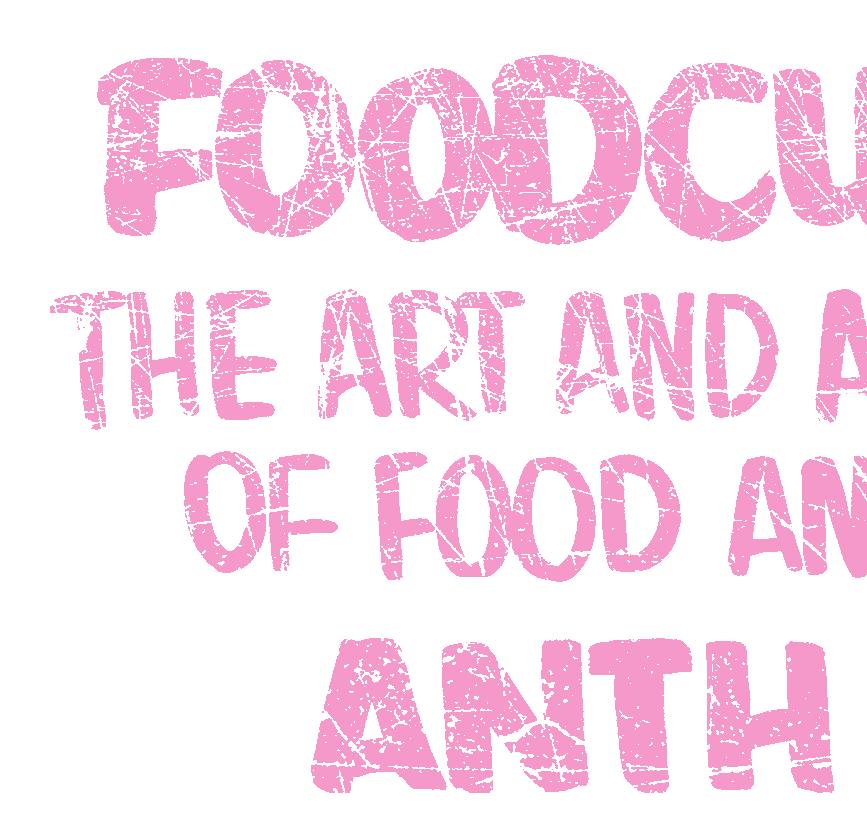


Miralda and I had always wanted our project to reach out beyond the confines of an elite institution like the University of Chicago, and so we decided to retool our project towards the venerable institution of the Chicago Reader. Its publisher, Tracy Baim, kindly agreed to let us run some 3000 copies of the Clarion as an insert every now and again, and Miralda and I found ready and enthusiastic collaborators in Peter Engler, Eric May, and Paige Resnick, and that’s why you are holding issue number three in your hand right now—if you were lucky enough to get a hold of it, that is.
The genre of the editorial generally entails a preview of coming attractions. But it can accommodate a good story or two. In our last issue, I mused about what Nelson Algren and Simone de Beauvoir might have eaten for dinner when they first met and madly fell in love with each other on Chicago’s Near West Side in 1947. This time, I’d like to step back a little further in time and ruminate about one of the less emblematically Chicagoan, but nowadays genuinely all-American dishes, mac ‘n cheese. Its origins are surprisingly uncontroversial. The first generally agreedupon mention of something resembling the contemporary dish comes from the Reverend Mannasseh Cutler who reminisced about a dinner at Thomas Jefferson’s White House in 1802 as follows:
“Dined at the President’s – ... Dinner not as elegant as when we dined before. [Among other dishes] a pie called macaroni, which appeared to be a rich crust filled with the strillions of onions, or shallots, which I took it to be, tasted very strong, and not agreeable. Mr. Lewis told me there were none in it; it was an Italian dish, and what appeared like onions was made of flour and butter, with a particularly strong liquor mixed with them.”
ucts handled by Jews (Chalav Yisrael and Pas Yisrael respectively), but often these products are simply another example of how companies are able to capitalize on this captive and often quite wealthy audience. You will also find uniquely kosher products that don’t exist on any other market. Some are imported from Israel, while others are made right here in the US.
Kosher grocery stores and products provide a wonderful insight into the unique “cuisine” of kosher-keeping people, and the micro industry that is kosher food. This is why in my quest to better understand the kosher food landscape in Chicago, I chose to cook with and showcase Chicago kosher food products for my final project.
For this project I prepared two different items representing two different parts of Chicago kosher foodways. The first item is a challah stuffed with two items that I rarely see outside of the kosher food section: Silan, a date honey, and halva spread. Challah is the most recognizable Jewish food on the planet, and is likely the only thing many people know about tra recognizable item and stuffing it with niche products found broadly in kosher communities, it brings to light certain questions I have been asking throughout my project; who is kosher food made for?
matzo ball soup or a pastrami sandwich, they tend to go to a Jewish deli rather than a kosher restaurant. This leads to a lot of confusion about what is and isn’t kosher, and the differences between kosher style and kosher. Kosher style seems to represent a cuisine that tastes like home and elicits warm feelings and full bellies, while kosher certified generally implies low quality, high prices, and lack of options. I turned these notions on their head with what I call “Treif Style”, treif being the Yiddish word for non-kosher and the colloquial term for food that does not bear kosher certification. What I prepared was a completely kosher bacon cheeseburger, with beef bacon from Romanian, kosher ground beef, and vegan cheese. I brought in all my own cooking equipment to ensure that the food was kosher enough that I would eat it, but the goal was for the food to be the complete opposite of what is expected from kosher or even kosher
Food is central to Judaism and sharing home cooked meals is a huge part of the Jewish experience, and even more so the kosher keeping experience, because most things we want to eat are not easily accessible from stores and restaurants, so we have to make them ourselves. I personally have taken this on as a challenge and often try to find recipes that I can “Kosherize”. While the lack of shrimp paste may make my Thai food inauthentic, and I’ll never know what a real cheeseburger tastes like, I take these limitations as an opportunity to explore the culinary world that is accessible to me, and satisfy my cravings with home cooking when the restaurant
sher food and Jewish food is strong but not always correct. When people crave options are limited.

The “strillions” and “strong liquor” that the good Reverend Cutler found so objectionable have been fairly conclusively identified as pasta and parmesan1 which Jefferson had encountered during his diplomatic service in pre-revolutionary France and his travels in Italy, where he first seems to have tasted and came to love pasta (which he consistently refers to as “macaroni” in his writings). But the third president of the United States not only had his agent William Short ship parmesan on a regular basis, but had acquired a Neapolitan pasta machine, a diagrammatic sketch of which he committed to his writings, along with a highly improbable recipe for how to make “nouilly á maccaroni”2. But then again, according to his slave, Isaac, Jefferson never went into the kitchen “except to wind up the clock”. Instead he would have relied upon his enslaved cook James Hemings to make his mac ’n cheese.


























































































James Hemings was the older brother of Sally Hemings, the mother of Jefferson’s unacknowledged enslaved children3. You see, when Jefferson first went to France as minister plenipotentiary of the newly founded American Republic to the court of Louis XVI, he took his slave James Hemings along and apprenticed him to a Parisian chef. Hemings was literate, eventually spoke French better than his master, and became so skilled in the culinary arts that, in 1796, Jefferson promised him his freedom under the condition that he train another (enslaved) chef for him. It was an offer Hemings could not refuse, but in Jefferson’s mind his cooking had become indispensable. To be sure, Jefferson eventually emancipated him, and reacted with distress when he heard that James Hemings had committed suicide in 1801. But poor James, in many ways, had made a bargain with the devil: There was no place for a free Black French chef in the world that the likes of Thomas Jefferson had forged in early 19th century Virginia.
It is likely that the recipe for macaroni dressed with cheese that Jefferson’s daughter in law, Mary Randolph, published in her cookbook The Virginia House-Wife in 1824 was none other than James Heming’s. If so, does it mark an instance of cultural appropriation? In a sense, yes, for Hemings’s culinary genius remained unacknowledged. But what is it that was being appropriated here?
An African American chef de cuisine’s version of a Parisian-inflected version of an ancient Alpine or Mediterranean peasant dish mixing dairy products with starches?
Nor do we really know how and through what channels of communication mac ‘n cheese entered an emerging African American culinary tradition that, by the second half of the twentieth century, came to be known as Soul Food. The proximity of pasta-consuming marginalized Italian immigrant communities to African Americans in Post-Civil War American cities such as New Orleans is often thought to have played a considerable role in this story. But it was not until 1916 when the Canadian resident of Chicago James Lewis Kraft patented the “Process of sterilizing cheese and an improved product produced by such process” that the price of pasteurized and soon
emulsified cheese began to match the household budgets of the majority of African Americans. By 1928, Kraft Foods launched Velveeta and, in 1937, came up with the 19 cent boxed version of instant mac ’n cheese in the midst of the Great Depression. Feeding a family of four per package, and soon to be put on the WWII rationing cards, Kraft’s mac ‘n cheese began its meteoric commercial ascent, coupled with a race towards the culinary bottom. That Lyndon B. Johnson’s Great Society unloaded vast amounts of heavily subsidized dairy surplus in the form of processed cheese upon welfare recipients and into school lunches only accelerated the process.
The rest, we might say, is history. With Marx we could say that people make their cuisines, but not under conditions of their own choosing: The recipes once prepared by Black cooks like James Hemings and published by white housewives like Mary Randolph converged in the seeming paradox of a racially unmarked industrial comfort food that evokes childhood memories among Americans both white and Black. A “crossover” dish bridging otherwise quite distinct culinary and social formations. Of course, the bill of fare in this issue of the Clarion is decidedly neither industrial nor homogenized. On the contrary, it is entirely artisanal, always unpasteurized, and deliberately diverse. In many ways, the overarching theme is immigration: whether of Afro-Cuban deities, Asian carp, or dishes like polpette in umido. You will read about the labor of love that goes into the feeding of the oricha on Chicago’s Southside (themselves immigrant gods, first from Africa to Cuba, and then on to the United States, large parts of Latin America, and Europe as well); the woes of kosher-keeping Jews who moved to Chicago from New York City and find their culinary choices severely restricted by the stranglehold of Chicago’s Rabbinical Council’s certification policies; a chef’s heroic struggle to establish “Shanghai bass” on the menu of the Palmer House Hilton; the nostalgia evoked among immigrants by Chicago’s live butchery venues; and then some: an interview with Bridgeport activist and culinary pioneer Ed Markowski, the mysterious origins of deep dish Pizza, and art work by Eric May and Hyun Jung Jun. ¡Que aproveche! Enjoy!
By Stephan Palmié1. “American Cheese Products” were then still more than a century in the future (currently defined by the FDA as containing at least 51% of cheese).

2. See Thomas Jefferson’s macaroni machine sketch at https://www. monticello.org/site/research-and-collections/macaroni
3. That James was also the son of Jefferson’s father in law with an enslaved woman, and so not only the half-brother of Jefferson’s
Though I am an Italian-American, I have never eaten the most emblematic dish associated with Italian-Americans, ‘spaghetti and meatballs.’ Growing up in North Jersey, where Italian-Americans are very numerous, and in a family where we ate our traditional foods almost every single day of every year, I of course consumed regularly both spaghetti in various ways and meatballs in various ways, but the two never once appeared together on our family table and the absence of this dish in my life has continued on as I approach the end of midlife. When occasionally confronted with the dish in institutional or other contexts, I have spurned it, though not specifically because a combination of pasta and meatballs is inherently objectionable but rather out of an awareness that any sort of ‘Italian’ food made by unknown people of unknown culinary background is likely to be at best a disappointment and possibly a form of gustatory torture. In other words, had I been presented this dish in the home of an Italian(-American) friend or relative here in the States or Italy, I would have tucked into it, bemused yet appreciative, but in all my years on this earth, that situation has never come to pass.

As the emblematic dish of Italian food in America, ‘spaghetti and meatballs’ has received a certain amount of attention from food writers of different sorts, from the academic to the journalistic to the amateur food-enthusiast. Though some are knowledgeable enough to see connections to traditional southern Italian dishes, there is nonetheless a consensus opinion that the dish is uniquely American and many make the claim that this ‘ItalianAmerican’ preparation evinces shock and horror in native Italians. For example, in the context of a discussion regarding culinary appropriation and authenticity, a justly renowned food scholar, Ken Albala, wrote of this dish: “We say spaghetti and meatballs is Italian-American, worthy of respect in its own right, though it makes ‘real’ Italian people shudder in horror.” Similarly, the journalist Corby Kummer, in an Atlantic article of 1986 intended to teach us all about pasta—an effort which now might be regarded as a bit of culturally appropriative hubris—starts off with a header “An inquiry into a few fundamental questions: How did spaghetti and meatballs, a dish no Italian recognizes, become so popular here?…” I have yet to find a well-informed discussion of the topic.


Native Italians are notoriously proud of their traditional cuisines and vociferously object to the violence that outsiders perpetrate on them—garlic in all’amatriciana ? cream in alla carbonara ? Those are simply not admissible variations. But so too are Italian-Americans who grew up in a culinarily traditional setting—loose ground meat in a lasagna alla napoletana ? Grated cheese on linguine with clam sauce?—unacceptable violations of taste and tradition. In point of fact, culturally conservative native Italians and Italian-Americans have always agreed on a great many fundamental culinary issues and if one aligns the two groups for regions of origin in Italy, the agreement extends to myriad details of particular preparations as well.

All would agree on issues of meal structure—(antipasto/) primo/secondo/salad (/dessert)—as well as general contours to the weekly meal plan and the basics regarding which special events one celebrates at table and how one does so. When some forty years ago I travelled to my grandfather’s hometown in Italy to reestablish a several decades long hiatus in contact between the American and Italian branches of the family, I was flabbergasted at how similar—in many respects identical—the cuisine with which I grew up was to what my cousins enjoyed. The major differences were their stricter adherence to seasonality and access to better versions of many basic ingredients, both of which are related to the fact that they live in direct contact with a particularly rich agricultural countryside and the one in which our shared cuisine came into existence. For example, their home is where the buffalo roam, but not too far, as they must be milked each day for the production of exquisite mozzarella and ricotta, even better than the excellent cows-milk analogs available in Jersey.
Like language, music, religion, dress, etc., cuisine is a cultural domain, which is to say it is not simply a set of ingredients, dishes, meals, cooking procedures, etc. Rather, it is a set of ideas, of rules and preferences, of beliefs, regarding the regulation of how, what, when, and why one properly eats within a given cultural community; the ingredients, dishes, etc. are the physical manifestations of that underlying body of shared mental constructs that resides in the minds of members of that community. This body of culinary knowledge is, like language, learned and in most communities throughout history the primary locus of the transmission of this knowledge has been the family and proximate, allied families who all share similar living conditions; the predominant transmission has been from parents and grandparents to children through explicit instruction and modeled behavior along with the sensory experience of the children themselves. In the United States and now in many other ‘modern’ societies, culinary knowledge is increasingly transmitted to a far less degree in this traditional manner than elsewhere: American culinary discourse is largely oriented outside the family and proximate social group, open to ever-expanding influences through media and impersonal discourse and experience (e.g. in restaurants). And in mainstream American society this has been an increasing trend since the 19th century.
The great wave of (overwhelmingly southern) Italian immigrants that came to the States between 1880 and 1924 were mostly peasants and non-elite urban dwellers and the culinary culture they brought with them was very much traditional in nature. In the old country their poverty had dictated limited consumption of muscle meats, fresh fish, and pasta—these were foods typically only consumed by most on festive occasions, which might include Sundays if one were not terribly poor. The attraction of America was primarily economic and the greater purchasing power Italian-Americans had naturally led to an increased ability to enjoy the aforementioned triumvirate of festive foods, a natural development soon paralleled in southern Italy itself amidst increased prosperity in the mid-twentieth century. In the U.S., a degree of leveling of southern Italian regional differences took place and all the newcomers were subjected to similar new environmental conditions of life in America; out of these processes, there began to develop for a time for a time a new sort of southern Italian regional cuisine(s) in the Northeast and Midwest centers of Italian settlement, neglecting some of the elements of cucina povera and making former holiday dishes more quotidian in nature, but the heart of their un-American cuisine remained.
Abiding and deep mainstream prejudice toward southern Italians and, at least initially, a language barrier inhibited assimilation, but many southern Italian immigrants also chose to resist assimilation to the mainstream with regard to some domains of life and this was especially so in family life and the culinary culture which was inextricably linked to it. To a far greater degree than with some other immigrant groups, culinary culture became a central pillar of ethnic pride and identity. Nonetheless, socioeconomic realities have worked against the longterm stabilization and preservation of this Italian-American cuisine. Intermarriage with non-Italians has played a part but more significant are the many forces in American society that work against the maintenance of a tight family and neighborhood association, the context needed for the transmission of traditional culinary knowledge. Some Italian-Americans have consciously and willingly assimilated to mainstream culinary culture but for many more the break in generational transfer of culinary culture has been an unintended consequence of the demands of participating in American socioeconomic institutions and the concomitant weakening of family bonds, the loss of the crucial family- and group-internal discourse about food on which, by definition, traditional culture depends. The newer generations—the second or third or fourth American-born, varying by family and location—who identify as ‘Italian’ but who have acquired little or nothing of their ancestors’ cuisine beyond a few recipes for individual (mostly festive) dishes, might be more appropriately referred to as ‘Americans of Italian descent’ rather than ‘ItalianAmericans.’ This development, parallel and related to the loss of Italian dialects as ‘heritage language,’ is typically fairly abrupt and we should therefore not speak of Italian-American cuisine changing so much as of ‘culinary death,’ just as we speak of ‘language death’ in a given community, and of replacement of it by the mainstream cuisine.
So then, what is it about ‘spaghetti and meatballs’ that allegedly induces shock and horror in native Italians? First, we must wonder who these shocked and horrified Italians are and it is my suspicion that they are of either of two types. Many Italians (like many other peoples) bear a cultural prejudice against America, especially in connection with things culinary, and an Italianate but non-Italian dish from America would naturally engender a negative reaction. One must also wonder whether these horrified consultants are northern Italians, for meatballs eaten together with pasta is a decidedly southern Italian thing. To be sure, from a traditional southern Italian standpoint, a plate of spaghetti topped with large, round meatballs is also strange and objectionable but hardly a source of horror in itself: Legitimate horror might be evinced if the tomato sauce is of the over-garlicky or kitchen-sink American style or if the pasta is overcooked or if the meatballs are rubbery and excessively and peculiarly seasoned, as American takes on polpette often are. But with the components all properly prepared according to tradition, what is objectionable about the American dish is simply this: For Italians, when one eats pasta, the pasta is the featured item in a separate course— it is not a side-dish to meat, as Americans often consume it, and when pasta coappears with meat, the meat is part of the dressing, processed in such a way that one can eat a forkful that contains both elements of the dish, without recourse to the use of a knife.
If pasta is dressed with a sauce made with substantial pieces of meat, the meat is set aside and served apart as the second course.
Against widespread belief, pasta and meatballs are closely associated in traditional southern Italian cookery, but always in conformity with the just mentioned conventions. To this day, in the outlying regions of the old Regno of southern
Italy—Abruzzo, Puglia, Basilicata, Calabria—there are many preparations of pasta asciutta dressed in a tomato sauce in which the meatballs are cooked and served in the bowl with the pasta. But, crucially, the meatballs are tiny, cherry-sized or smaller, polpettine and thus these dishes conform perfectly with traditional conventions. The festive nature of this style of dish is made manifest by their traditional inclusion of special forms of fresh pasta, e.g., pasta alla chitarra in Abruzzo, sagne torte in Puglia, etc. In the core region of Campania, polpettine appear first and foremost in baked pasta dishes, al forno. A classic version uses ziti and a simple, quick tomato sauce in which the meatballs are briefly cooked after being fried, with further ingredients (scamorza, hard-boiled eggs, etc.) added to the sauced pasta before baking. Also necessarily containing polpettine is the aforementioned lasagna alla napoletana, one of our most festive dishes, laden with cultural associations and eaten only on a couple of well-defined occasions per year. Indeed, for me personally, one of the objections to ‘spaghetti and meatballs’ is aesthetic: A dish with polpettine seems festive, and spaghetti, as wonderful as they are, seem too ordinary for the pairing.
Polpette—ordinary sized meatballs, traditionally not spheres but flattened for easier pan-frying and typically smaller than their American counterparts—are also associated with pasta, though not necessarily so. The main association comes via a kind of sauce for pasta in which the meatballs are cooked, often along with braciole (stuffed, rolled slices of veal or beef) and/or sausage. Following convention, however, the sauce dresses the pasta, but the meats are served thereafter as the secondo Polpette are also traditionally made outside of any association with pasta and can appear in umido (fried and then cooked in a simple tomato sauce) or simply fried and served with lemon wedges. Polpettine are also used in a soup with escarole (now erroneously called here ‘wedding soup’). For me, as an Italian-American, all of these uses of polpettine and polpette have been common fare since earliest childhood… but not ‘spaghetti and meatballs.’
By Phillip FossIt was back in 2010 when Asian carp first dragged my high-striving culinary mind into the deep end. The invasive species, brought into the southern U.S. to clean algae in catfish farms, flooded over into main waterways and quickly worked their way north. The fish reproduce voraciously and overtake pretty much every ecosystem they enter. They had already arrived in Illinois waterways, and there was great fear that they would eventually enter Lake Michigan, causing much greater ecological and economic damage.
There was much discussion around a potential solution, and food journalist Mike Sula of the Chicago Reader was asking why nobody was considering eating the problem. So he reached out to several chefs around town to see how they might dish it up, and I was among them. I was the chef of Lockwood Restaurant at the Palmer House at the time, and had no idea how thoroughly this invasive species would invade my life.
Where and how did this dish, in violation of a basic rule or convention of both Italian and Italian-American culinary tradition, arise? We do not know but I would suggest the following possibilities.
In the period of mass immigration, many Italian men came alone to the States to earn money (and many ultimately returned to Italy) and, being without family, they resided in cheap boarding houses which also served meals—spaghetti with polpettine was likely a favorite, but conceivably the placement of larger polpette together with the pasta arose in this no-frills setting of cheap eats for hard workers. Whether this be true or not, I suspect that the real establishment of serving spaghetti and large, round meatballs together as a hearty one-dish meal occurred in the next stage of Italian eateries, when the intended audience was as much or more nonItalians than single paesani—indeed, Italian-Americans with families long remained particularly disinclined to eat in restaurants of any sort. In essence then, I posit on the part of early Italian-American restaurateurs a conscious effort to adapt an inexpensive meal of their tradition to the conventions of mainstream American cuisine, where meat was the center of a meal and appeared together on a plate with its starchy accompaniment. Bigger meatballs, exotic but tasty spaghetti, a nice one plate meal.
In this sense, ‘spaghetti and meatballs’ is American, a product of cultural interaction in the U.S., but given the older, traditional southern Italian association of pasta with polpettine and polpette the dish—if properly made—can hardly be regarded with shock or horror, at least not by someone with a southern Italian culinary culture such as myself, for whom it remains merely structurally objectionable. For Americans of Italian descent, whose culinary ‘grammar’ is American, it seems normal and genuinely Italian.
At first I turned my nose up at the notion of eating Asian carp, probably like you just did. The carp I knew of were bottom feeders with an oily, yellow flesh, used to make the gefilte fish I disdained eating growing up as a Jewish kid in Milwaukee. So I was skeptical at best, but accepted the challenge.





But when I cut into the invasive carp for the first time, I was taken aback by the color and firmness of the flesh; it was a clear and vibrant white, and resembled sea bass more than the carp





I knew of. I later learned that unlike our indigenious bottom feeding fish that eat anything on the water’s bed, Asian carp are filter feeders, fueling themselves off the algae in the water. As we all are what we eat, the flavor of the American carp is more acrid and muddy, while the invasive species is more mild and vegetal. So far, so good.
But as my knife dug deeper into the fish, the dilemmas began. On account of the thick bones that run nearly the entire length of the flesh, it was impossible to remove the bones and keep the fillet in one piece. This meant that I wouldn’t be able to serve a typical ‘steak’ style portion most diners were used to. So contrary to the laws of supply and demand, the low yield of usable meat actually made our cost per portion closer to the range of the pricier salmon or halibut.
But when I put the fish to the fire for the first time, loved it. In fact, aside from the aforementioned obstacles, I would be willing to even put it on our menu. Sensing the media windmill that might come with cooking and serving an invasive species, I discussed my thoughts with hotel management, and they gave me the green light. We all agreed nobody would actually order it, so the plan was to give it away as a complimentary course at the beginning of the meal.
I stretched my culinary chops around the fish, preparing it in as many ways as could; we served it as a tartare, carp-accio, broiled, fried, crab crusted, just about every way you
could conceive. People were eating it all and enjoying it, and the attention started flowing in.
After the Chicago Reader article came out, Phil Vettel, the then food critic with the Chicago Tribune wrote glowingly about our experiment. In the next couple months, I appeared on Fox News, WGN, the Today Show, and went on an Asian carp fishing trip with a journalist from The Wall Street Journal
My ego quickly inflated from my fifteen minutes of fame, and I doubled down on the fish, deciding to offer it for sale on our menu. Not surprisingly, we didn’t sell a single order on the first night.
I was in the office with my sous chef after service and we were discussing the stigma of the name.

“What if we just changed it?” I offered.

Examples of this are plenty: Orange roughy was once known as mudfish. Black cod isn’t even in the cod family. Most notably, Patagonian toothfish was a little known species until its name was changed to Chilean sea bass. Then it became incredibly popular, expensive, and overfished to near extinction.



“Why don’t we call it Shanghai bass?” he suggested.

My eyes lit up. Sure, it’s completely illegal to change the name of a fish without FDA approval. But it felt like a legitimate solution, and shouldn’t the end justify the means?

I was on a mission to show everyone that they were wrong about this fish, so I just did it, typing up a new menu for our next service on the spot.
Our ‘Frankenfish’ took on a new life as Shanghai bass, and it began to sell extraordinarily well. Our server checked in with every portion sold, and every plate came back cleaned and with compliments. Nobody commented on never having heard of the unusual bass varietal.
I’m not sure how long I would’ve kept up this stunt, but the hotel soon pulled the plug. It wasn’t on account of renaming the fish; instead they had grown uneasy with the attention it brought, believing that I was becoming known as the “carp chef.”
Although I was a little bitter, in time I saw they were right. The fish (and fame) had become an obsession.
I learned about sacred food on the South Side when I moved to Hyde Park in 1997 in search of a master’s degree at the University of Chicago Divinity School. I wanted to study holy women with power and authority—women in leadership roles, unafraid to lift their voices in both prayer and protest.

These women turned out to be the rule, rather than the exception, in religions that are among the most stigmatized today: Haitian Vodou, AfroCuban Lucumí (also called Santería), and their sister religions throughout the Caribbean and Latin America. Enslaved Africans carried the seeds and spores of these traditions across the Atlantic Ocean, in a Diaspora which began a hundred years before 1619 (the year enslaved Africans first arrived in the British colony of Virginia) and ended a decade after the Civil War.
Although my parents are Cuban, nobody in my family had ever been initiated in an Afro-Diasporic religion. Once in Chicago, I started spending afternoons in Puerto Rican and Mexican botánicas those religious supply stores dotting the North Side and Pilsen in the late 1990s. Often run by practitioners of West and Cen-
tral African-inspired religions, they were miniature versions of the Haitian and Cuban botánicas I grew up around in South Florida. I met prolific diviners, as generous with their time as they were skilled in the reading of oracles with Yorùbá and Kongo roots. I bought so many saint-emblazoned pillar candles and incense wands that I lost count, but I didn’t find a community.
That is, not until I stepped into the South Side home of Elegguá, the Lucumí deity of thresholds, crossroads, and communication. In my scholarship, I refer to this house of worship as Ilé Laroye, meaning “the house of Laroye”—one of Elegguá’s praise names—in the Yorùbá language. I had been introduced to its founder, Ashabi Moseley, by Miguel W. Ramos, a senior Lucumí priest, respected scholar, and prolific author. I happened to arrive at Ilé Laroye on the anniversary of Moseley’s initiation, an elaborate rite of passage that confers status and obligation in equal measure.
I don’t remember what I ate on that fateful day in 2001, but there was surely food in abundance: a rainbow of colorful treats that symbolize Elegguá’s playful side, along with a white-frosted grocery store
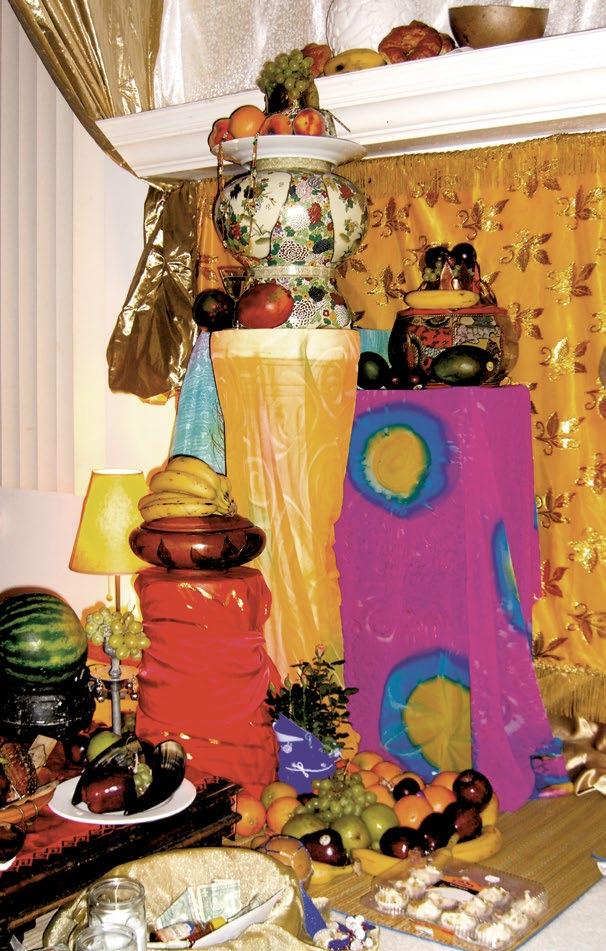
sheet cake to mark Ashabi’s “birthday”—her ritual rebirth in 1986 as an ordained priest of the deities called orishas
Her well-wishers enjoyed the equivalent of a Sunday supper: well-seasoned meat with fragrant rice, fluffy dinner rolls, and savory greens.
There would definitely have been clusters of grapes, apples, pears, pineapples, coconuts, and other fresh fruit on Elegguá’s altar. In a comic “salsa pop” number from 1991, “Mister Don’t Touch the Banana,” CubanAmerican musician Willy Chirino sets his song at a feast for Changó—the deity of thunder, justice, virility, and the drums— to whom the banana in question pertains. The song’s joke turns on a buttinsky’s obliviousness. “Tempted by folklore” and curiosity, he shows up uninvited and mistakes a display of sacred food for a buffet.
When the party-crasher snatches a piece of Changó’s favorite fruit, the host faints, one of the guests gets possessed, and another hops up to perform a cleansing rite. Their reactions are absurdly exaggerated, but a taboo has been violated.
The banana-grabber isn’t only ignorant of Changó’s divinity—he’s unaware of the intri-
cate etiquette that governs the orishas’ celebrations. Foods brought into contact with the orishas get charged with a vital primordial energy called ashé.
The first time I walked into Ashabi’s bungalow, I knew more than Chirino’s “Mr.,” but not much. I suspected that T.V. and movie portrayals of Santería were distorted to make “voodoo” seem savage and primal, the better to feed racist fantasies of African inferiority. I never asked myself what happened once the scenes of sacrifice were over.
Elegguá and Changó belong to a pantheon that probably did not accompany the first enslaved people to land on Cuban shores in 1518. They nevertheless became the dominant group of African spirits in Cuba. By the time devotees brought the orishas to the United States almost a century ago, they had been objects of legal prohibition and academic investigation. They went on to flourish in Puerto Rican and majority-immigrant communities in Miami and New York. In Chicago, the Lucumí tradition took hold after the Mariel boatlift of 1980, a mass emigration of over 125,000 Cubans.
Ashabi’s Havana-born mentor had arrived over a decade ear-
lier. I was fortunate beyond any expectation that the initiated elders of Ilé Laroye, a predominantly Black American house of worship, allowed me to observe and prepare for rituals in Ashabi’s home as part of my doctoral dissertation research. I wound up making food, and the centrality of the kitchen transformed the way I understood religion—including the role of women in it.
As in other transnational AfroDiasporic religions, every major Lucumí ceremony entails the preparation of dishes for the deities, ancestors, and other practitioners. Some Afro-Diasporic religions have deemed kitchen managers valuable enough to bestow official titles on them. In Lucumí, the most exalted term is alashé Afro-Diasporic gods have distinct preferences and aversions. For example, their sacred animals are differentiated by type, color, sex, and age. A complex mythological system explains why the orishas consume certain things or don’t—why, for example, a certain manifestation of the orisha Oshún abhors watercress and Oyá never eats ram (why, if truth be told, she never wants to catch even a whiff of its gamy odor).

Devotees nurture the orishas in order to be nourished morally and materially by them. Other gods and ancestors around the world want food, too. Of these, the orishas may bear the greatest resemblance to Hindu deities, with their penchant for sweets (and sometimes meat, as in the case of goddesses who receive chickens, goats, water buffaloes, and more). The two traditions also share a practice of giving foodstuffs to the deities and obtaining an edible blessing in return.
Most Lucumí culinary techniques derive from precolonial Yorùbáland (encompassing swathes of modern-day Nigeria and Bénin). In Chicago, practitioners benefit from the presence of West African markets on the South and North Sides. The members of Ilé Laroye shopped for ingredients on S. Commercial Ave. and E. 87th and E. 89th Streets, stacking their baskets to the brim with guinea pepper, red palm oil, plantains, frozen banana leaves, tubers prevalent in Caribbean cuisine (like cassava and malanga), white yam flour (iyan), and black-eyed pea flour (moin-moin).
Senior initiates trained newcomers to recognize and replicate the orishas’ favorite tastes.
Their menus feature plenty of corn, cornmeal and hominy, hinting at the indigenous contribution to Black Atlantic cultures. And the orishas’ craving for sugar tells a tale of racialized appetites in the Spanish colonial world. Even on the South Side, their desserts have tropical flair, like dulce de coco (coconut candy) and caramel flan. Although most members of Ilé Laroye hail from families propelled north during the Great Migration, the house ran on Cuban coffee, and the alashés poured their hearts into steaming platters of Puerto Rican arroz con gandules on special occasions.
The women of Ilé Laroye put the same love into plucking, butchering, and roasting for the orishas as their foremothers put into dressing “the gospel bird” and cooking other Church food.

Ashabi sometimes consulted the soul food stylings of The African-American Heritage Cookbook: Traditional Recipes & Fond Remembrances from Alabama’s Renowned Tuskegee Institute by Carolyn Quick Tillery. She also drew inspiration from her Caribbean travels to make jerk chicken, curry goat, and Jamaican escovitch fish. (I bragged to my fieldnotes once when my improvised garlic bread met with her approval, since being asked by Ashabi to cook was like having Yo-Yo Ma request a little dinner music.)
“Love offerings” for postritual repasts might be homemade peach cobbler, pound


cake, or Entenmann’s Louisiana Crunch Cake. But the most sumptuous meals were reserved for the orishas and visitors unaffiliated with Ilé Laroye. One of my earliest fieldnotes reads, “Everyone was hungry and wishing the food could be eaten but forget it!”
Cooking for elaborate rituals could be an agonizing task, making for sore hips, stiff necks, and hand cramps. Practitioners usually undertook it as labor of love after a full day of teaching, nursing, shopkeeping, bank-tellering, call-centering, or construction—to name a handful of occupations represented in Ilé Laroye.
And it wasn’t only cisgender women at the stove. As I write in Religion in the Kitchen: Cooking, Talking, and the Making of Black Atlantic Traditions (NYU Press, 2016), gay men have cooked alongside women and run sacred Lucumí kitchens. In fact, while no one would deny that the kitchen is women-centered—notwithstanding the presence of straight cisgender men—the “kitchenspaces” of Afro-Diasporic religions have been queer spaces where their most hallowed traditions are preserved and passed on.
A do-it-yourself approach to orisha worship has unfortunately become prevalent on social media and video hosting sites like YouTube. The senior members of Ilé Laroye would not condone any sharing of recipes that might encourage this DIY trend--and discourage seeking the guidance of initiated practitioners. For my own practice, I rely heavily on Miguel W. Ramos’ excellent Adimú: Gbogbo Tén’unjé Lukumí (Miami: eleda.org, 2012), and occasionally consult John Mason’s Ìdáná Fún Òrìsà (Brooklyn: Yorùbá
Theological Archministry, 1999). This recipe for oshínshín, one of Oshún’s favorite dishes, adjusts Ramos’ to my taste:
Ingredients:
5 eggs
2 cups spinach, collards, or chard
Half a yellow onion, chopped
5 cloves of garlic, minced
1 6-oz can of tomato paste
1 bay leaf
1 tablespoon dry white wine
¼ cup dried shrimp
Five (or more) raw, medium-sized shrimp
⅛ teaspoon sea salt
Black pepper, to taste
3 tablespoons of olive oil
A tablespoon of red palm oil, optional
Fresh cilantro
Instructions:
Rinse the greens thoroughly and set aside. Soak the dried shrimp in warm water (more than an hour is ideal). Shell and devein the fresh shrimp, making sure to remove the tails. In a bowl, whisk the eggs with a fork and stir in salt and pepper.

Heat the oils over medium heat in a medium saucepan. Add the bay leaf and cook until fragrant, 30 seconds. Add the onion, garlic, and dried shrimp and lower the heat. Cook until the onions are translucent, about 5 minutes. Stir in the tomato paste, wine, and greens. After the greens have wilted slightly, about three minutes, add the fresh shrimp and cook for about two more minutes; Ramos (1999, pgs. 63-64) cautions: “[A]llow a slight change in shrimp’s color, but do not allow them to become white to avoid overcooking them.” Pour beaten eggs over the other ingredients and press them gently against the greens to incorporate. Remove from heat since eggs will keep cooking in the hot pan. Keep nudging and turning over the mixture with your utensil (a spatula or wooden spoon) until the eggs look set yet moist, about five minutes. Garnish with cilantro.
I left Chicago in 2010. Since then, I’ve had the opportunity to work in sacred kitchens in Brooklyn and Los Angeles. These experiences bore out my book’s arguments about gay men’s stewardship of kitchenspaces. What I didn’t foresee is how the internet would come to normalize catering for the orishas as a culinary specialty.
In 2011, Nydia Pichardo (Ibae) debuted the Adimu Network, “the first video internet website dedicated to the preservation of Lukumi sacred food heritage.” With gorgeous photographs and instructional clips, it remains a rich informational resource. A much larger collection of videos can be viewed on YouTube, at the NydiasMiamiKitchen channel. Pichardo is the late wife of Obá Ernesto Pichardo, whose 1993 Supreme Court case won religious practitioners in the United States the right to perform animal sacrifice. Pichardo’s alchemical archive lives on after her tragically untimely death in 2019.
Just last year, I had the pleasure of meeting one professional alashé, Chef Joel “El Cangri,” after Ashabi raved about his cooking. I shadowed him in a tiny basement kitchen during an initiation (often called “ocha,” an abbreviation of kariocha). Based in New York, Chef Joel has an impressive Instagram and Facebook following based on his motivational messages and tutorials that showcase his culinary versatility. Joel proudly puts “Chef Alashe” and “Orishas Kitchen” on his business cards, alongside “Latin fusion food” and “Cocina [cuisine or kitchen] de Ocha.” How much higher can haute cuisine get when you’re cooking for the gods themselves?
Ed Marszewski is the busiest freak in town—he is the co-director of Public Media Institute (PMI), a nonprofit that publishes Lumpen Magazine, which is approaching its 30th anniversary. Other PMI programs include Co Prosperity, an experimental cultural (and art) center in Bridgeport, and Lumpen Radio. Alongside his mother Maria and brother Mike, he is the founder of a portfolio of celebrated eating and drinking brands, mostly located in Bridgeport—Maria’s Packaged Goods & Community Bar, Kimski, Marz Brewing, and Pizza Fried Chicken Ice Cream.
I’ve been a big fan of Ed Mar (as he’s known around town) since I first picked up issues of Lumpen as an impressionable teenaged freak in the mid-90s, drawn to it’s lefty gonzo journalism and trippy art and design. During the Iraq War years, I marched behind a megaphone-touting Ed Mar down Michigan Avenue, protesting against global capitalism. We became comrades a decade later, co-organizing the MDW Fair, an alternative art fair showcasing independent art spaces from around the country. I had the pleasure of Zooming with him recently over a couple of cold ones—rapping with Ed is just as head spinning as his ambition to take on new projects. Somehow in 90 minutes we forgot to talk about the radio station, his “Buddy” store at the Chicago Cultural Center, or his new tie dye clothing line. It would truly take an entire issue of this newspaper to capture the multitudes that are Ed Mar.
butors each week. And that’s why we had this nice diversity of voices and people.

So we started seeing what all these different chefs were doing in the Quarantine Times—making meal kits and feeding industry workers, and we decided since our kitchens were closed, let’s reopen the kitchens, let’s employ some people and make food for the neighbors. We found out the senior citizens’ homes, their kitchens closed because everyone was quarantined to their rooms. The food pantries, they needed meals. And our whole thing was we pay people to work, we pay them good wages, and we source what we usually source—local produce, local farms, local supplies, whenever possible, all local stuff to give them money, and then we deliver and bring the food to the constituents. And bring them really healthy, awesome farmto-senior-citizen home meals.
Eric: I feel like you’re ideally positioned to be the person that does this. On one hand you’ve got the organizing roots and then you’ve got the businesses, the infrastructure. And you also know everybody. And I was curious what community groups you were working with?
mes” and found a house for rent around the corner and moved into it at Armitage and Rockwell.
Eric: And you’re about to reemerge there. So you have some love for the Northside?
Ed: Of course I chose to open up another Marz Brewery a block and a half away from my first house in Chicago. Yeah I always love the Northside, if it wasn’t for Quimby’s and Myopic and Wicker Park, the whole scene of amazing people—throw a rock and you know someone, I mean the internet was the street, right? Those third places got me convinced that doing these things may be worthwhile and then deluded myself to keep doing them forever.
Eric : When were the Buddy Years? I wasn’t a regular but I remember some sweaty dance parties and I remember coming to a Food Not Bombs event and maybe a stencil-making workshop. Back then I didn’t totally understand what Buddy was. At that point, art, to me, belonged to stuffy elite spaces. And people called Buddy an art space but I’d go there and it was like a squat.
Eric: The name changed to Maria’s when you rehabbed? When was that?
Ed: It was Kaplan’s until 2010 when my brother and I took over managing it and called it Maria’s Packaged Goods.
Eric: One of my big questions is there’s Ed the activist, the Edmar I was first exposed to. But then you’ve got the entrepreneurial thing. Do those things square up?
Ed: Well you know, the joke I tell people is that I’ve become the person I hated in my 20s. But at the same time it’s probably better I was who I was in my 20s— I have more empathy for a lot of different things most capitalist dudes wouldn’t be interested in.
But also, when you’re an activist you have no resources. But we didn’t have any real budget when we changed up Maria’s. It was Charlie (Vinz), he used some reclaimed wood. My wife designed the chandeliers. My brother laid the floor. I painted, we all did the work to start that.
Eventually when you have passion, people care and they notice. As you know Maria’s became globally famous for being one of the best bars in America. We were in these tv shows that called us the best bar in America, twice! Every magazine on earth heralded our craft beers and cocktail stuff. And of course Maria, herself, getting the recognition she deserved decades earlier as being this woman who was welcoming to all people and made everyone feel safe in her dive bar, regardless of the color of your skin or class, you know.
Eric: What about the “Community to the Future” concept. You use the term community a lot.



Eric May: You’ve got a couple of milestones coming up—the one year anniversary of the Quarantine Times and I saw that the Community Canteen is wrapping up.
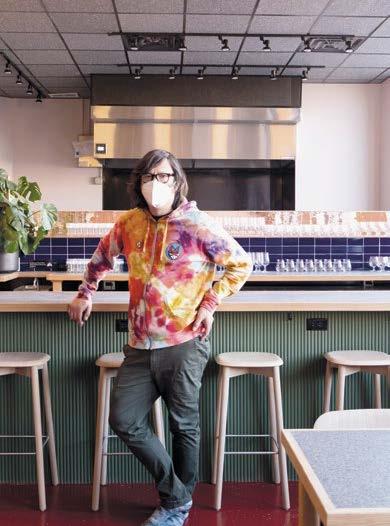
Ed Marzewski: Yeah the Community Canteen at Kimski will be closing this week. Basically we don’t have enough funding to make 4000 meals a week anymore.
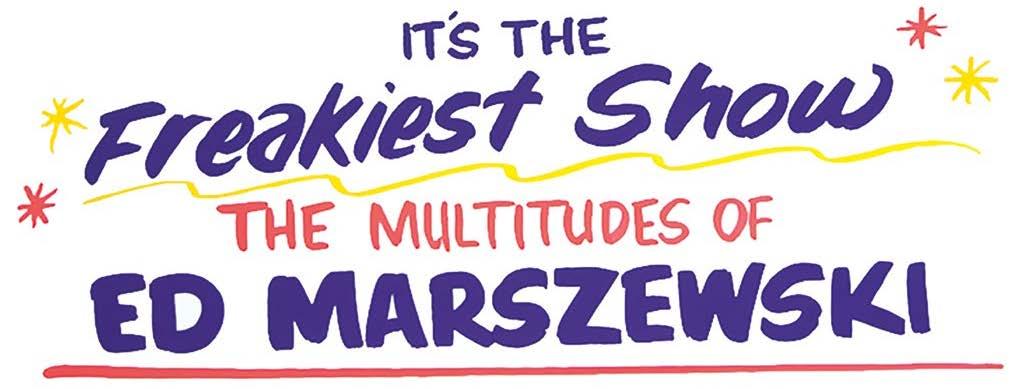

We are still asking different foundations for money to keep the program going in some fashion. But we’re cutting off Kimski, because it might re-open. Wherewithal will be going for another month or so.
Most of the people are going for another month or so. And then after that we’ll probably continue to make 300-600 meals out of Kimski and Marz and I’ll just pay for it. But yeah, the Quarantine Times book just came out. It’s a pretty great document of how freaked out everybody was. When the shutdown happened, Nick and I were like, shit, we’re gonna have to cancel all the shows for a couple of months. We had some funding allocated for those shows and we’re all freaking out and, like, what can we do? So lets start this project and pay everyone who contributes to it. Because you know most artists are precarity workers—they’re doing multiple gigs—bartenders or waiters or catering, right? The point was, how can we provide some relief.
We were engaged with some foundations at that point and they’re like “this sounds like a great project, let’s help you out for a month.” Like yeah, we’ll be done in a month, it’ll be fine. And then it’s like, this is neverending! And they actually reupped a couple times. We were able to pay people, I mean, over $100,000. The idea was to have all creative industry workers, including chefs, bartenders, hospitality industry, as well as musicians, artists of all stripes, performers, activists, talk about what they were doing. And we selected seven editors to each select different contri-

Ed: Yeah the infrastructure, this would not have happened if we didn’t have these kitchens to use immediately. So if we didn’t have Marz or Kimski this program wouldn’t have happened as quickly or robustly. I actually asked our state rep, Teresa Mah, which orgs need help now? And she put us in touch with a few. And some other orgs contacted us and we started doing food for them. And then of course the Love Fridge started and we started putting meals in the Love Fridges. And then the Döner Men were doing their own thing and we were like, hey man why don’t you do this with us? We’ll try to get some more funding and pay you to do the meals. So let’s throw all this coin we get into these programs and try to help as many people as we can. Mom’s on Marz came and started doing stuff. And then we expanded to Iyanze, that West African restaurant. I mentioned it to the First Ward and they set us up with some senior citizen homes. We started providing food for Esperanza school and transitional housing. And we’re working with an organization in Englewood that’s not a food pantry, but an interventionist group—whenever a shooting happens they come out and talk to the neighbors, try to cool things down and they do it by providing meals and invite everyone to come out and talk. It’s a really unique way of utilizing food to start a conversation or provide some relief, just nourishment to people who are traumatized.
Eric: So we’re kind of going backwards through my questions, but I do want to go back in time, since I’ve been a fan of yours since high school.
Ed: The 60s!
Eric: So, you grew up in Bridgeport?
Ed: No, no one’s from Bridgeport. Unfortunately due to poor reporting all over the universe, people just assumed we grew up in Bridgeport. So I’m glad we’re getting the truth. I actually grew up in Evergreen Park, but my family moved when I was nine or ten to Downers Grove, I went to high school there. And went to University of Illinois for art school but dropped out and went into political science. I thought I’d become a lawyer, but instead I believed in alternative journalism.
Eric: So was Lumpen Magazine based in Wicker Park in the early days?





Ed: After I moved out of Champaign, I moved home briefly, got a job at a brewery, and got fired for trying to form a union. I
Ed: A dump! Well it’s true. That was 2002-2005. I think we did about 100 events a year, it was insane. Every Wednesday was improvised lotto. There were rooftop parties and BBQs. That space, there were always 8-10 people living there, it was really tough. And maybe that was the Freedom Festival. We had a three or four day festival—the Food Not Bombs, a fashion show, lots of workshops and talks and parties. It was an interesting approach, getting hipster kids to become activists. I remember we held Version Fest during the Iraq War and a thousand people were arrested in front of the MCA building. And the public interventions like the Chicago Art parade where we decided to have a parade and hundreds of artists showed up.
Eric: Is that when you marched on the Merchandise Mart?


Ed: No, that was the art war. That was a different thing. We attacked by land, sea, and air.
Eric: Did I ever tell you the anecdote about that—the 1st year at NEXT Fair, Kavi Gupta called me up and had a meeting with me and said “I’m worried about this Edmar guy” and asked me to keep an eye on you. I must have done a shitty job, because, of course, the guillotine...
Ed: Yeah the guillotine. That was an incredible day. The art war was organized in the CoPro. We had people actually do surveillance of the entire area around the Merchandise Mart. Some artists made effigies, like Chris Kennedy, that got beheaded by the artists with a neon guillotine in a pick up truck. We had a phalanx of Roman soldiers. We had a catapult. And dozens of people in Critical Mass on tall bikes dressed up like knights with lances, they came through, they provided us the cover to escape. There was a flotilla of shitty boats. The blimp broke and didn’t launch for the air attack. And there were a hundred people doing pillow fights. We were catapulting stuffed animals and water balloons against the building. And then other people showed up, artists came out and attacked us with paint bombs.
Eric: Back to Bridgeport—you and your brother started helping your mom out at some point.
Ed: Oh we always worked. My mother had a Korean and Japanese restaurant called the House of Kim at 109th and Harlem, in a strip mall. So I worked there as a teenager. My mother built a beautiful restaurant with a pond, a turtle, koi fish. She had traditional Korean tea rooms with the wood and paper doors. You could sit on the floor to eat. She grilled kalbi at the table. She had a banquet hall, there was a sushi bar. She then had a beauty shop. We’ve always worked for her.

Eric: So she’s a real entrepreneur.
Ed: Yeah, and so was my father. He was a butcher. He had the bar. My mother took over the bar when my father passed away. That was the 80s. I was a bar baby.
Ed: So, 2005 the White Sox are about to win the world series—a New York Times journalist comes into the bar to interview me about the neighborhood. One of the quotes of that article is me saying Bridgeport is the community of the future, if the future is the apocalypse. At that point, the apocalypse referred to the lily white, racist, white supremacist shithole that Bridgeport was, right? The black hole of segregation. So that’s really the apocalypse part—bemoaning the bad parts of Bridgeport. We started imagining what we wanted to see in the neighborhood—it was about like, wow lets queer the fuck out of Bridgeport by having more freaks and artists move in.
One of our first media festivals here, the subtitle was “Bridgeport, Community of the Future” with the Bridgecot Center as its icon, the Epcot Center hovering over a bunch of two flats. It was that interplay between it being a rough and shitty neighborhood and us being idealistic artists trying to be open minded. After Buddy, we had to get another space and


that’s how we wound up in Co-Prosperity. We were looking all over the place and this random customer at my mom’s bar who I’d see Monday nights when I worked said, “Eddie, I want to sell the building down the block.” Like which one, the one with all the shit in the window that’s been abandoned for 20 years? So I bought this abandoned building. It’s always been great to be down here because it’s affordable, there’s a lot of space, there’s a lot of room for things to happen that you probably couldn’t afford to do north of Roosevelt Road, you know what I mean?
Eric: I remember the first brewery you guys had set up down on Halsted. You were already making delicious beer back then.
Ed: Down on Halsted, right, the little tiny three barrel set up. That was 2013-2016. It was pretty good beer. I mean for being hand bottled with fucking CO. We were completely bonkers.
Eric: I see all your beers in Binny’s out here in the burbs. It’s like artwork on the shelf – it’s awesome to see Jacob Ciocci art out here. So going back to the use of the word “community,” I wonder what does community mean on a beer label in a big store in Geneva, Illinois?
Ed: Right. When we started doing the brewery naturally we were working with our friends who were artists and designers and weirdos. All these things are distributing ideas—the beer can, the brewery, the gallery, the magazine, and the radio – it’s all amplifying interesting ideas and stuff that matters to us and hopefully to make other people care about. That vibe, working with artists and weirdos and freaks is hopefully prevalent in most of the things we’re doing.
Eric : Do you have hope for what’s next as we emerge from this dark winter we’ve just faced?
Ed: Absolutely man, living through this year obviously in some ways chilled me out a lot and then also made me believe we’re going to do whatever the hell we can do and just go for it—do things I’ve been wanting to do for years, we’re just going to do it, I’m not going to regret things anymore. And how do we help people have opportunities that they wouldn’t have normally? Hopefully things work out.
Who invented Chicago deepdish pizza? Is there a more controversial question in Chicago food history? Despite decades of debate and speculation, no one has definitively identified who created the pizza style that has—rightly or wrongly— branded Chicago as a deep-dish pizza town with a market niche now worth hundreds of millions of dollars.
I was reminded of this question 12 years ago reading the title “Mysteries of the Deep” on the cover of a tabloid newspaper.
The article, written by Chicago Tribune reporter James Janega, described the efforts of Tim Samuelson, then Chicago’s official cultural historian, to find the inventor of deep-dish pizza. Tim lamented, “I wish that there were more written records—recipes or vintage photographs.”
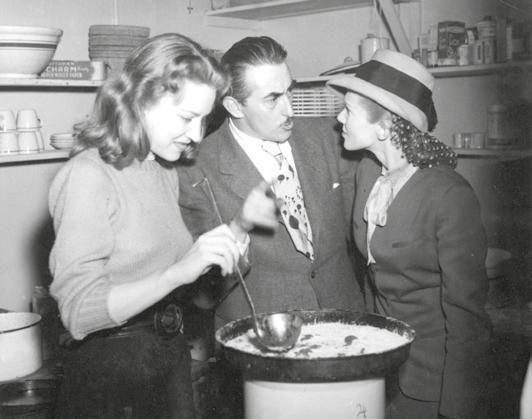
I was immediately intrigued.
After reading the article, I met with Tim and agreed to try my hand at finding more information to help us solve this decades-old mystery.
Before we look at this deep-dish whodunit, let’s establish some historical context regarding the pizza business. The first documented pizzerias in the world appeared in Naples in the late 1700s. In the U.S. the first known pizzeria appeared in New York City in 1894 on Mulberry Street.

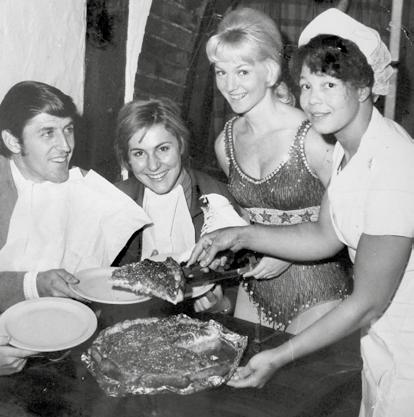
It wasn’t until 1924 that Tom Granato established Chicago’s first verified pizzeria, on Taylor Street. Granato’s pizza, cooked in a wood-fired oven, looked like a New York-style pizza with its wedge-cut thin crust. With the repeal of prohibition, pizza started to become popular in ItalianAmerican taverns on the east coast in the mid-1930s. The idea of serving pizza in taverns as an accompaniment to drinks eventually made its way to Chicago
By Peter Regas
in the early 1940s. Hence the dominant pizza in Chicago is a thin cracker crust sliced with a square “tavern cut.”


Now back to the deep-dish story. Let’s define deep-dish pizza as a pizza cooked in a circular pan, sauce on top of the cheese, and a modestly thick crust that’s rich in fat. Typically the fat used in the dough and in the pan is a mixture of olive oil and corn oil. There’s little doubt the pizzeria at 29 East Ohio Street in Chicago—ori-
ginally named “The Pizzeria,”
later renamed “Pizzeria Uno”— served the original deep-dish pizza in December 1943. The main controversy is who created the original deep-dish pizza: Ike Sewell, a Chicago-based liquor manufacturing executive, Richard Riccardo Sr., a famous Rush Street restaurateur, or Rudy Malnati Sr., Pizzeria Uno’s longtime manager.
To tell your story, it helps to be alive to recount it. In this case, Riccardo, a part-owner of the pizzeria, died young in 1954. By contrast, Sewell died in 1990 in his late eighties as Pizzeria Uno’s owner. As a result, Sewell’s origin story became the dominant narrative in newspaper articles on the early days of deep-dish pizza. Briefly, Sewell’s story was as follows: Born in Texas, Sewell had a longtime dream to open a Mexican restaurant in Chicago. He approached Riccardo in early 1943 with the idea and formed a partnership. Sewell found an abandoned basement tavern at 29 East Ohio Street and, by June 17, 1943, they had leased it. Eventually, Riccardo, an Italian by birth unfamiliar with Mexican food, wanted a meal to taste before they opened the restaurant. After eating an authentic Mexican meal
prepared by one of his Rush Street bartenders, Riccardo got violently ill. Angered by the experience, Riccardo stormed off to Italy for two or three months. Eventually, Riccardo came back from Italy with a new idea for Sewell: pizza. But Sewell had no idea what pizza was. They tried to order one at the only pizzeria in Chicago on Taylor Street, but the owner told them he only makes pizzas for parties. Riccardo, a longtime cook, then went into his kitchen and started experimenting with pizza recipes. Sewell’s only input to the recipe was to tell Riccardo to “make it a meal” instead of an appetizer. Finally, they opened their pizzeria with Rudy Malnati Sr. as the manager in December 1943. After Sewell retired from the liquor industry in 1966, he told various versions of this story to the media until his death in 1990. And that was that.
Until one day in 1998, when Riccardo’s ex-wife, Mae Juel Allen, called Chicago Magazine’s Jeff Ruby and told a very different story. According to Mae Juel, “Ike Sewell didn’t know beans about deepdish pizza.” She went further and said Sewell wasn’t present when Riccardo hatched his pizza idea in 1943. In another unpublished interview I reviewed, Mae Juel said wartime liquor shortages caused them to form the partnership with Ike only after the pizzeria was already open, stating, “We only had Ike because he was in the liquor business. And we needed the liquor. It’s that simple.”
Since both sources are now dead, the only way to assess who’s telling the truth is to find as many primary sources as possible and see whose story is consistent with those sources. And so, on and off for the last 12 years, that’s what I’ve done often with Tim Samuelson’s invaluable help.

My research largely supports Mae Juel’s version of events and finds Sewell’s origin story implausible and at times outright false. For example, I found all the Chicago liquor license applications for 29 East Ohio Street for the period 19391955. The critical application was the first one signed by Richard Riccardo on November 15, 1943. Riccardo explicitly states on that application he has no partners. This directly contradicts Sewell’s story that they bought the tavern business and leased the space by June 17, 1943. I was also able to find the original partnership agreement between Riccardo and Sewell (actually, Sewell’s wife signed for him). The most interesting thing about the agreement is
it was signed on February 15, 1944, almost eight months aft er Sewell said they bought the tavern business and their lease started. Why would you wait eight months to sign a partnership agreement after—according to Sewell—committing capital to the partnership?

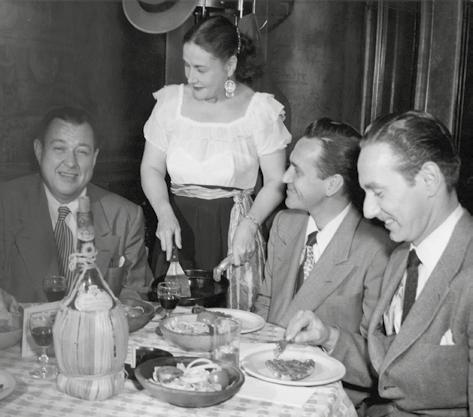
In addition, liquor license applications show the original manager was not Rudy Malnati Sr., as Sewell said, but Riccardo’s cousin Bartolomeo Fico. It turns
original deep-dish recipe was very likely the sole creation of Riccardo.



Is the pizza served today substantially the same deep-dish pizza served when Riccardo opened in the 1940s? There are reasons to doubt it. I found photos of Pizzeria Uno’s deep-dish pizzas from 1949, which show pizzas made in a shallower pan looking noticeably thinner than today’s deep-dish pizza. Additionally, in 1945, Riccardo gave newspapers a deep-dish pizza recipe that has approximately half the fat compared to Pizzeria Uno’s current dough. This lends credence to the story that legendary Uno pizza cook Alice Mae Redmond told the Chicago Sun-Times in 1989: “When I came to Uno’s the dough was terrible… It wouldn’t stretch.”
So she said she developed her own recipe. My interviews with her now-late daughter Lucille Conwell confirm Alice Mae likely added more fat to the recipe making it easier to stretch.
out Rudy Malnati Sr. was the pizzeria’s third manager taking over in 1951. Also, telephone books and a birth certificate establish the Riccardo family moved into 29 East Ohio Street in late 1942, renting an apartment right above the then abandoned basement tavern. Is it credible that Sewell discovered the basement tavern Riccardo was already living right above?
Remember that pizzeria on Taylor Street in 1943 Sewell claimed would only make pizza for “parties”? The only known pizzeria at that time on Taylor Street was Tom Granato’s pizzeria. Tom’s daughter, Marion Simone, turns ninety-three this June and has clear memories of the pizzeria in the early 1940s. She told me Sewell’s claim was “absolutely not” true. Finally, Sewell claims Riccardo went to Italy during the summer of 1943 for two or three months.
Sewell was a highly respected Chicagoan but he really told a whopper here. The only way for an American to go to Italy in the summer of 1943 was to invade Italy with the U.S. Armed Forces. For the record, Riccardo never served in the U.S. Armed Forces, and there is no record of him leaving North America du ring the war.
Based on all of these sources, I believe Sewell’s origin story for Pizzeria Uno is substantially untrue. Crucially, I don’t think Sewell was Riccardo’s partner when Riccardo initially opened the pizzeria in December 1943.
And if that’s the case, then the

Where did Riccardo get the idea to open up the pizzeria? A 1954 Sun-Times article states that Pizzeria Uno was established “... to satisfy pizza lovers who complained because Riccardo’s [on Rush St.] didn’t serve their favorite dish…” That seems plausible as tavern pizza was booming on the east coast in 1943. But a more intriguing reason may be the abandoned tavern Riccardo bought in 1943 called “The Pelican” was also a pizzeria, at least from 1940 to 1941. Riccardo may have simply reopened an abandoned pizzeria with pizza ovens and possibly deep-dish pans still there.
All of this revisionist history doesn’t mean Sewell and Malnati were not critical to Pizzeria Uno’s success. Contingency in history leads to some interesting counterfactuals. Would Riccardo’s pizzeria have survived those early months without Sewell and the extra liquor he allegedly supplied? Would another manager have been as successful as Rudy Malnati Sr. was for more than two decades?
Would Riccardo have opened a pizzeria if “The Pelican” had not previously introduced pizza at the little basement tavern at 29 East Ohio Street? Researching old questions leads to new questions. The mystery
By Eric May


It took me 29 years to make my first cake. It was a carrot cake slathered with pre-whipped cream cheese from Trader Joe’s, mixed with raspberries and sugar. It was meant to be a birthday cake of sorts—a joint birthday between my partner Cody and our close friend Jeff.The cake was as much about their year around the sun as it was about their friendship. I liked the sound of it—friendship cake. I began to make more and more cakes for friends—a reason to say hello, an excuse to drop by, to meet up, to eat together and catch up. I started a journal, piles of notes and colorful doodles full of flavor combinations and recipes. This was how Dream Cake Test Kitchen began.
orange olive oil cake with ginger syrup, candied ginger, orange zest, lemon zest, lime zest, and chinese five spice
It’s important to hold on to the friendships we have, the small moments that bring us together. Sometimes people move away, some even leave us forever. It is a sad thing to lose someone, and maybe we can cherish even the smallest moments we have together, even if it is over a slice of cake. I think there is something about being in your 30s that makes the reality of time feel so much more apparent. Some of us are getting married, starting families, settling down, looking for jobs in other cities. There is little stillness in the quiet chaos of our daily lives and there is something in me that hopes to savor each morsel of a moment.
goat milk sponge with a drizzle of coffee icing, a dollop of basil whipped cream,strawberries, red currants, black raspberries, and nasturtium leaves

A cake carries significance. It can be the crown jewel (the cherry on top) of a momentous occasion. But sometimes a single slice can say “hey we haven’t talked in a while, are you free on Friday?”


A single layer cake can be ca-




us of the forgotten joys that linger under the bitterness. If an ything, a slice of cake brings us comfort at the end of a long day, especially when that slice is shared.



Cakes are a landscape for the dreams we carry. My cakes usually embody the natural world and its many wonders—piped buttercream butterflies dancing in the summer breeze, swirls of mascarpone and cream anchoring down forests of rosemary and lavender sprigs, lazy lakes of raspberry jam dotted with dried rose petal boats and glistening gold leaf flecks. Some cakes become a mountain or a hillside, some an ornate palace freckled with bee pollen. A single line of black sesame seeds can become a procession of ants marching under the hot sun.

Most recently, I dreamed of swans bathed in light. Gathered together on the water, their smooth white curves were radiant, haloed by thousands of sunlit refractions dancing on the surface of the water. The image was burned in my mind, and the next day I found myself drawing swans with piped meringue, gently teasing feathery peaks into their foamy egg white bodies. They soon surrounded a buttercream cake with a lemon curd pond on top. Sometimes dreams are meant to be shared.